A team of scientists at Syracuse University has found this amazing capability exists inside a device called an oscillating heat pipe (OHP), in which ordinary liquids like water can move heat very effectively. Scientists have been building OHPs for years, but it has been difficult to measure exactly how much heat the liquid itself can carry.
College of Engineering and Computer Science
Professor Bryan S. Kim Named as Inaugural Varshney Faculty Fellow
The College of Engineering and Computer Science (ECS) is proud to announce the selection of Bryan S. Kim as the inaugural Pramod and Anju Varshney Endowed Faculty Fellow. This endowed fellowship is made possible through a generous gift by Distinguished Professor Pramod K. Varshney and his late wife, Anju Varshney G’86, G’90.
Studying Mercury Contamination in Waterways: Charan Jaggena ’28
Through his two-year SOURCE fellowship, Jaggena will work with both Professor Aaron Mohammed and Professor Todorova to study mercury contamination in waterways.
Electrical Engineering and Computer Science Students and Faculty Showcase Quantum Technology
Students and faculty from the College of Engineering and Computer Science attended the 2025 National Advanced Technological Education (ATE) Principal Investigators’ Conference in Washington, D.C.
Helping Engineering and Computer Science Students Succeed: Celebrating 30 Years of Academic Excellence Workshops
The College of Engineering and Computer Science (ECS) celebrates its 30th year offering Academic Excellence Workshops (AEWs) to help undergraduate students succeed in their coursework.
Electrical Engineering and Computer Science Department Chair Alex K. Jones Recognized by IEEE for Academic Innovation
Professor Jones was selected as a 2025 recipient of IEEE’s Technological Innovation Academic Award for his work in novel device technologies, sustainable computing, and embodied energy optimization.
Mechanical and Aerospace Engineering Professor Bing Dong Advances Smart Building Research as a Visiting Scholar at Harvard University
Professor Dong is spending the semester as a Visiting Scholar in Electrical Engineering at the Harvard John A. Paulson School of Engineering and Applied Sciences.
Syracuse University and University of North Carolina at Chapel Hill Receive National Institutes of Health Grant to Study Bone Regeneration
Biomedical and Chemical Engineering Professor Pranav Soman is part of a team that received a notable grant from the National Institutes of Health (NIH) to study how a phytochemical found in citrus fruits affects the treatment of bone defects.
Civil and Environmental Engineering Professor Yizhi Liu Receives Foundational Research in Robotics Award from National Science Foundation
Yizhi Liu, Assistant Professor in the Department of Civil and Environmental Engineering (CEE), has been awarded a grant from the National Science Foundation (NSF) to design an AI-enabled robot that can conduct safe, efficient roof inspections.
Dean J. Cole Smith Named Executive Vice President for Academic Affairs and Provost at Clemson University
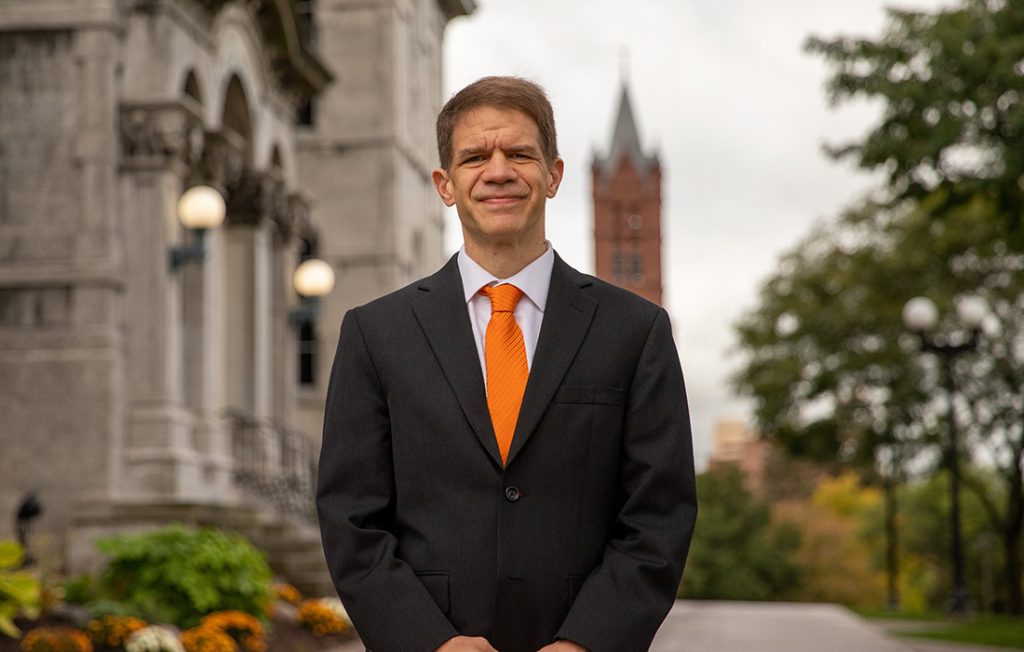
Engineering and Computer Science (ECS) Dean J. Cole Smith has been appointed as the new executive vice president for academic affairs and provost at Clemson University. Smith received his undergraduate degree from Clemson and previously served as associate provost for academic initiatives and chair of the department of industrial engineering at Clemson from 2014 to 2019.
Smith has served as the dean of Syracuse University’s College of Engineering and Computer Science since 2019 and will begin his new role at Clemson on January 1st, 2026.
During his tenure at Syracuse University, Smith led ECS through major renovation projects to modernize facilities, create multiple new lab spaces and establish the Allyn Innovation Center. He also helped secure a $2 million gift to support the Campos Student Center in the Center for Science and Technology. Smith oversaw the creation of the Center for Advanced Semiconductor Manufacturing, an interdisciplinary initiative uniting expertise in artificial intelligence, cybersecurity, robotics, optimization and manufacturing processes to advance semiconductor science that will open later in 2025. In addition, he helped launch a new master’s program in operations research and system analytics and a signature co-op program to expand experiential learning opportunities.
“My six years here at Syracuse have been more fulfilling than I ever could have asked for,” said Smith. “We have great days ahead for our education, research, scholarship, and impact in the region, and I am eager to see how this College will make the most of these opportunities. I want to thank the entire ECS family — our students, faculty and staff, plus our alumni, friends, and parents — all of the encouragement, counsel, and friendship I’ve received during my time here.”
Civil and Environmental Engineering Professor Baris Salman Receives National Academies of Sciences, Engineering, and Medicine Grants
Salman and his research team have received two grants from the National Academies of Sciences, Engineering, and Medicine. These grants will allow them to help the state Departments of Transportation (DOTs) improve how highways, bridges, and other infrastructure are built and managed. The team will focus on identifying best practices as well as developing new approaches to contribute to the field of civil engineering and better meet state DOTs’ specific needs.
Electrical Engineering and Computer Science Professor Moamer Hasanovic Receives NSF Award for Quantum and Semiconductor Workforce Development
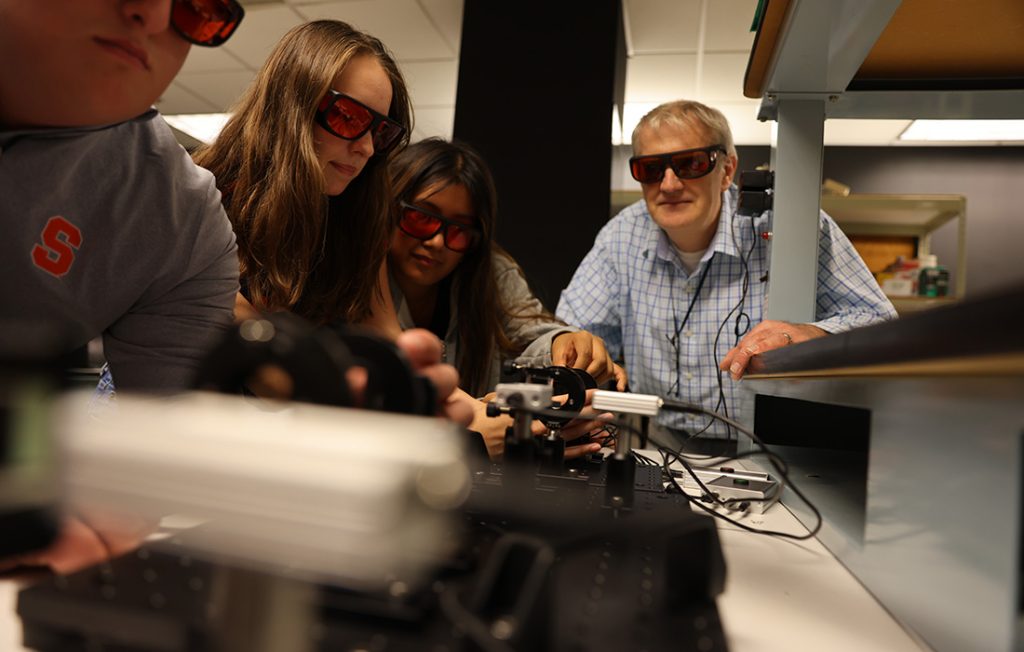
Moamer Hasanovic, Assistant Teaching Professor in the Department of Electrical Engineering and Computer Science, has received a National Science Foundation (NSF) Experiential Learning for Emerging and Novel Technologies (ExLENT) award for quantum and semiconductor upskilling. Hasanovic will develop an education program to give adult learners hands-on preparation for semiconductor, optics, and quantum technology careers.
NSF’s ExLENT program is designed to support experiential learning opportunities in emerging technology fields. The program is especially focused on eliminating barriers to STEM education for adult learners by providing training programs that lead to new career pathways.
Professor Hasanovic’s program, Quantum and Semiconductor Upskilling for Career Change through Experiential Education Deployment in Central New York (Q-SUCCEED-CNY) will span over six semesters and offer training on specific technologies, interactive demonstrations, industry talks, and mentorship. Workshops will take place in the evenings and on weekends to accommodate working adults. Each semester-long cohort program will conclude with a five-day immersive bootcamp covering topics like clean room protocols, semiconductor processes, optical measurements, and laser applications.
“This was truly a collaborative effort, and I express my deepest gratitude to all the internal and external partners who contributed to this proposal,” says Hasanovic. “I look forward to working with them – not only on this project, but on future efforts that aim to build a stronger regional tech workforce. By connecting adult learners with emerging technologies and real industry pathways, we’re not just preparing individuals for new careers – we’re investing in the long-term economic strength and innovation potential of Central New York.”
“This award strengthens Syracuse University’s growing leadership in semiconductor and quantum education and research,” says Alex K. Jones, Klaus Schroder Endowed Professor and Chair of Electrical Engineering and Computer Science. “Alongside our increasingly recognized activities in areas such as artificial intelligence and wireless communications, Professor Hasanovic’s program further positions the University at the forefront of innovation in the nation’s most critical technologies.”
Hasanovic has extensive experience in teaching and program development for quantum-enabled technologies, as well as a long career in radio-frequency engineering and design. Q-SUCCEED-CNY builds on the success of EdQuantum, an NSF-funded curriculum Hasanovic created for photonics technicians, and other Syracuse University programs for semiconductor workforce training.
In addition to creating the EdQuantum program, Hasanovic has authored several electrical engineering textbooks and manuals. With both a PhD in Electrical Engineering and an MBA from Syracuse University, he is uniquely equipped to develop collaborations between industry and academia.
Hasanovic will lead Q-SUCCEED-CNY as Principal Investigator (PI), with support from Jones and Professor Prasanta K. Ghosh as Co-PIs. The program is an interdisciplinary effort, integrating career coaching through the College of Professional Studies, and will also leverage partnerships with Onondaga Community College, the Manufacturers Association of Central New York, Jubilee Homes, Westcott Community Center, and other regional businesses and community-based organizations.
Mechanical and Aerospace Engineering Professor Anupam Pandey Receives NSF Award for Adhesion of Patterned Films on Ultra-Soft Solids Research
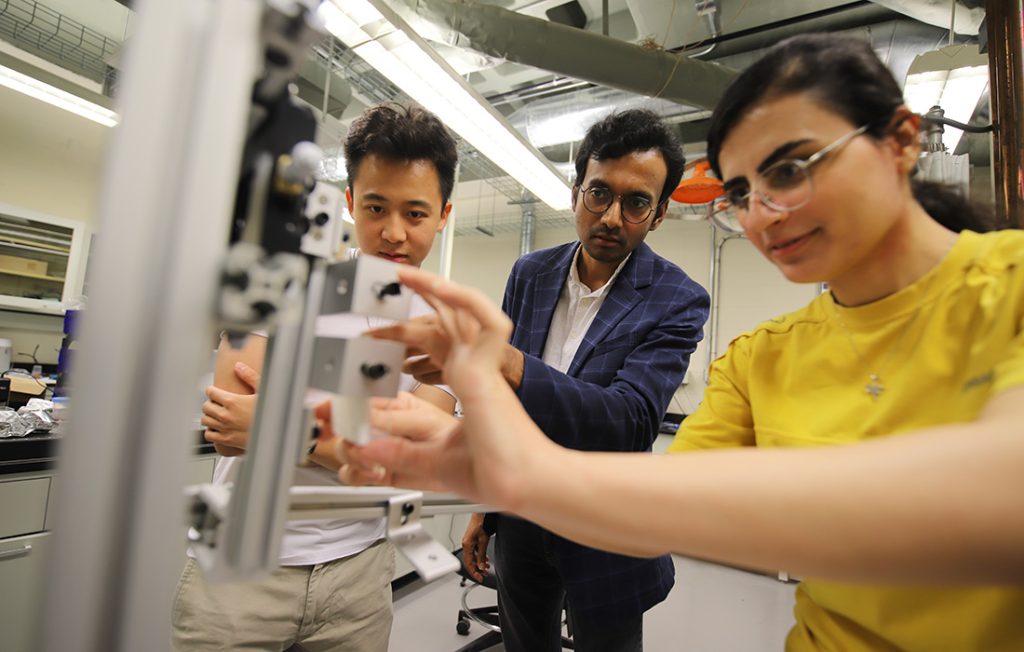
Mechanical and Aerospace Engineering Professor Anupam Pandey has received a National Science Foundation (NSF) grant to establish new strategies for controlling adhesion in ultra-soft and stretchable materials. His project will study how different types of materials stick together by examining thin materials that are partly attached to soft surfaces.
Small air pockets, or blisters, often form when surfaces don’t stick together properly, as seen in smartphone screen protectors or laminated materials. When these blisters are peeled away, one region may detach while another reattaches by itself in a unique transition described as peeling-to-rolling. This process causes noticeable changes in how strongly the surfaces stick together and involves complex interactions that existing methods can’t explain.
Pandey’s project will use analytical models and numerical simulations to understand how the peel-to-roll changes the way objects detach and causes sudden changes in the force needed to pull them apart. Additionally, the research will explore how the shape and arrangement of the air pockets can be engineered to actively control adhesion at the interface.
The findings aim to improve our understanding of how soft materials stick together in tight spaces and help design better soft interfaces for use in medical adhesives, flexible electronics, and soft robotics. To share this work, Pandey and his research team will host activities like a hands-on “Sticky Tapes” exhibit for kids, a summer workshop for high school students, and opportunities for undergraduates to get involved with research.
“This award gives us an exciting opportunity to uncover the mechanics of adhesion of blistered films on soft and stretchable materials,” says Pandey. “I’m eager to see how these insights will inspire both new science and practical applications.”
Electrical Engineering and Computer Science Professor Pankaj Jha Receives Air Force Research Laboratory Grant to Build Filters Using Quantum Defects
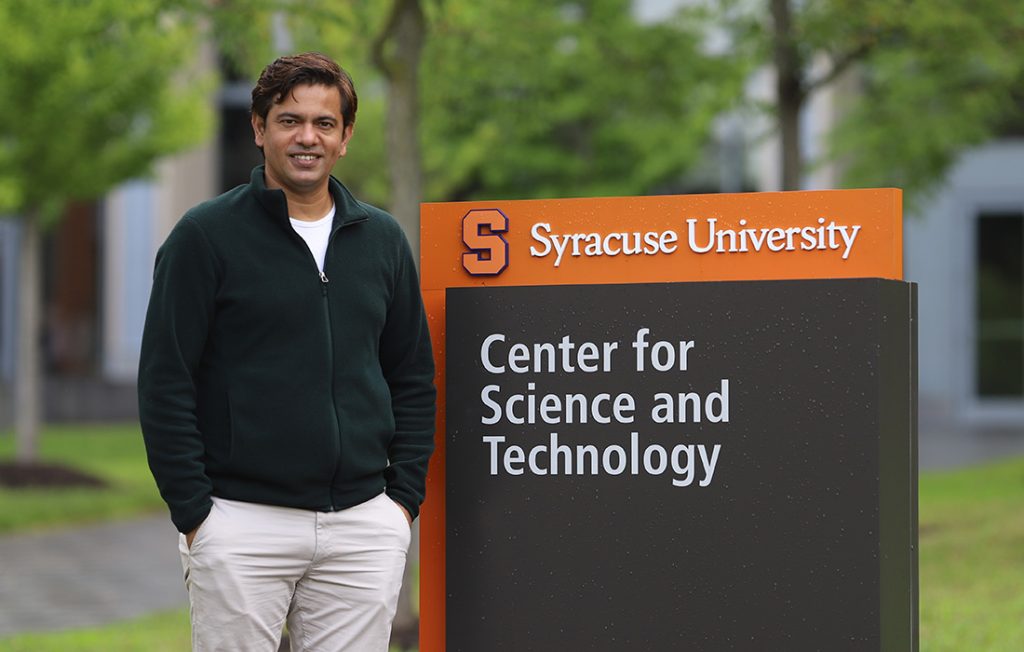
Electrical Engineering and Computer Science Professor Pankaj Jha has received a grant from the United States Air Force Research Laboratory (AFRL) to develop an absorptive atomic resonance filter (ARF) that can detect weak optical signals even in the presence of strong background (thermal/optical) noise. The filters that Jha will develop will have a sub-100 megahertz bandwidth, be electrically tunable across the sub-terahertz range, and provide sub-gigahertz speed.
An absorptive ARF is a type of filter in which a material strongly absorbs a narrow band of light, such as light resonant with an atomic transition. This absorbed light is then re-emitted at a longer wavelength, and by monitoring this re-emitted light, an ARF can separate weak optical signals from a large background.
In contrast to previous atomic filters, Jha and his team will use “atom-like” quantum defects, also known as color centers, in 2D materials. In general, defects are considered harmful to materials and device performance; however, certain defects, such as missing atoms (vacancies) at lattice sites or impurities, can be used to emit or absorb light at specific frequencies. Jha will use color centers in boron nitride, which has emerged as a promising candidate for quantum light emission, to build this filter.
“Good emitters can make good absorbers. Leveraging these color centers to detect background-limited weak optical signals adds another dimension to the exciting world of boron nitride,” Jha says.
One-on-One with Environmental Engineering Alum Ananya Chandra ’24

Ananya Chandra’s academic journey demonstrates her commitment to engineering that makes a lasting impact (Chandra uses both she/they pronouns). In the summer of 2023, they interned at Haley & Aldrich, an engineering and environmental consulting firm, where she visited local communities to promote cleanups, conducted soil tests, and used environmental justice mapping tools. She also connected with leaders to support innovative cleanup designs.
Chandra attended the Minamata Convention on Mercury in Geneva, Switzerland, as part of a class trip, where she gained insights into international climate negotiations and the role of academia in building consensus for global thresholds.
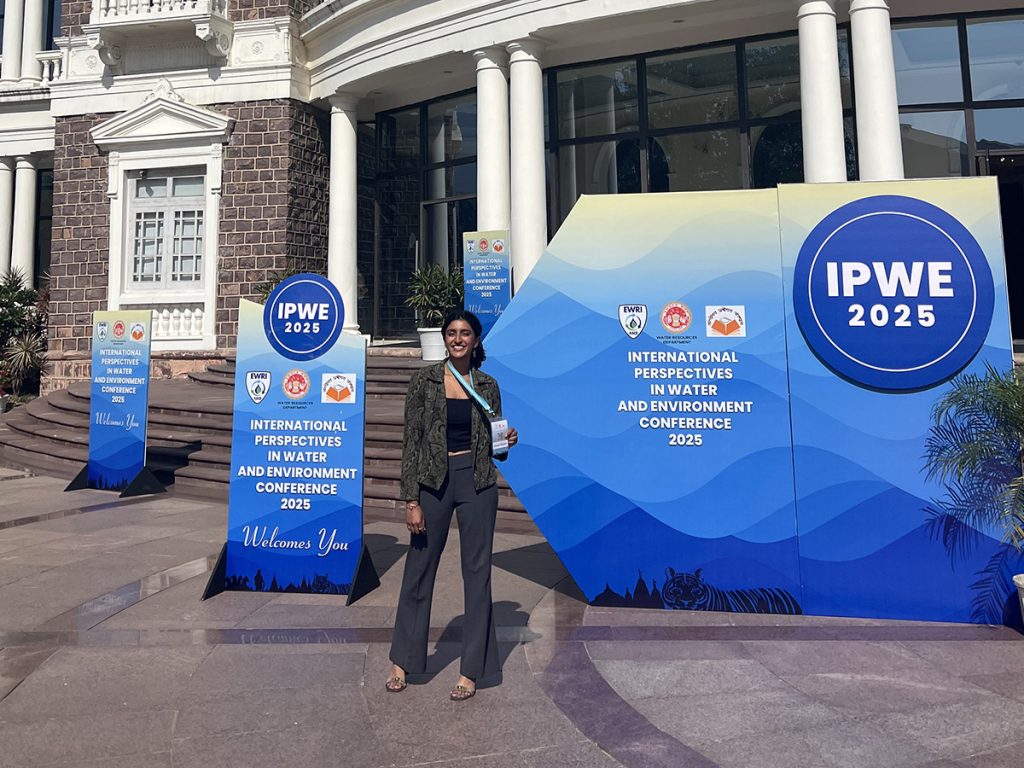
They have also worked with the US Forest Service, the Climate Hazards Research Team at SU, and FEMA (the Federal Emergency Management Agency). She was a member of the American Society of Civil Engineers (ASCE), an alum of Young Voices of Science, and has authored articles for the American Indian Foundation (AIF) on environmental livelihoods and sustainable water infrastructure.
Chandra has also been recognized for her strong academics and has held leadership roles across Syracuse University. Currently, she is a BIF Fellow at the Nehru Foundation for Development, VIKSAT in Ahmedabad, Gujarat, where she researches and documents climate-smart agriculture practices in dry areas in India and other countries. Her work has culminated in a climate-smart agriculture manual pending publication. In this one-on-one interview, Chandra discusses her research interests, experience in the environmental engineering program, and her career path.
Tell us about yourself!
I was a dual major at Syracuse University, so I was enrolled in the College of Engineering and Computer Science and the Maxwell School of Citizenship and Public Affairs. I studied environmental engineering and environment, sustainability, and policy, and I’m a very social science-oriented STEM person. I was also in the honors program, and my thesis was in geography. I love art, trying new recipes, and spending time outside.
What sparked your interest in coming to Syracuse University?
I was a Coronat Scholar! It was an incredible opportunity I couldn’t give up. It’s four years of tuition, funded research and study abroad, and Syracuse was a place that was big enough for me to explore options.
What do you enjoy about environmental engineering?
I love how you can tangibly see the impact of your work. As a hands-on person, that means a lot to me. I was a research assistant with professors Chris Johnson and Liz Carter. One thing I’m thankful for at Syracuse University is its diverse array of experiences and resources. Just by showing interest and speaking to people, a conversation often led me to an exciting opportunity.
What are your research interests?
My research focus presently is climate-smart agriculture, an approach to making farming sustainable and resilient in the face of climate change. I’m also interested in water infrastructure and the policy side of engineering. I took Professor Svetla Todorova’s course titled “Role of Science in Environmental Governance” and attended the COP-5 of the Minamata Convention on Mercury as an academic ambassador.
Broadly, I’m passionate about water systems and making them accessible to all, as well as improving water infrastructure. As engineers, a lot of our work is humanity-facing infrastructure, which inherently impacts marginalized communities, so I’m interested in how we can do better.
What was your experience in the environmental engineering program like?
Professors go the extra mile to give experiential learning. We used local data in research and in our environmental chemistry lab, such as samples from Onondaga Creek. I switched into engineering after my freshman year, only after understanding at Syracuse University how diverse the field is.
Where do you see yourself in the future?
I would enjoy being at the intersection of policy and engineering. I like engineering roles where I can integrate the social impacts of our work, and I’m really enjoying doing things locally in my current role. I see myself continuing this and working in a place that allows me to engage with communities regularly. In the future, I want to work specifically in urban climate resilience, equipping cities with the infrastructure to withstand the impacts of climate change.
Also, doing high-level engineering while interweaving social impacts in my work. I’m really interested in the participatory processes, how we can work with communities to design projects, and how it can function for their needs.
Do you have any advice for students?
I would tell students to approach networking with curiosity about what opportunities could look like and what the landscape of their field will look like in the future. Even if it’s a conversation that results in you realizing you don’t want to do something, it can be useful. I think you can learn the most from people and their experiences!
Electrical Engineering and Computer Science Department Chair Alex K. Jones Receives National Science Foundation (NSF) EAGER Award for Computer Memory Research
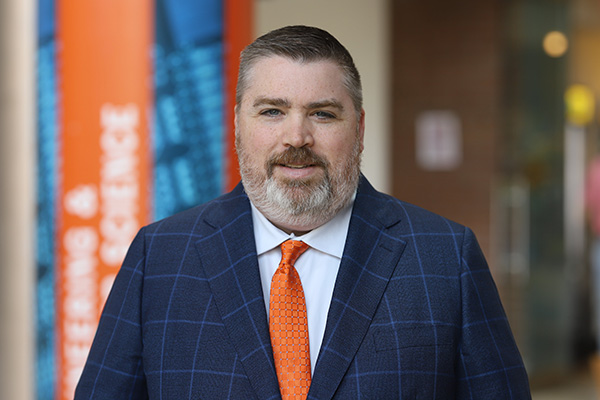
Alex K. Jones, the Department Chair of Electrical Engineering and Computer Science and Klaus Schroder Endowed Professor for Engineering, has received National Science Foundation (NSF) Early-concept Grants for Exploratory Research (EAGER) award for computer memory research. The award supports early-stage research with promising ideas involving innovative approaches, new expertise, and interdisciplinary educational opportunities. Jones serves as the project’s principal investigator.
Computers in space face challenges, particularly with radiation, which can disrupt electronic parts. Most space technologies use radiation hardening, a process that designs electronics to withstand the damaging effects of radiation. However, these parts are significantly more expensive than their commercial counterparts and are often generations behind the latest technologies.
“It’s like being forced to use a flip-phone because a radiation-hardened smart phone hasn’t been designed yet,” says Jones. “I would much rather try to figure out, using software-based fault tolerance, how to use the commercial smart phone than live with the flip phone.”
The project’s overall goal is to make commercial computer memory technologies more reliable and better suited for the harsh conditions of space. First, the project aims to understand how dynamic random-access memory (DRAM), the most common type of memory used in modern computers, behaves in space-like conditions. Second, the project will develop techniques to protect DRAM during in-memory computing, a method where data is processed and stored in a computer’s main memory.
“Normally, radiation is expected to randomly disrupt electronics. In our experiments, we found that memory errors are concentrated on 1.5 ten millionths of a percent of the memory capacity,” says Jones. “We have also been demonstrating that we can use this same memory to do massively parallel processing for AI, so the question we want to answer is what happens when we do this AI processing in the presence of radiation.”
Computing systems in space require solar energy, which limits their power supply. Because of this, they cannot use hardware accelerators such as those found in data centers. However, these space systems still need memory. If Jones’ research is successful, it could make computing AI algorithms possible in space using the computer memory as an accelerator.
“As a kid, I was blown away by the almost magical computers and artificial intelligence in Star Trek,” says Jones. “Never did I imagine I’d be helping to make AI in space computing a reality.”
Electrical Engineering and Computer Science Professor Senem Velipasalar Works with Startup Lamarr.AI to Launch Drone Pilot to Improve Energy Efficiency in City of Detroit Buildings
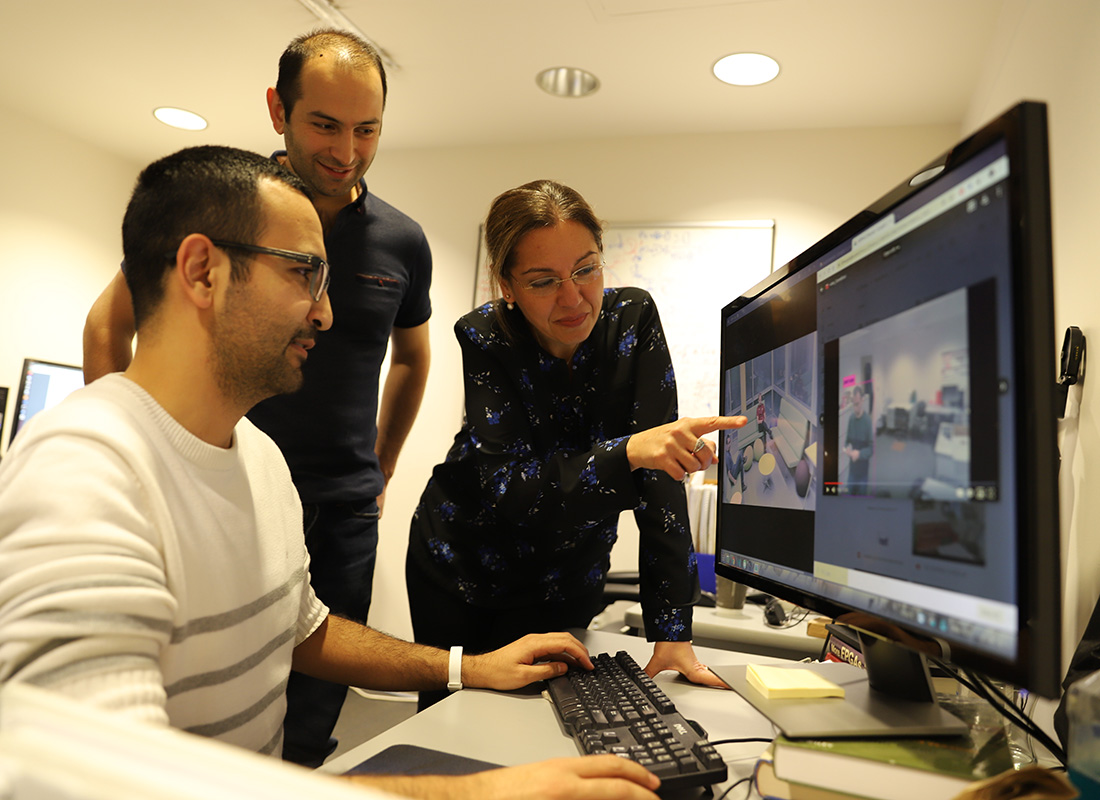
Electrical Engineering and Computer Science Professor Senem Velipasalar has been working alongside scholars at leading universities as the Chief Technology Officer of Lamarr.AI, a startup that comes from collaborative research efforts of Syracuse University, Massachusetts Institute of Technology (MIT), and Georgia Institute of Technology (Georgia Tech). The startup uses drones, thermal and visible-range imaging, and AI to autonomously inspect building exteriors to lower carbon emissions, maintenance, and ownership costs. The algorithms Lamarr.AI has developed have made building energy audits faster, more affordable, and more accurate than traditional methods.
Lamarr.AI has recently partnered with Michigan Central, a technology, mobility and cultural hub in Detroit, and Newlab, a platform that supports startups, to launch a drone inspection pilot to improve building operations and performance. The collaboration between Lamarr.AI, Michigan Central and Newlab will make use of Detroit’s Advanced Aerial Innovation Region, a testing ground for drone technology.
The startup used drone inspection technology to analyze several city-owned buildings in Southwest Detroit, and their system found over 460 issues with insulation and potential water leakage within just a few days. These findings were shown in 3D models and combined with energy simulations, revealing that making specific upgrades could lower HVAC energy use by up to 22% in all the buildings that were tested.
“Lamarr.AI is the product of more than 10 years of research funded by the Department of Energy and other grants. It is deeply rewarding to see the translation of our multi-disciplinary research into solving real-world problems,” says Professor Velipasalar.
Paulo Shakarian Joins Department of Electrical Engineering and Computer Science as K.G. Tan Professor of Artificial Intelligence

The College of Engineering and Computer Science is excited to announce Paulo Shakarian as the first appointed K.G. Tan Professor of Artificial Intelligence (AI). This professorship is a faculty position in the Department of Electrical Engineering and Computer Science (EECS) and was established by computer science alum Kwang G. Tan’s G’73 to support the future of education and research. Shakarian will lead the development and analysis of AI algorithms while serving as an instructor for computer science students.
Shakarian previously worked at Arizona State University, where he was a tenured professor and later the Research Director in the School of Computing and AI. He brings over 10 years of expertise in logic programming, data mining, and work at the intersection of AI and security. Shakarian is looking to leverage the endowment to further AI research and education at Syracuse, building on a series of recent AI hires made by the EECS Department.
“This professorship is particularly special as K.G. Tan is a pioneering innovator who helped usher in the first major wave of computing. It is a privilege to take this position in his honor,” says Shakarian. “This is particularly inspiring as we create AI systems to power the next technological revolution. I am excited to work with Syracuse’s strong faculty to establish leadership in this area.”
Tan designed some of IBM’s first functional computing units and had a successful career at companies such as HP and Sun Microsystems. His academic and professional journey has led him to value the importance of empowering engineering students, and he’s consistently supported the University through scholarships, foundations, and gifts. This professorship continues Tan’s legacy of academic support and innovative research.
“Dr. Tan’s doctoral research and early industrial work at IBM contributed to the design of foundational computing processors that helped spark the computing revolution. His work also played a role in inspiring Syracuse University’s establishment of the nation’s second-oldest computer engineering program. As the inaugural K.G. Tan Professor of AI, Paulo Shakarian brings a similarly innovative spirit by challenging the field’s conventional dependence on deep learning, which underpins large language models,” says Alex Jones, Klaus Schroder Professor and EECS Department Chair.
“His research in next-generation metacognitive AI is transforming how artificial intelligence can be integrated with rule-based decision-making,” Jones continues. “Combined with his experience in building AI-centric education programs, Dr. Shakarian’s leadership will further strengthen EECS’s already prominent position in AI research and education. I’m excited to see Dr. Tan, through Dr. Shakarian as his inaugural namesake professor, contribute once again to a transformative era—this time, the revolution of AI.”
Jianshun “Jensen” Zhang Named Interim Department Chair of Mechanical and Aerospace Engineering

The College of Engineering and Computer Science is excited to announce that Professor Jianshun “Jensen” Zhang has been appointed Interim Department Chair of Mechanical and Aerospace Engineering, effective July 1, 2025. Zhang serves as Executive Director of the Center of Excellence in Environmental and Energy Systems (CoE) and is one of the premier experts worldwide on built environment systems.
Zhang received his Ph.D. degree from the University of Illinois at Urbana-Champaign in 1991, worked as a researcher at the National Research Council of Canada for 8 years, and then joined Syracuse University in 1999. He has over 35 years of research experience in built environmental systems and has authored and co-authored more than 200 peer-reviewed journal papers and over 100 conference papers. His areas of expertise include combined heat, air, moisture and pollutant simulations in buildings, material emissions, air filtration/purification, ventilation, indoor air quality, and intelligent control of building environmental systems.
Zhang has developed advanced experimental methods, tools, and equipment, as well as computer simulation models and environmental control technologies. Over the last 25 years at Syracuse University, he has established and sustained an active research program in building energy and environmental systems with over $20 million in sponsored research. He also teaches graduate and undergraduate courses in the areas of building energy and environmental systems and fundamental heat and mass transfer. He has advised and co-advised over 20 Ph.D. students, over 20 M.S. students, and eight postdoctoral fellows.
Zhang is a member of the International Academy of Indoor Air Science (ISIAQ fellow) and a fellow of the American Society for Heating, Refrigerating, and Air Conditioning Engineers. He is also currently the vice president of the Indoor Air Quality, Ventilation and Energy Conservation Association. He served as president and chairman of the board of the International Association of Building Physics from 2018 to 2021. He is also Editor in Chief of the International Journal of Ventilation and Associate Editor of Science and Technology for the Built Environment.
“Professor Zhang is one of the best respected researchers, educators, and leaders in his field. I am especially grateful for his willingness to serve as interim department chair because he has been so intentional about mentorship and support of other faculty,” said Engineering and Computer Science Dean J. Cole Smith. “Although we will miss Dr. Young Moon’s steady leadership of MAE, I am excited to see the innovative actions Professor Zhang will take to move MAE forward.”
“I am truly honored and excited to have the opportunity to serve the department, college, university, and the profession in this new role. I sincerely thank the faculty, staff and ECS leadership for their trust and support, and thank Professor Young Moon for leading and serving MAE over the last decade. MAE has highly talented and very student-caring faculty and staff running excellent undergraduate and graduate programs. I am looking forward to working with them more closely to advance MAE to the next level,” says Zhang.
Mechanical and Aerospace Engineering Professor Fernando Zigunov Selected for NASA Glenn Faculty Fellowship

Assistant Professor in Mechanical and Aerospace Engineering Fernando Zigunov has been selected to participate in the NASA Glenn Faculty Fellowship, a 10-week research program for full-time STEM faculty members. The fellowship will take place from June to August at the Glenn Research Center (GRC) in Cleveland, Ohio.
Participants in the fellowship will contribute to research, technology and engineering goals in support of NASA’s mission, engage with NASA subject matter experts in research and engineering, enhance their professional knowledge, and infuse NASA mission-related research and technology content into classroom teaching.
“I’m very grateful to have been selected for this fellowship,” says Zigunov. “I look forward to collaborating with NASA Glenn’s aeropropulsion group and contributing to their cutting-edge research to understand turbulent noise production mechanisms towards the development of the next generation of quiet propulsion systems.”
Professor Emeritus Shobha K. Bhatia Receives Robert M. Koerner Award from Geosynthetics Materials Association
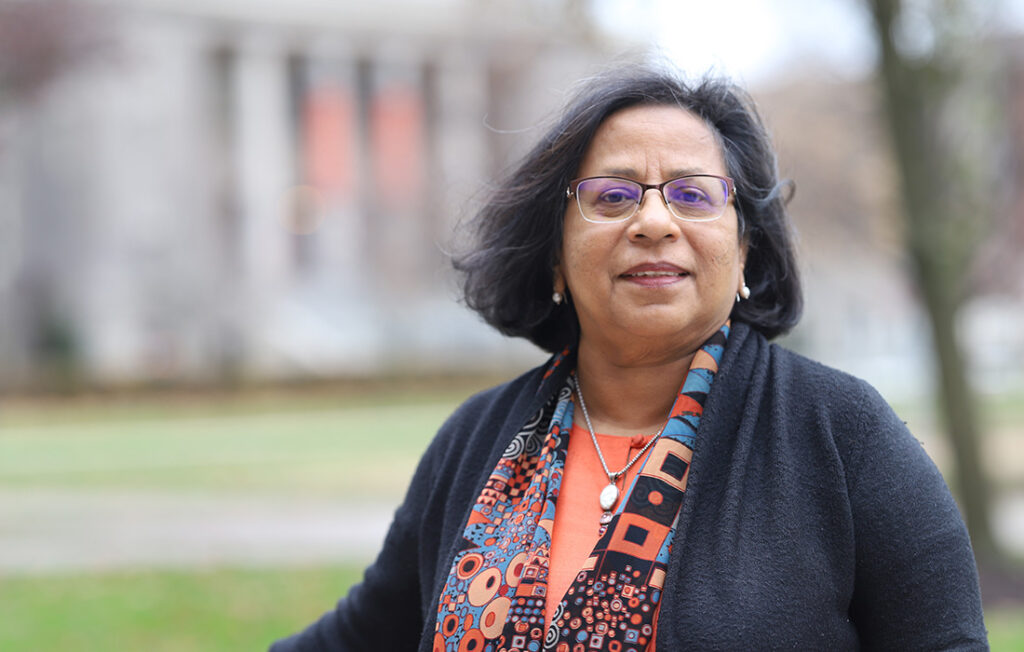
Professor Emeritus in Civil and Environmental Engineering (CEE) Shobha K. Bhatia was honored with the Robert M. Koerner Award from the Geosynthetics Materials Association (GMA). This prestigious award was established by the GMA in 2016 to honor renowned civil engineer Robert M. Koerner and recognizes individuals who have made a significant impact on the geosynthetics industry in North America.
As part of this recognition, Bhatia delivered a keynote lecture at the GMA and Geo-Institute’s co-located Geotechnical Frontiers Conference on March 4, 2025, in Louisville, Kentucky. More than 300 participants attended her lecture.
At the Geotechnical Frontiers Conference, Bhatia participated in a high-level Geosynthetics Industry Round Table focused on advancing the role of women in the geosynthetics industry. Joining six other accomplished women leaders from across the industry, she contributed to a discussion aimed at promoting progress through education, mentorship and professional networking opportunities.
Bhatia also presented two technical papers co-authored with her graduate students, Zeru B. Kiffle and Nuzhath Fatema, which showcased ongoing research and innovation in the field of geosynthetics and geotechnical engineering. She is scheduled to deliver keynote lectures at three other major conferences between 2025 and 2027, further extending the reach and impact of her work in the geosynthetics industry.
“Receiving the Koerner Lecture Award is evidence of the significant impact that Dr. Bhatia’s extensive and innovative research has had on the field of geotechnical engineering. It further reinforces the influence that Dr. Bhatia has had across all facets of her career and her meaningful contributions to improving the lives of others through her research and outreach,” says CEE Department Chair Andria Costello Staniec.
“It is one of the greatest honors of my career to receive the Koerner Lecture Award,” says Bhatia. “This award recognizes the research contributions made by my students and me, and the measurable impact of our work on the geosynthetics industry in North America.”
Clean Harbors’ Partnership with Syracuse University Brings Opportunities for Students
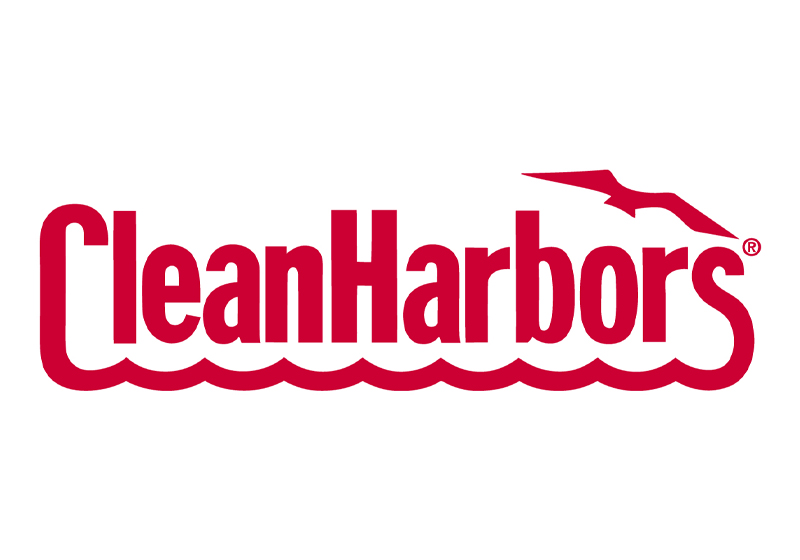
Since 1980, Clean Harbors has been the leading provider of environmental, energy and industrial services across North America. From waste management to industrial cleaning, the company offers a variety of services, including hazardous waste management, emergency spill response, cleaning for industrial facilities, recycling services, and the provision of parts washers.
In addition to the environmental services, Clean Harbors also offers co-ops and internships for engineering students to gain real-world experience. Engineers play a crucial role in the company’s day-to-day operations, and Clean Harbors’ partnership with Syracuse University has supported their mission of a sustainable future while gaining access to the University’s brightest minds prepared to tackle today’s environmental challenges.
“We are proud to highlight the significant contributions of Clean Harbors to the College of Engineering and Computer Science (ECS) Employer Partnership Program. Since the program’s inception two years ago, they have been a steadfast Employer Partner, actively participating in numerous student events and providing invaluable support to our students,” says Assistant Director of Employer Relations & Career Services Jennifer Fazio.
“We see tremendous value in our partnership with Syracuse University, particularly with the College of Engineering and Computer Science. This relationship creates a powerful, mutually beneficial pipeline between industry and academia,” says Vice President of Talent Management Patrick Orr.
Engineers, especially those with backgrounds in environmental or chemical engineering, are involved in the safe handling and disposal of hazardous waste and conducting chemical analysis and lab testing to ensure materials meet safety standards. Engineers also design and optimize waste processing systems and recycling workflows to streamline site operations for better safety and sustainability practices.
Engineers with computer science or data engineering backgrounds analyze field and lab data to improve decision-making and service delivery, use tools to track waste movement and operational metrics and contribute to digital solutions for reporting, sustainability tracking and logistics planning. Engineers may also advise clients and stakeholders on sustainable solutions.
Clean Harbors also operates in several locations across India, providing crucial support services to frontline operations in North America. These teams contribute to a range of functions, including IT, finance, customer service and business process support, providing unique opportunities for international students. There also may be opportunities for top talent in their India locations to transfer or be temporarily assigned to roles in the U.S.
“International students who may be returning to India after graduation could be strong candidates for roles within our Indian operations, offering them the opportunity to apply their U.S.-based education and experience in a dynamic, global company,” says Orr. “We see great potential in building a pipeline of talent who understand both the U.S. and Indian business environments and can help bridge our global teams.”
As Clean Harbors continues to grow its business across the globe, the company looks forward to exploring new opportunities to deepen its relationship with ECS.
“As one of our valued Employer Partners, we deeply appreciate Clean Harbors’ dedication and support. We look forward to continuing to build a mutually beneficial relationship with them, working together to create more opportunities for our students and advancing the field of engineering and computer science,” says Fazio.
“Ultimately, this partnership helps build the next generation of environmental and operational leaders. It’s a win for Clean Harbors, a win for Syracuse University and a win for the future of sustainable industry,” says Orr.
Electrical Engineering and Computer Science Professor Endadul Hoque Hosts Capture the Flag Cybersecurity Competition
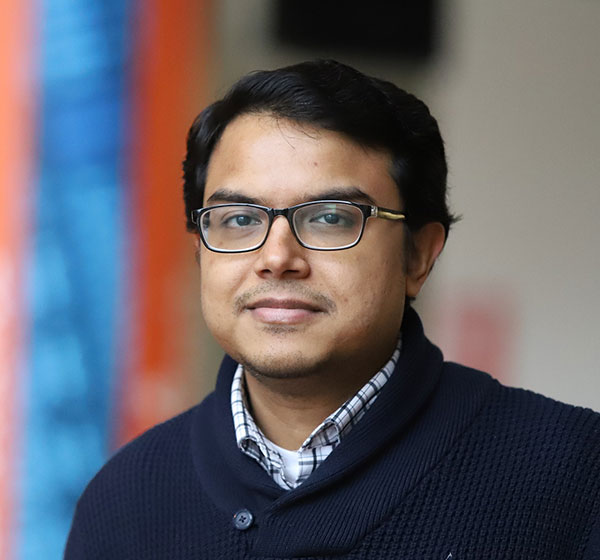
Electrical Engineering and Computer Science (EECS) Professor Endadul Hoque hosted a Capture the Flag (CTF) cybersecurity competition in the College of Engineering and Computer Science (ECS). These competitions provide a gamified, hands-on approach to cybersecurity education, helping students strengthen their problem-solving skills and prepare for real-world security challenges.
“It’s an effective way to improve security education and a great way to foster a more competitive and engaged cybersecurity workforce,” says Hoque.
In CTF competitions, participants search for hidden text strings in vulnerable websites or programs. A warm-up session was organized during the spring 2025 semester at the Center for Science and Technology with 18 undergraduate students in attendance. Hoque’s PhD students—Siwei Zhang, Polina Kozyreva, and Uday Devaraj—were also part of the organizing team.
“This was our department’s first-ever CTF initiative. The session was a great success and generated a lot of positive energy among participants,” Hoque says.
The CTF initiatives are a part of Hoque’s efforts to bolster the EECS department and engage students outside the classroom. He will form a team to participate in competitions by hosting more sessions and getting students involved while promoting cybersecurity awareness.
“Organizing a CTF challenge for undergraduates allowed me to inspire and encourage younger minds to apply their skills in new ways and deepen their understanding of this ever-evolving field. I hope the experience fuels their passion for computer science and supports their journey beyond academia,” says Kozyreva.
“The response was overwhelmingly positive, with participants calling it fun, engaging, and thrilling. Instead of focusing on technical depth, we aimed to build a creative, collaborative CTF community. It was incredibly rewarding to see everyone enjoying the event!” says Zhang.
“The CTF event was a great experience, and my first time helping organize one. The excitement was contagious, especially when students celebrated their wins by capturing the flag. I’m grateful for the opportunity,” says Devaraj.

Mechanical and Aerospace Engineering Doctoral Student Melissa Yeung Receives Zonta International’s 2025 Amelia Earhart Fellowship

Mechanical and aerospace engineering doctoral student Melissa Yeung has received Zonta International’s 2025 Amelia Earhart Fellowship, a prestigious award that supports women pursuing doctoral degrees in aerospace engineering. The award honors aviation pioneer Amelia Earhart. Zonta International is a global organization that supports women and girls.
The Amelia Earhart fellowship offers financial support to help women further their education and advance their careers. Promising and talented women from top-tier universities all over the globe are selected by Zonta International for the Amelia Earhart Fellowship every year. During her time at the College of Engineering and Computer Science, Yeung has demonstrated an exemplary academic record in aerospace engineering research, joining the National Science Foundation (NSF) Graduate Research Fellowship Program (GRFP) last year.
“Winning the Amelia Earhart Fellowship affirms my aspirations to be a leader in the field, motivating me to continue my efforts in uplifting and supporting other women in STEM. It serves as a reminder that I am not alone in my journey and challenges, and I am excited to be among a community of women equally as passionate about advancing aerospace engineering,” says Yeung.
“Melissa’s Amelia Earhart Fellowship is not just a recognition of her achievements—it’s a celebration of her potential. From the moment she joined my lab, she has impressed me with her intellect, initiative, and kindness. As someone who knows how much this fellowship can mean, I’m thrilled to see it now honoring someone so deserving. She’s already leading with purpose, and this is just the beginning,” says Yiyang Sun, assistant professor in mechanical and aerospace engineering.
Electrical Engineering and Computer Science Professor Endadul Hoque and Ph.D Student Polina Kozyreva Receive Best Paper Award at the International Workshop on Search-Based and Fuzz Testing
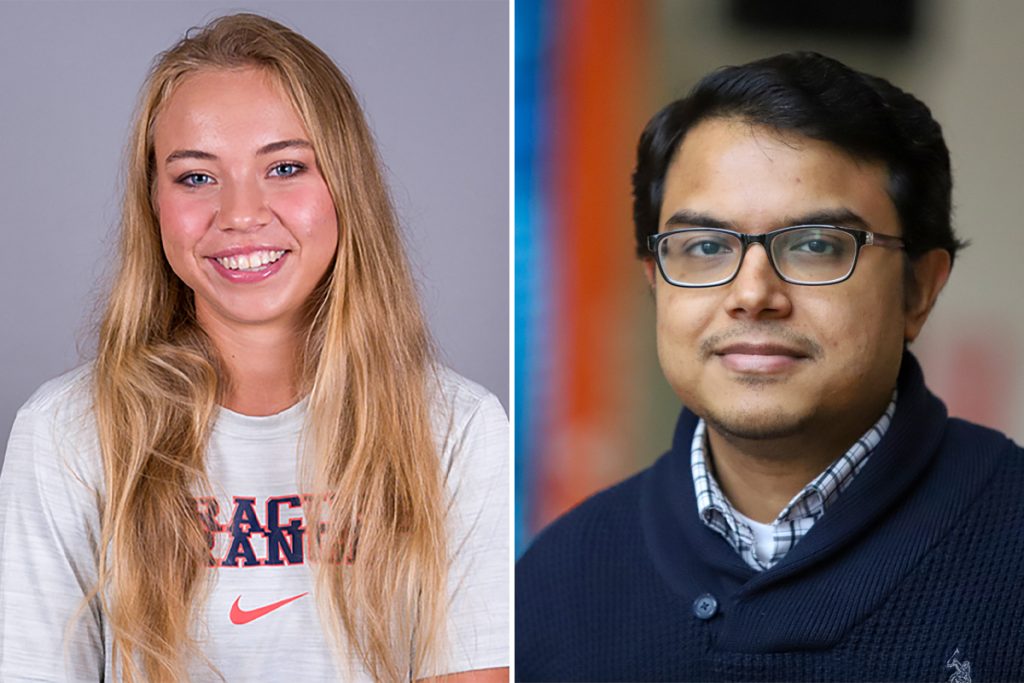
Assistant Professor in Electrical Engineering and Computer Science, Endadul Hoque, and Ph.D. student, Polina Kozyreva, have received the Best Paper Award at the International Workshop on Search-Based and Fuzz Testing (SBFT 2025). They received the award for their paper, “On Evaluating Fuzzers with Context-Sensitive Fuzzed Inputs: A Case Study on PKCS#1-v1.5.”
Fuzz testing is an automated software testing technique where you input random or invalid data into a program to identify bugs and vulnerabilities.
SBFT is a two-day workshop that includes a research track, keynote presentations, and testing tool competitions. The primary goal of this workshop is to bring together researchers and industry practitioners from the fields of software-based testing, fuzzing, and the broader software engineering community to share their experiences and discuss future research focused on automating software testing. Additionally, the workshop promotes the integration of search and fuzzing techniques with other areas of software engineering.
The SBFT 2025 workshop was held in Ottawa, Canada, and co-located with the Institute of Electrical and Electronics Engineers (IEEE)/Association for Computing Machinery (ACM) International Conference on Software Engineering (ICSE 2025), a top-tier software engineering conference. Kozyreva presented their paper and received the award on behalf of the team.
“I am extremely honored to receive the Best Paper Award, especially as this was the first paper I had the pleasure of working on with my advisor and presenting in front of leading experts who inspire me to grow and strive to become a contributor to the field—someone whose work benefits the community,” Kozyreva says.
“It’s incredibly rewarding to see this work with Polina win the Best Paper Award at such a prestigious workshop. As a first-year PhD student, she not only worked on the paper but also presented it herself and did a fantastic job. Achieving a best paper award so early in her PhD is a remarkable milestone and a strong boost as she continues the follow-up project. She’s shown both tremendous potential and tenacity—I’m excited to see where she takes her research next,” says Hoque.
Pivotal Research on Aquatic Ecosystems

Stretching more than 5 million acres, the Adirondack Park is one of the largest protected areas in the United States. The region is home to over 3,000 lakes, diverse wildlife and habitats, making it an ideal location for research on different ecosystems. For the past two semesters, environmental engineering graduate student Amos Bungei has been conducting research in this unique environment, focusing on dissolved organic carbon and its effects on the Adirondack Lakes.
Dissolved organic carbon, also known as DOC, is organic matter, such as plants and soil, that is broken down and can be found in aquatic ecosystems. It plays a crucial role in the movement of carbon throughout the planet and is a main food source for aquatic animals. However, when the amount of DOC in a lake is high, it can impact the effects of solar radiation, increase the differing water temperatures within the lake, and decrease oxygen levels in the lake water. DOC can also increase the cost of the water treatment process since it impacts water quality.
Bungei’s research focuses on identifying the causes behind the increasing concentration of DOC in the lakes that have been observed in the Northeastern regions of the United States and Northern Europe. “We’ve been seeing a rise in concentration of dissolved organic carbon in the Adirondacks since 1982,” says Bungei. “My goal is to determine the drivers of this increase in dissolved organic carbon to support appropriate measures.”
To explore potential causes, Bungei has been running machine-learning models combining data from 48 lakes in the Adirondack region, watershed data from the U.S. Geological Survey, and other factors such as rain and temperature. He then assesses the results against the results for carbon quality, and he’s found that DOC primarily comes from wetlands.
“Lakes in watersheds that have huge proportions of wetlands tend to have higher concentrations of DOC,” he says. “Increases in dissolved organic carbon are primarily supported by a rise in pH, which has been observed across the Adirondack since the passing of the Clean Air Act of 1970. The Act led to the reduction of sulfur dioxide emissions, which contributed to acid rain. Over the years, the reduction in system acidity has facilitated easier mobilization of organic matter from land to the lakes, and that is why we are observing increases.”
Bungei attended the American Geophysical Union 2024 Conference, the largest annual Earth science conference in the world, where he presented his research, catching the attention of several attendees. He also connected with faculty, students, and professionals who share similar research interests, gaining insights into the latest developments in the field.
“It was a great experience,” he says. “You discuss your results, you gain new insights and get interesting takes on what you’re looking into.”
Bungei hopes to develop a machine learning model that can predict the patterns of organic carbon concentration in various lakes and regions across the globe. “This research will be crucial to the future of Earth science, and I look forward to contributing to these efforts.”
Biomedical and Chemical Engineering Professor Shikha Nangia Receives Chancellor’s Citation for Excellence Award

Shikha Nangia, professor and department chair of biomedical and chemical engineering (BMCE), has received the Chancellor’s Citation for Excellence in Faculty Excellence and Scholarly Distinction. This award acknowledges faculty members who engage in collaborative work with significant intellectual value and have the potential for future impact. The contributions of these nominees create opportunities for collaboration both within the University and with external partners.
Nangia joined Syracuse University in 2012 and has since established herself as a leading expert in computational modeling, focusing on overcoming biological barriers. Her groundbreaking research addresses critical challenges in treating complex diseases, including Alzheimer’s and Parkinson’s, as well as investigating gut tight junctions, implantable device-related infections, and epigenetics.
She has published extensively in leading scientific journals such as Biomacromolecules, Macromolecules, Langmuir, Journal of the American Chemical Society (JACS), and Journal of Biological Chemistry (JBC). Her work has been featured on the covers of journals including Biomacromolecules, Langmuir, Journal of Chemical Theory and Computation, and Journal of Physical Chemistry. She has been recognized with several honors, including the ACS OpenEye Outstanding Junior Faculty Award (2016) and the ACS Women Chemists Committee Rising Star Award (2022).
Since 2012, Nangia has mentored approximately 110 students at various stages of their academic journeys, including graduate students, undergraduates, and high school students. Her dedication to teaching and mentoring has earned her numerous prestigious awards, such as the College Technology Educator of the Year (2016), the Meredith Teaching Recognition Award (2017), the Dean’s Award for Excellence in Education (2017), the Chancellor’s Citation Award for Outstanding Contributions to Student Experience and University Initiatives (2019), and the Excellence in Graduate Education Faculty Recognition Award (2022).
Currently, Nangia serves as the faculty co-director of the Women in Science and Engineering (WiSE) program. She leads several impactful initiatives, including the NSF Interactive Biomaterials REU site and the NIH ESTEEMED program, which focuses on undergraduate research training. She was named department chair of biomedical and chemical engineering in 2025 after serving an interim role in 2024.
The Chancellor’s Citation for Excellence award was presented to Nangia at the One University Awards Ceremony, an annual event to honor members of the Syracuse University community who are making a difference through academics, work, and dedicated service. The ceremony was held Friday, April 11, in Hendricks Chapel.
Civil and Environmental Engineering Student Teams Win First Place in the American Society of Civil Engineers (ASCE) Competition

Civil and environmental engineering student teams participated in the American Society of Civil Engineers (ASCE) Sustainable Solutions and Steel Bridge competitions during the 2025 Upstate New York-Canada Student Symposium, winning first place in the Sustainable Solutions competition. The symposium was held at the United States Military Academy in West Point, New York.
The ASCE Student Symposium challenges students to explore and implement sustainable solutions, allowing them to apply their skills and knowledge to real-world challenges. Competitions such as Sustainable Solutions encourage students to deepen their understanding of sustainability and learn how to integrate sustainable solutions into everyday engineering problems.
“We presented a redevelopment proposal focused on transforming a vacant office complex into a vibrant, sustainable, and affordable housing community. The design incorporated green roofs, passive solar design, greywater recycling, and community-oriented amenities such as a public garden, amphitheater and small local businesses,” says environmental engineering student Brooklyn Toller ’27.
The Steel Bridge competition challenges students to design and build a scale-model steel bridge. During the fall semester, students create a design based on specifications provided by the ASCE and draft plans for the construction of a 20-foot scale model. The goal is to minimize the bridge’s weight while ensuring it can support a load of 2,500 pounds.
The student team took first place for cost estimation, a category in the Steel Bridge competition, and came in 6th place overall.

“It was intriguing to look at the other teams’ designs and construction processes. Seeing new and different intricacies from the other schools really allowed me to start thinking about ways that our bridge could be improved, which will help us improve our bridge design and construction process for years to come,” says civil engineering student Evan Garcia ’28.
The ASCE Syracuse student chapter also participated in the Mead Paper competition, where students tackle complex issues about engineering ethics, allowing them to examine and communicate the purpose and responsibilities of a civil engineer.
“I was elected by my chapter to enter into the Daniel W. Mead Student Prize Paper Competition. This opportunity allowed me to practice both my written and oral communication skills. I am very proud of the work that I put forth and am a better public speaker because of it,” says civil engineering student Shannon O’Kane ’28.
The Sustainable Solutions team will participate in the ASCE’s national championships. The competition will be held June 27-29 at California Polytechnic State University, San Luis Obispo.

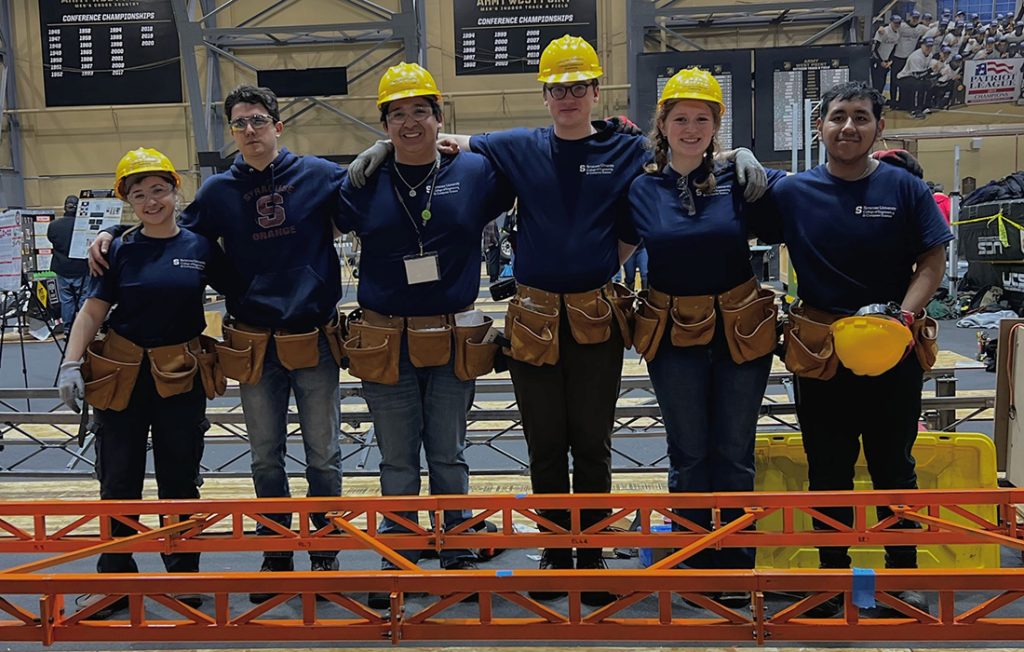
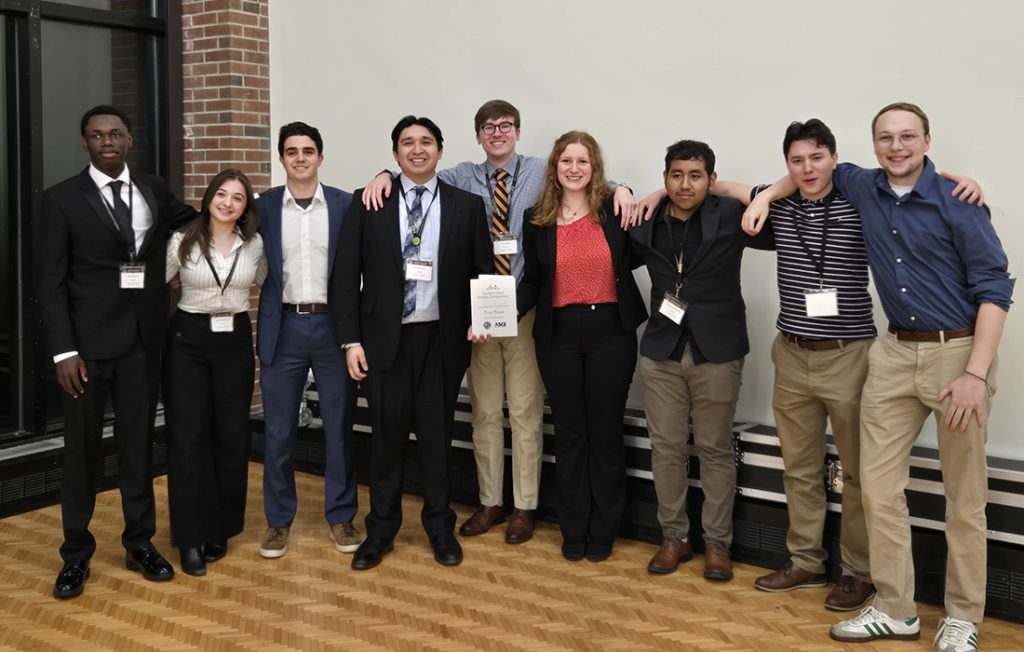
Biomedical and Chemical Engineering Students Present Senior Capstone Design Projects
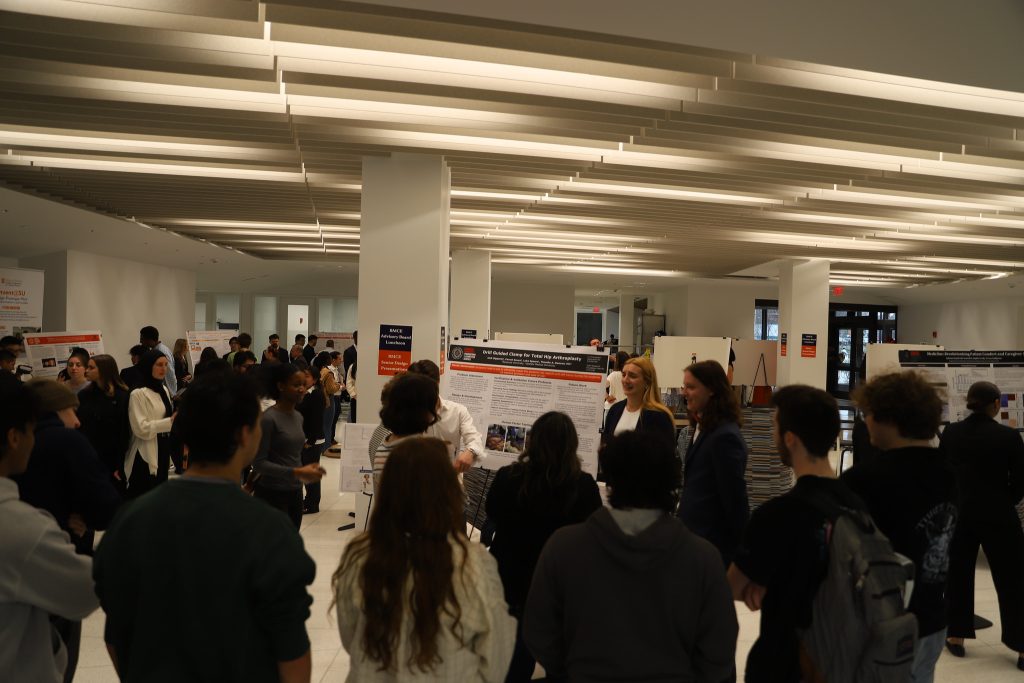
Biomedical and chemical engineering (BMCE) students presented their senior capstone design projects in Link Hall. The presentations consisted of eight biomedical engineering teams and six chemical engineering teams. Members of the BMCE Advisory Board, consisting of industrial and academic representatives, served as judges for the poster session. This senior design course challenges students to study real-world issues and develop a solution from concept to prototype.
Biomedical Engineering
OrthoClamp
Total Hip Drill Guide Clamp
Members: Jack Sipperly, Luke Spears, Farrah Sousa
Client: Tim Damron, MD, Orthopedic Surgery, Upstate University Hospital
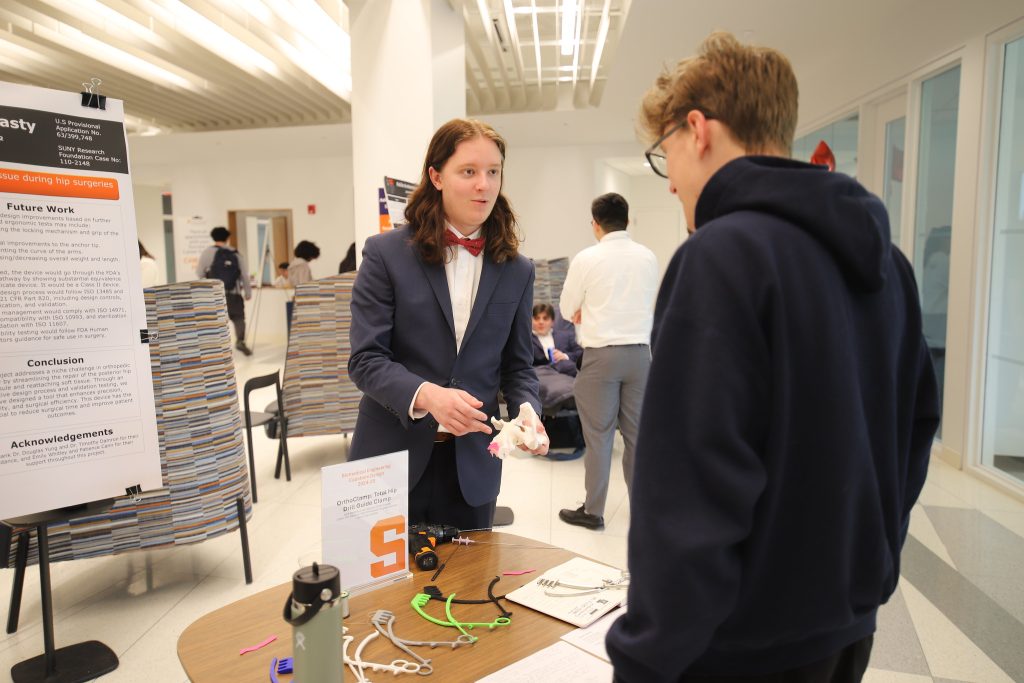
Peptify
Generation of Versatile Prokaryotic-based Peptide and Protein Library Interaction Screening
Members: Ashraf Alnatour, Jennifer Gonzalez, Samantha Fernandez
Client: Dr. Aliji Bah, Biochemistry and Molecular Biology, Upstate Medical University
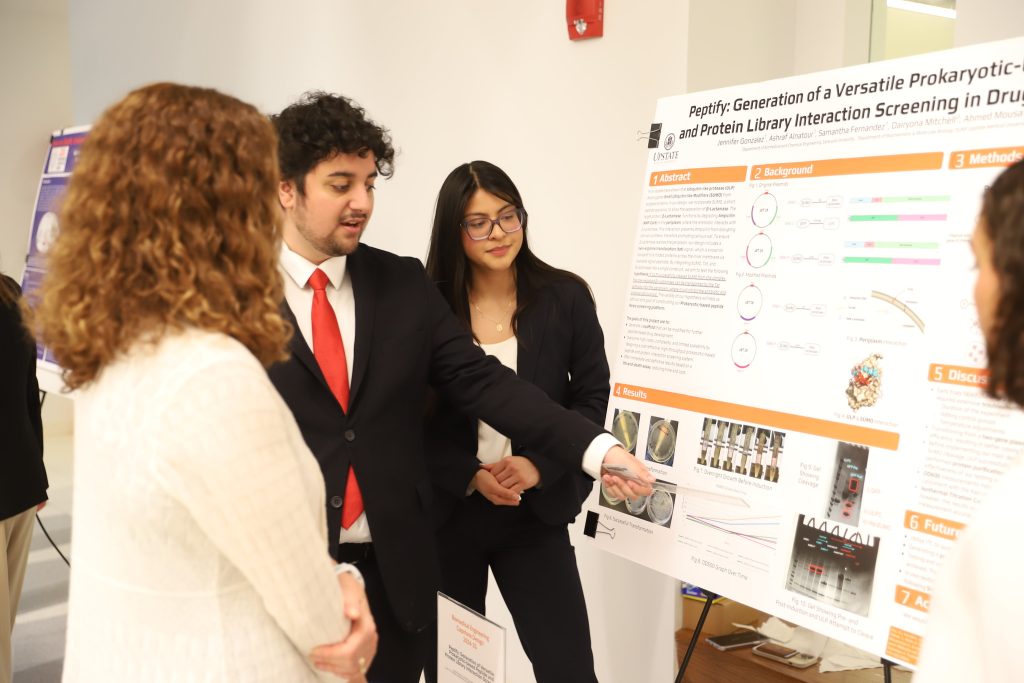
VISABLE
Rotational Laparoscopic Lens
Members: Aidan McCarthy, Luke Rogers, Jason Bae
Client: Timothy Shope, MD, Surgery, Upstate University Hospital

EyeVRgence
Optimizing Vision Restoration Therapies Using VR Technology
Members: Quinn Langdon, Danny Vu, Shayna Marcano
Client: Dr. Darwin Babino, Ophthalmology and Visual Sciences, Upstate Medical University

Dare to DAIR
Enhancing Hydro-Pressure Debridement Procedures
Members: Katherine Monroe, Kerrin O’Grady, Jenna Grutzmacher
Client: Zimmer Biomet
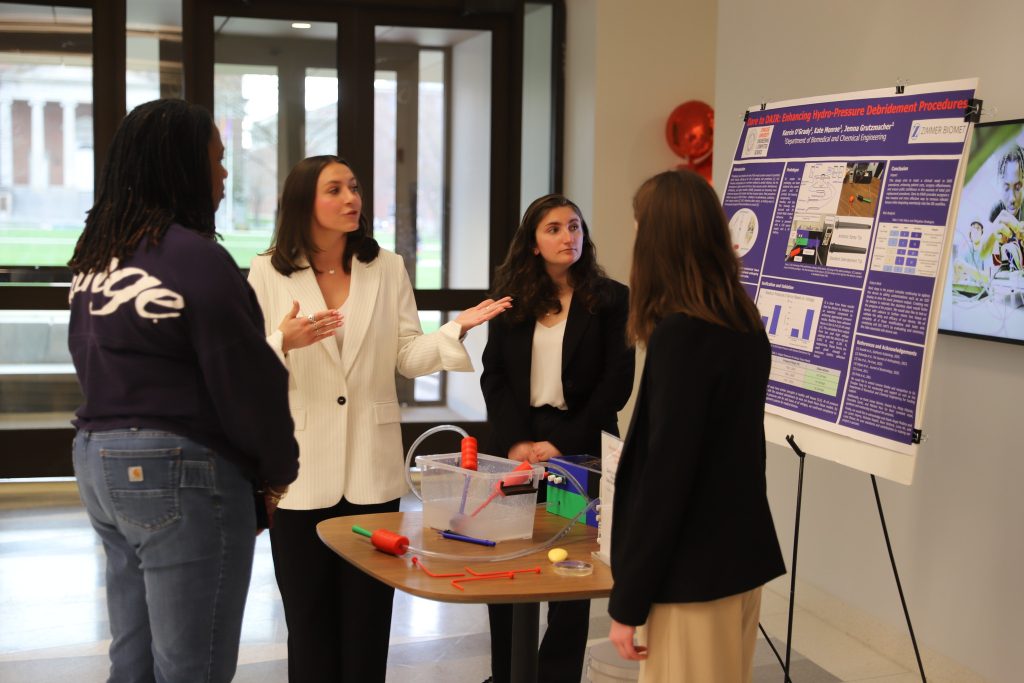
StepAware
Custom Pressure-Sensing Insoles for Early Detection of Charcot Foot
Members: Mia Paynton, Olivia Etienvre, Tessa DeCicco, Bridget Sides
Client: Zimmer Biomet

HydraCare+
Ichthyosis Management
Members: Abdullah Swati, Amira Salihovic, Blanca Lopez
Client: Ryan Licursi

Medicline
Revolutionizing Patient Comfort and Caregiver Support
Members: Juliana Sepulveda Gonzalez, Tessa Galipeau, Sophie Grady
Client: Theresa Galipeau

Chemical Engineering
Sustainable Ibuprofen Synthesis
Members: Alexis Riccardo, Haonan Ma, Daud Abdullayev
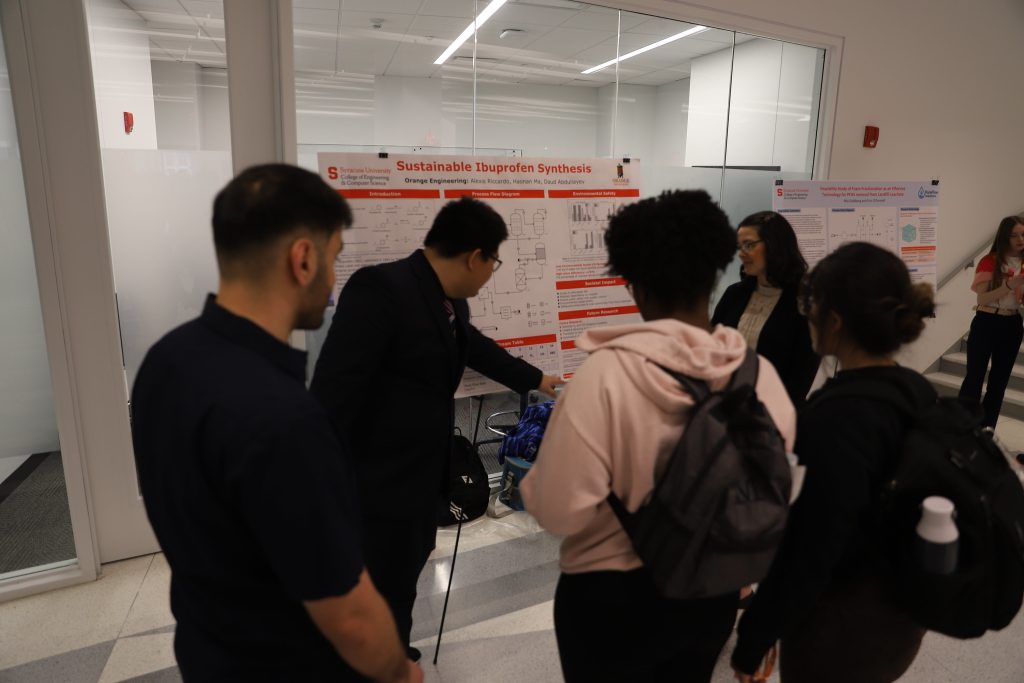
Feasibility Study of Foam Fractionation as an Effective Technology for PFAS Removal from Landfill Leachate
Members: Mia Goldberg and Erin O’Donnell
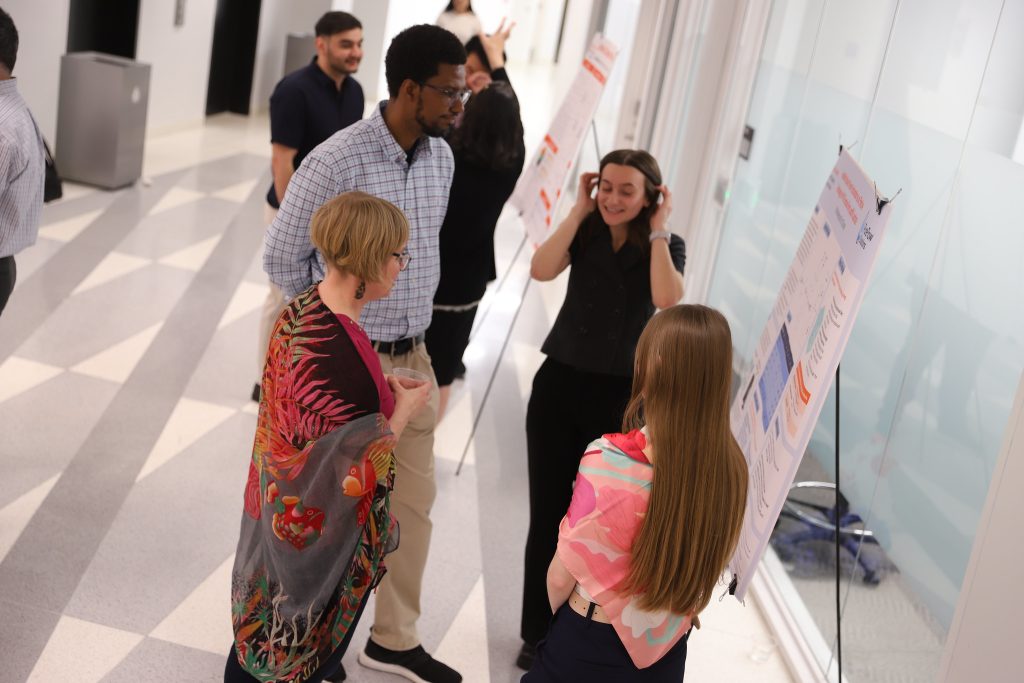
Production of Non-Alcoholic Lager
Members: Christopher Hansen, Eli Paster, Riley Schmerber, Jackson Yuen

Vinegar-Based Window Cleaner is a Cost-Effective and Sustainable Alternative to Ammonia-Based Cleaners
Members: Annika Meyers, Isabella Perkins, Sonia Julius
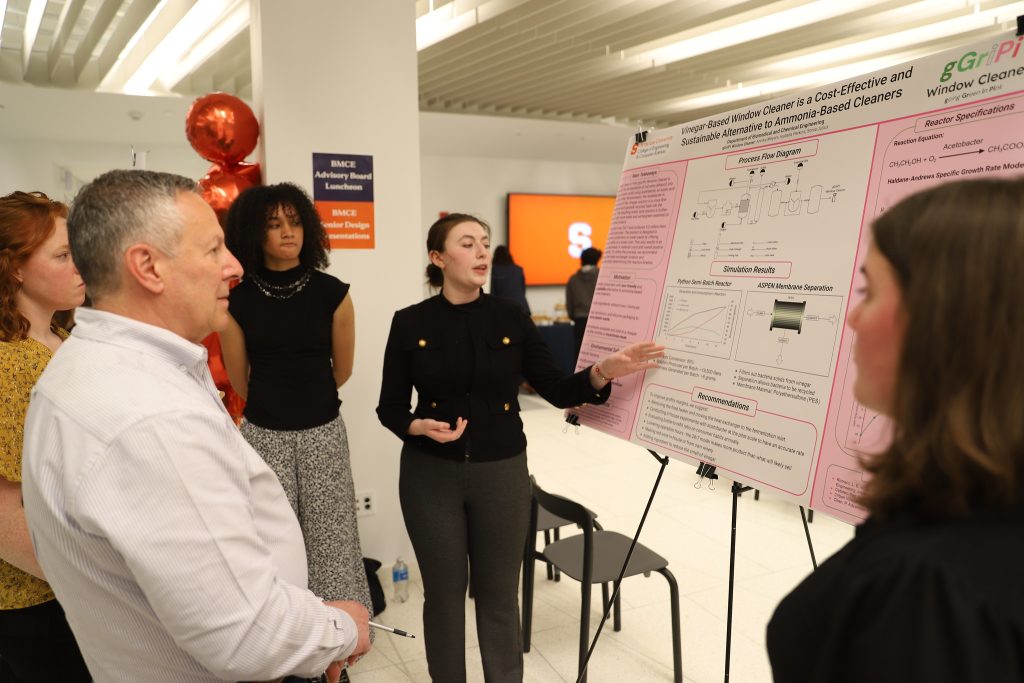
Removal & Capture of PFAS from Industrial Effluent
Members: Daisy Wilson, Jordan Avinoam, Nora Prosak

Profitable and Environmentally Green Synthesis of Ibuprofen
Members: Hope Johnson, Natalia Jarmain, Emma Klein, Poppe Constable
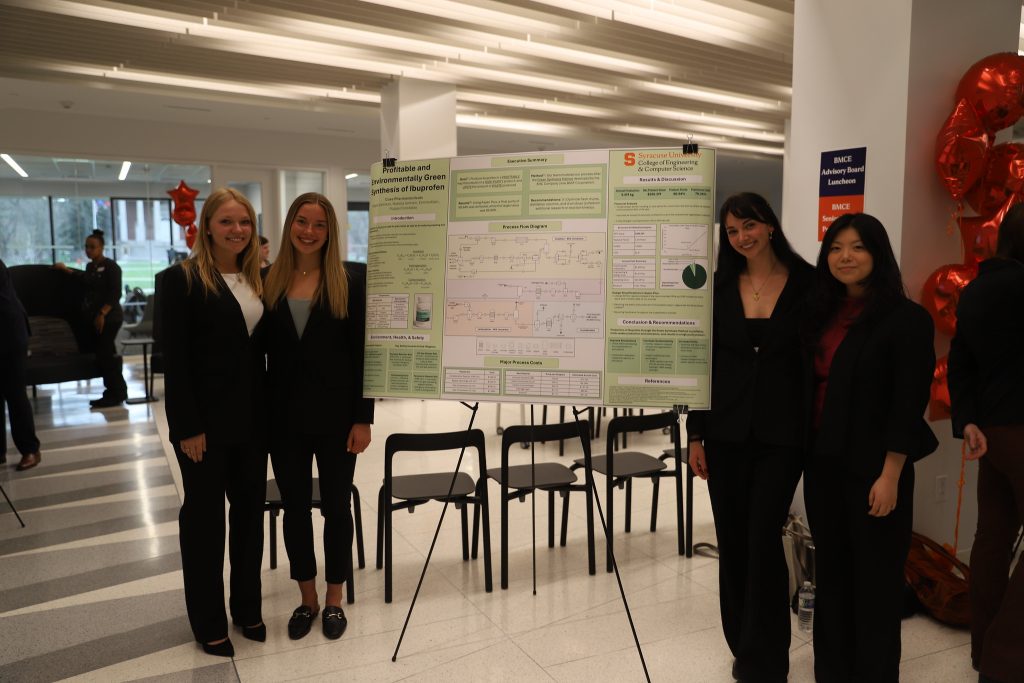
Electrical Engineering and Computer Science Professor Bryan Kim Receives NSF CAREER Award
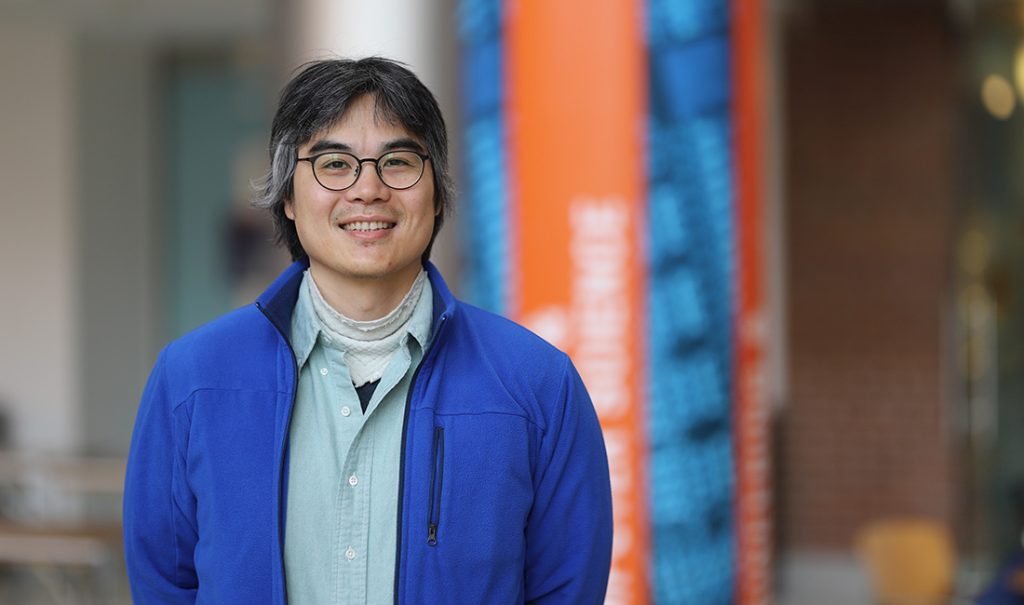
Bryan Kim, an assistant professor in electrical engineering and computer science (EECS), has received the National Science Foundation (NSF) CAREER Award, a highly prestigious award that supports early-career faculty in developing their career as outstanding researchers and educators. The award will build on his previous research on data storage systems and contribute to the field by exploring new ways to improve the memory and storage systems of computers.
Computer systems use memory to hold data temporarily and storage for long-term data. Both memory and storage have made significant improvements due to the increased demands from data analytics and machine learning applications. However, the performance of these memory and storage systems is limited by the flow of information between the software that uses data and the hardware that stores it. Kim’s research project aims to fill the gap in information by adding implicit hints between systems and devices.
The project is innovative for two main reasons: first, it will use the address of the data as an implicit agreement for the expected performance quality of accessing that data. Second, it will optimize the hardware and software systems based on this interface. The broader significance of the project is improving the sustainability and performance of computer systems and developing the educational pipeline for computer systems.
“My project aims to improve memory and storage systems that use narrow interfaces such as physical memory addresses and logical block addresses. The key insight is that there are translation layers above and below these interfaces, which enable systems and devices to pass hints while remaining compatible with older systems,” says Kim.
As part of the NSF grant, Kim plans to engage undergraduate students in research activities and develop workshops for K-12 students in collaboration with the Museum of Science and Technology in downtown Syracuse. He also plans to create and enhance tools for the undergraduate courses he teaches, which will help demonstrate how computer systems function.
“Visualization tools make it easy for undergraduate students to understand how data moves in a complex computer system,” says Kim. “This project will allow me to develop an education pipeline so we can get more students involved in research.”
Kim’s research will be integral to the field of computer storage systems and will improve the performance of these systems without needing to change how the applications work.
“Bryan’s research on collaborative operation of the memory and storage system is critical for managing the massive amount of data movement in next-generation artificial intelligence, bioinformatics, and scientific computing among many other application areas,” says Alex K. Jones, the Klaus Schroder Endowed Professor for Engineering and Department Chair of EECS. “His recognition from the NSF during this time is a testament to his great research and the important research happening broadly in EECS at Syracuse University.”
“Dr. Kim has been an incredibly valuable resource to EECS and our college due to his knowledge of new and emerging memory systems. He is a thoughtful instructor who has emerged as an especially creative scholar in this critical field. With the arrival of semiconductor manufacturing in Syracuse, we are incredibly grateful to have a thought leader of his caliber in our college,” says Dean J. Cole Smith.
“That’s one of the things about research, we’re able to look far because we’re standing on the shoulders of giants,” Kim says. “We’re building on top of other people’s work. I feel fortunate and grateful to be receiving this reward.”
Mechanical and Aerospace Engineering Students Collaborate with NASA on Senior Design Capstone

For decades, NASA’s testing chambers have been used to simulate the harsh conditions of space, allowing engineers to test the durability of spacecraft and other equipment in a controlled environment. These testing chambers, which can simulate extreme temperature or pressure environments, have played a crucial role in developing new technology for space travel, dating back to the first Apollo space mission.
Collaborating with NASA on their senior design capstone project, four mechanical and aerospace engineering students, Liam Collins ’25, James Jabbour ’25, Brady McKenna ’25 and Alexandra Vaida ’25, are gaining real-world experience building a mechanical actuator test stand for one of NASA’s testing chambers, Chamber D. Chamber D will be used to test next generation spacesuit gloves and boots at extremely low temperatures. The mechanical actuator will apply force to the test article, allowing engineers and suit designers to analyze the thermal performance of spacesuit gloves and boots as NASA prepares to return to the moon and beyond.
To gain a better understanding of their design, the team visited NASA’s Johnson Space Center in Houston, Texas, meeting with engineers across various disciplines, including the Chamber D team and industry experts. The team presented their designs and received feedback from various engineers, as well as tours of the Space Environmental Simulation Laboratory and the spacesuit laboratory.
“There were small vacuum chambers to test spacesuits and big, massive vacuum chambers to test the James Webb telescope, which is hundreds of feet tall. It was incredible to see that. It’s an engineer’s candy shop. Walking in, seeing all this technology they’ve built and are using, it’s mind-blowing,” says Jabbour.
“It was interesting to see the test sites because we were able to get tours of the facility as well as meet with the engineers. The scale of all their testing was interesting to see in person and it was helpful for our capstone,” says Vaida.
“We got to meet electrical engineers, controls engineers, thermal engineers and subject matter experts. It was great to hear their perspective on our design, which helped us better understand what we’re doing and how we’re approaching it,” says McKenna.
In the past, the testing plate in the chamber remained stationary, and test operators would move test articles to touch the plate. What sets Chamber D apart from previous testing is that the contact plate moves toward the test article, rather than requiring test articles to move to the plate. This design choice gives test operators flexibility and gives the students creativity in designing a truly novel system.
“We’re trying to make it as versatile as we can so different spacesuit companies can use it for whatever test they need,” says Vaida.
“Our test stand also meets extreme temperature and vacuum requirements that many other chambers cannot, which is unique to our project,” says McKenna.
The team has been prototyping and testing their mechanical actuator for final presentations and delivery to the Johnson Space Center in May. Final presentations will take place toward the end of the 2025 spring semester.
“I am very proud of my team for how we handled the adversity. No one ever complained and we all did what we could to help each other, which was great to see,” says Collins.
“Chamber D will be the Earth’s sandbox for testing technology that will be exposed to the coldest, darkest regions of the moon and beyond,” says Stephen Baker, project manager of NASA’s Systems Test Branch. “No other chamber in the world has the combination of thermal capabilities, size, and convenience. I’m happy with the progress I’ve been seeing on this project.”
“Liam, James, Brady, and Alexandra made the most of this incredible opportunity to collaborate with NASA on testing next-gen spacesuit components. Their visit to Johnson Space Center truly highlights the value of hands-on, experiential learning,” says Kenneth and Mary Ann Shaw Professor of Practice Alexander Deyhim.

Distinguished Professor in Electrical Engineering and Computer Science Pramod K. Varshney Establishes Endowed Faculty Fellowship
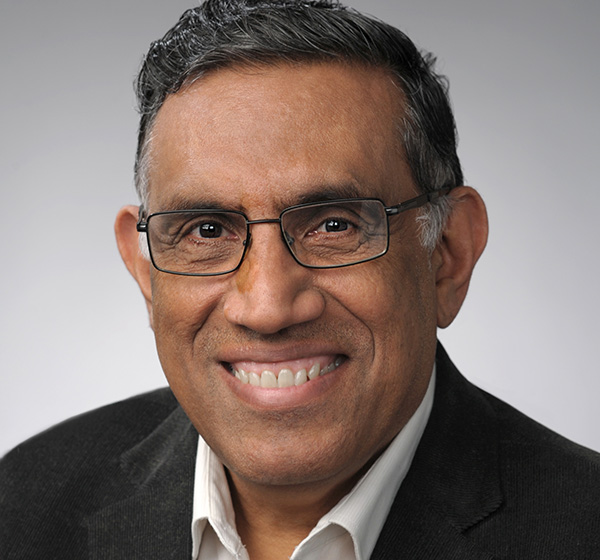
Joining Syracuse University’s faculty at 23 years old, Distinguished Professor Pramod K. Varshney has exemplified Orange excellence. A world-renowned researcher and educator, he’s been recognized for his seminal contributions to information fusion and related fields, introducing new, innovative courses to the University. He’s also been an invaluable mentor to countless students on their academic and professional journeys. Supervising 68 Ph.D. dissertations thus far, he’s bolstered the career paths of many students.
Now, Pramod and his late wife Anju G’86, G’90 will continue their support for the University by creating a legacy that will impact generations to come. “Anju and I bled Orange,” says Pramod. “What we wanted to do was leave a legacy which would keep and grow the excellence that we have at Syracuse University in the mission of education.”
The Varshneys have established the Pramod and Anju Varshney Endowed Faculty Fellowship to recognize and support a promising research-focused scholar dedicated to mentoring doctoral students, just as Pramod has. This esteemed professor will hold a full-time faculty position in the Department of Electrical Engineering and Computer Science (EECS) within the College of Engineering and Computer Science (ECS).
“The person [for this position] should be an agent of change,” says Pramod. “They should be transformational in research but have something else—a discovery that will serve humanity, working with groups that are outside of the University, or helping underprivileged students to realize their dream of going to college. Do something in our society that makes a difference.”
This fellowship is yet another example of Pramod and Anju’s commitment to promoting excellence at Syracuse University. In 2018, they established an endowed fund that provides annual scholarships and financial assistance to EECS graduate students pursuing their doctorates.
“The first ECS news story I ever read was about Pramod and Anju’s dedication to EECS Ph.D. students,” says Dean J. Cole Smith. “In reading that article, I was instantly struck by how much they mean to Syracuse University and what a lasting impact they have had on countless generations of ECS students. Now, the Varshney Endowed Faculty Fellowship will support and honor EECS faculty members as they set out to make their own research and societal impacts.”
This continued support reflects the Varshney’s dedication to empowering students to become leading figures in their fields—a sentiment shared by many of Pramod’s former students.
“I consider myself fortunate that Professor Varshney was my Ph.D. advisor at Syracuse University,” says Kotikalapudi Sriram G ’83, a former doctoral student. “He remains a true source of inspiration and professional support for me and many former SU students I know.”
“His guidance has meant everything to me—shaping not only my academic and professional growth but also my approach to problem-solving and collaboration,” says former doctoral student Engin Masazade G’10. “His unwavering support, insightful advice, and dedication to his students have had a profound impact on my journey, and I am incredibly grateful to have learned from him.”
Pramod hopes this fellowship will set a precedent of appreciation for the college, inspiring others to give back to the University. “I’ve loved being able to interact with a large number of graduate students from all over the world, who have gone on to do great things,” says Pramod. “My hope is that this fellowship will help keep the University and EECS growing, becoming further well-known around the world as a great place for education and scholarship.”
Exploring Artificial Intelligence through Immersive Internships
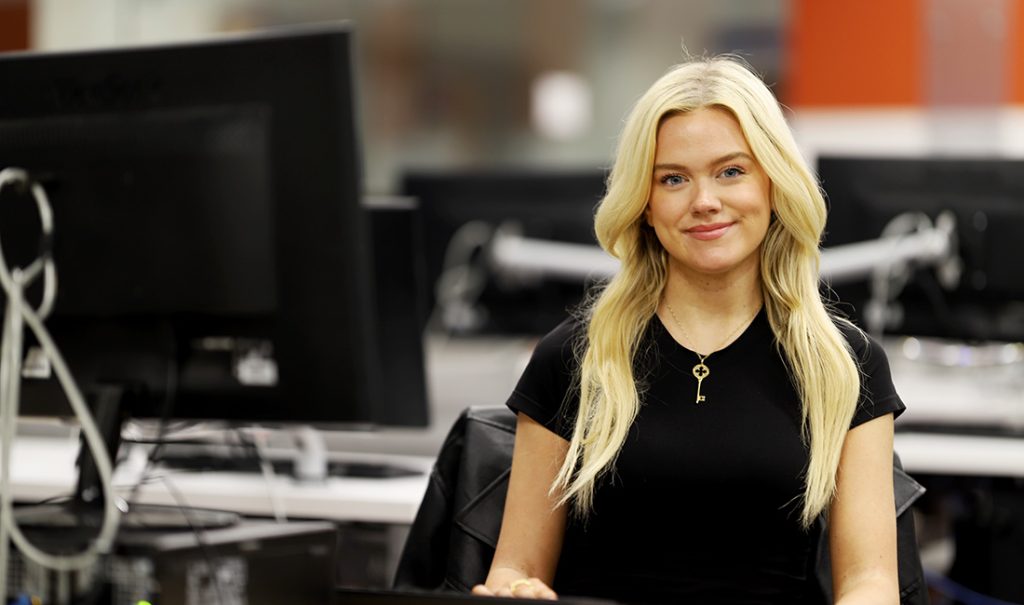
After completing an “Intro to AI” course in the College of Engineering and Computer Science (ECS), Emma Bellai ’25 was eager to apply everything she learned in class to her internship with Verizon. Joining the Global Network and Technology team as an AI intern, the timing was perfect, as the AI boom in recent years opened exciting opportunities for exploration in this field.
“One class is all it takes to make the difference and that’s what happened to me,” says Bellai, a computer science student.
In just 10 weeks, Bellai explored how prompt engineering and personas are used in AI chatbots and her background in AI research was a huge help. Prompt engineering involves writing instructions that guide AI chatbots to respond to questions or complete tasks. Personas guide the chatbot’s tone of voice or the way the chatbot speaks. Using specific personas are a great way to make AI chatbots sound more human, which helps personalize their responses.
“The chatbot would talk differently to a CEO than it would to a software engineer,” says Bellai. “The main focus of my work was seeing how to optimize personas for different people. To see the results of my work and having an application on the website that I worked on was very rewarding.”
A typical day at the office involved researching the latest developments in AI, preparing presentations on new concepts she was learning and communicating with her team and personal mentor. Interns were encouraged to engage with others in the company through coffee chats, and Bellai had the opportunity to speak with many employees, including senior leadership and the CEO.
“They wanted to hear from young voices and AI applications from my perspective,” says Bellai. “I got to speak with the CEO at least two or three times, which is great because I feel like at other companies, you don’t get that opportunity.”
Interning with Verizon connected Bellai with the company’s extensive network of professionals, including Syracuse University alumni. She also had an opportunity to share her experiences and insights during a live stream to the entire company. Bellai’s hard work and enthusiasm for her role paid off, as she was offered a full-time position and will return to Verizon after graduation.
“If you have a really great professor that makes you genuinely care about the topic you’re learning about, it can make such a big difference down the line,” says Bellai. “ECS gave me the confidence to go into the internship and I felt like I was put in a good position to thrive.”
2025 One University Awards Ceremony to Honor Members of the College of Engineering and Computer Science

Members of the College of Engineering and Computer Science will be honored at the annual One University Awards Ceremony for their excellence in academics, work and dedicated service. The ceremony will be held Friday, April 11, from 1 to 2:30 p.m. in Hendricks Chapel. The following awards will be presented:
Outstanding Contributions to the Student Experience and University Initiatives
Farzana Rahman, Associate Teaching Professor in Electrical Engineering and Computer Science
This award acknowledges faculty and staff who, through their work, enhance the undergraduate experience for students or make invaluable contributions to supporting and advancing the University’s mission and goals.
The Faculty Excellence and Scholarly Distinction Award
Shikha Nangia, Professor and Biomedical and Chemical Engineering Department Chair
This award is intended for faculty members who are collaborators in work of intellectual richness that has the potential for future impact. The work of these nominees offers possibilities for collaboration within the University and outside in partnership with others.
Student-Athlete Award
Emma Klein, Chemical Engineering Student and Women’s Soccer
This award recognizes the top female and top male student athletes and are presented to the senior student-athletes with the highest cumulative grade point average over the course of their academic and athletic careers.
The 2022-2025 Meredith Professors
Julie Hasenwinkel, Associate Provost for Academic Programs
Alexander Deyhim (Early Performance), Kenneth and Mary Ann Shaw Professor of Practice in Entrepreneurial Leadership
The Laura J. and L. Douglas Meredith Professorships for Teaching Excellence were created in 1995 to recognize and reward outstanding teaching among faculty. In 2001, the Meredith Professorship Program was expanded to recognize teaching excellence by non-tenured faculty and adjunct and part-time instructors.
Visit Syracuse University News for more information.
Study Tips from ECS Peer Leaders

As the end of the spring semester and final exams approach, we’ve gathered some tips from ECS peer leaders on how they study for exams. Here’s what they had to say:

Isabella Perkins | Chemical Engineering | 2025
- Create your own study guides for classes: making the study guide is a form of studying in itself.
- Make sure you’re going to the professor’s office hours to clear up any questions you had on any past coursework.
- Try to work through practice questions or rework homework questions without referencing your notes.
- Take frequent breaks when studying for long periods of time and make sure you’re eating and drinking enough.
- Switch between subjects every once and a while when studying to prevent burnout.

Michael Wehrle | Mechanical Engineering | 2025
- As a senior, I’ve gained a lot of experience in tackling challenging coursework. During my freshman year, I primarily studied alone in my room and managed to achieve decent grades. However, in my sophomore year, I began to bond with other mechanical and aerospace engineering students, and we formed a small study group.
- Collaborating with classmates made a significant difference; we would post problems on whiteboards and work through them together. Discussing concepts and explaining problems to one another enhanced our understanding and benefited the entire group.
- From my experience at Syracuse, I’ve found that bringing a pack of Expo markers to a study room or classroom is one of the most effective ways to prepare for tough exams.
- I will always be grateful for stepping out of my comfort zone to study with other students. We’re all in the same boat, tackling challenging classes, and having support makes a world of difference compared to struggling alone. I’m really glad I reached out and built friendships; we still stay close and not only study together but also enjoy time together socially.

Kana Wong | Civil Engineering | 2025
- I study by retaking notes, putting together a good cheat sheet, and redoing homework problems or practice exams.
- To combat stress, I try to get things done early when I know that exams are coming up.
- I find time to do work around my clubs and social life because I’ve found that without those scheduled breaks, studying becomes much harder and less productive.
Distinguished Professor in Biomedical and Chemical Engineering Radhakrishna (Suresh) Sureshkumar Featured in American Chemical Society (ACS) Publication
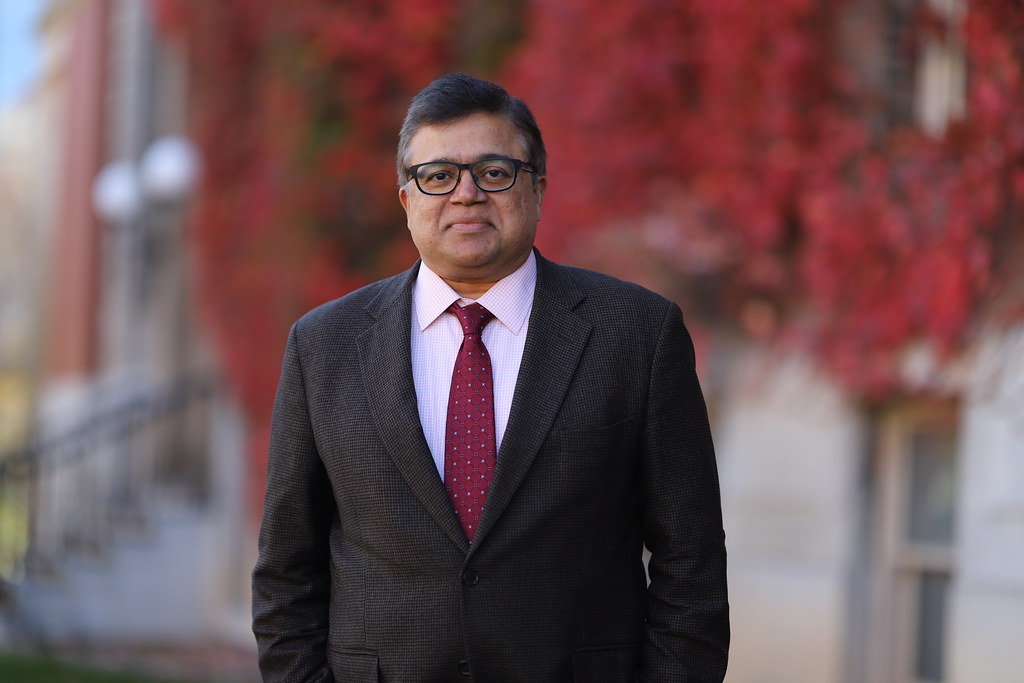
Distinguished Professor of Chemical Engineering Radhakrishna (Suresh) Sureshkumar and his former doctorate student Senyuan Liu G’24, in collaboration with the BioInspired Institute, authored a paper that was featured on the front cover of the leading scientific journal Langmuir. The journal is published by the American Chemical Society (ACS). Their research was supported by the ACS Petroleum Research Fund.
In 2010, Sureshkumar and his colleagues published a paper in Nature Materials where they found that surfactants, or soapy solutions, change into a gel-like material when exposed to a strong flow. This change happens because the flow rearranges the molecular assemblies in the solution into larger structures instead of breaking them apart—a behavior that is rather counter-intuitive.
Liu and Sureshkumar presented the mechanisms underlying the formation of such flow-induced structures in their recent paper. Specifically, they used molecular dynamics simulations to study how the shape and internal makeup of molecular assemblies change when exposed to flow cycles. Flow-induced structures are useful for targeted drug delivery, medical diagnostics and creating functional nanomaterials.
“This is an important milestone in my academic journey,” says Sureshkumar. “It’s indeed gratifying that Senyuan and I are able to provide a deeper understanding of flow-mediated molecular reorganization based on the principles of fluid mechanics and thermodynamics.”
Electrical Engineering and Computer Science Professor Reza Zafarani Receives Test of Time Award from the Association for Computing Machinery (ACM)
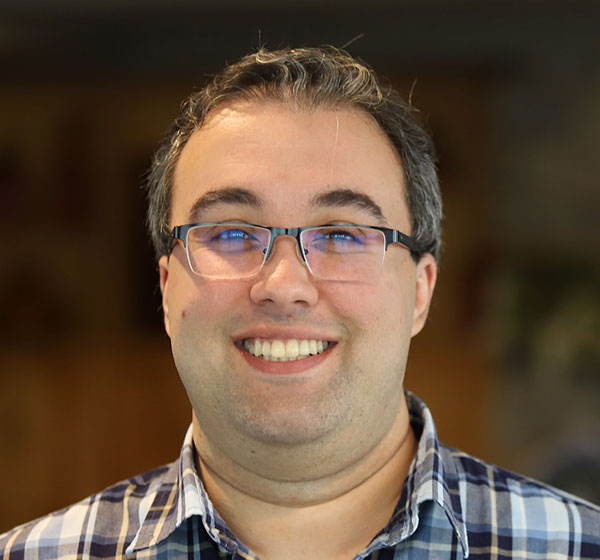
Reza Zafarani, associate professor in electrical engineering and computer science, has received the Test of Time Award from the Web Search and Data Mining (WSDM) Conference organized by the Association for Computing Machinery (ACM). The award was presented at this year’s conference in Hanover, Germany.
WSDM publishes original, high-quality papers related to search and data mining on the web and the social web. It also hosts a highly selective conference that includes invited talks and peer-reviewed papers. The Test of Time Award recognizes published papers that have had a significant impact on the field of computing over an extended period of time.
Zafarani was awarded for the paper titled “Sarcasm Detection on Twitter: A Behavioral Modeling Approach” which discussed “detecting sarcasm automatically using textual data that users generate.” The key contribution of the paper is in integrating social science theories with machine learning techniques where the machine learning model incorporates social science findings across different disciplines such as linguistics, communication, philosophy and psychology.
The WSDM conference has provided the following statement in recognition of the contributions provided by this paper: “This landmark paper studies a fundamental and difficult problem in understanding web contents, with a general approach grounded in psychology. It is one of the most important works on sarcasm detection, a problem that is of great relevance in coping with today’s polarizing social media. In full generality and with evolving sophistication of user texts, the problem is still unsolved even with large language models. This WSDM 2015 paper will have lasting value, by guiding modern AI in understanding sarcasm.”
Robotics and Rehabilitation
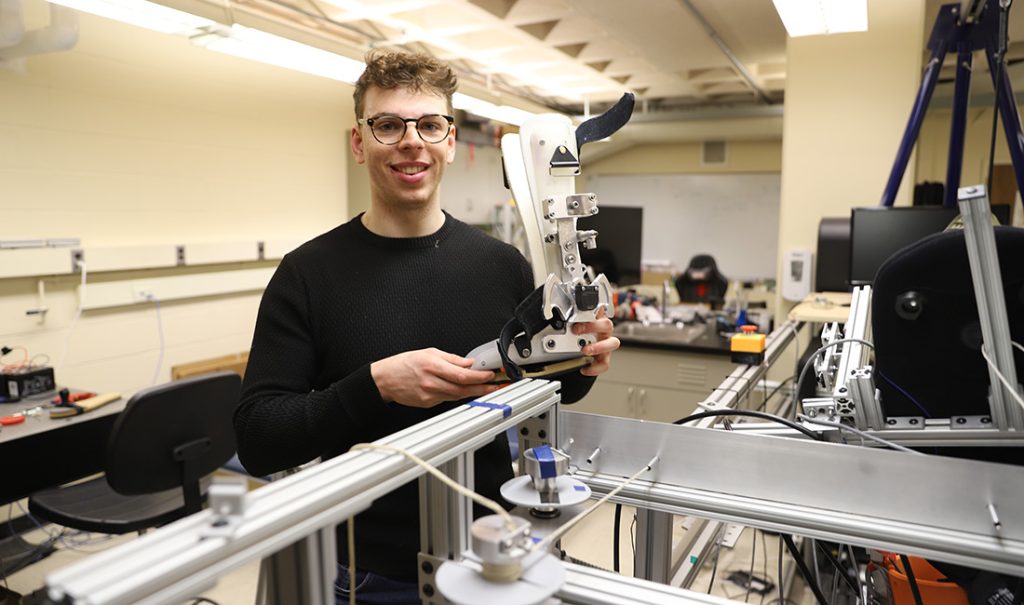
Observing his father’s work in physical therapy research and cognition tests, Evan Tulsky’s ’24 interest in robotics and rehabilitation took shape at a young age. He recognized the crucial role that rehabilitation devices play in transforming people’s lives, motivating him to pursue research in this field while attending Syracuse University. This path would lead him to the Bionics, Systems and Controls (BSC) Lab, an interdisciplinary research space centered around robotics and rehabilitation.
“I’ve always been fascinated by the intersection of control systems, dynamics and rehabilitative devices,” says the mechanical engineering graduate student. “I was raised around research, and this was the best place for it. This is a really cool lab.”
Led by Victor Duenas, assistant professor in mechanical and aerospace engineering, the BSC Lab focuses on individuals who have had strokes or other neurological conditions that affect the brain, spinal cord, or nerves. Tulsky joined the lab as an undergraduate research assistant and is now pursuing his Ph.D., where he’s been building devices that support hip, foot and ankle movements.
Because the muscles and joints in the lower body work together, problems in one area can impact the others during movement. A robotic ankle-foot device and hip exoskeleton could help individuals with hip and knee issues since ankle pain can put stress on the hip and knee.
“If you’re working on an ankle and hip device, you’re working on the entire leg—they’re interconnected,” says Tulsky. “The goal is to develop devices that support all three joints and different movements.”
The lower limb exoskeleton—a wearable device that helps with walking, standing and other lower limb bodily functions—is the latest project in development in the BSC Lab, which Tulsky has been assisting with. This exoskeleton will give individuals with spinal cord injuries or strokes balance and flexibility, allowing them to rotate their legs naturally around their pelvis and hip area.
“Most exoskeletons don’t focus on foot placement and balance,” Tulsky explains. “People with spinal cord injuries can’t land on their foot well. With this device, we’re trying to make motions as natural as possible and help people regain their confidence.”
Tulsky’s graduate studies build upon his research in muscle activity, particularly electromyography (EMG). EMG measures the electrical activity of muscles and nerves and is a great way to assess the health of nerves and muscles that allow movement and other bodily functions. He would present a research paper on EMG and muscle activity in the ankle and foot at the Institute of Electrical and Electronics Engineers (IEEE) Conference on Controls, Technology and Applications. The conference took place in England in 2024.
The BSC Lab conducts research in collaboration with the Syracuse Veterans Affairs Medical Center since the University has a well-established history with the veteran population. Tulsky has been honored as the Richard A. Bernard Scholar for his efforts in assisting the disabled population and received recognition for the best thesis in engineering.
“My journey is driven by a deep-seated passion to leverage technology for enhancing human health and quality of life. I aspire to continue contributing to innovations that advance the field of rehabilitative robotics and empower individuals facing physical limitations.”
Pioneering Research in Wound Treatment

While tourniquets and gauze have long been the standard for treating traumatic wounds, they have major limitations. Tourniquets restrict blood flow, damage skin tissue, and aren’t suitable for use on injuries to the neck or torso. When removed from wounds, gauze may also cause more bleeding. These challenges have driven the research conducted in the Monroe Biomaterials Lab, where biomedical engineering graduate student Natalie Petryk ’21, G’22, G’25 has been involved in pivotal research on degradable foams for treating traumatic wounds.
“There’s a huge need for it,” says Petryk. “The big picture goal is to create effective, affordable hemostatic foams that can be used in every first aid kit and replace current options.”
The foams Petryk has been researching are made from a polymer material called polyurethane, which is commonly used in insulations, bedding, and furniture. Polyurethane foams are porous and absorbent, like a sponge, and compatible with cells and blood, making them effective at controlling bleeding in a wound.
Petryk’s main goal has been to make degradable foam that can break down in the presence of water and oxygen found in blood and skin tissue. This would eliminate the need for foam removal and reduce the risk of wound re-bleeding typically associated with tourniquets and gauze.
“What I enjoy most about the lab space is the ability to do everything from synthesizing the foams to characterizing their material properties, like mechanical and thermal behavior, and exploring biological responses, like how cells and blood interact with the material,” says Petryk. “You acquire a wide breadth of knowledge working in the lab.”
Throughout Petryk’s undergraduate, master’s, and Ph.D. studies, she has explored different aspects of these foams to improve their healing capability. Her recent work focused on altering the foam’s chemistry to improve how quickly it degrades and studying how this change in molecular structure impacts the foam’s properties and bleeding control. She has also explored ways these polymer foams could help the healing process with collagen and gelatin, the main building blocks of the body’s skin, muscles, and connective tissues.
“We’ve been thinking about ways to incorporate bioactive components into the foams, something our native tissue is familiar with to promote and encourage cell growth and healing,” Petryk says. “Polyurethane foams are ideal for blood clotting, and we can control their degradation rates, but they are a synthetic material, so cells can’t directly attach. Proteins like gelatin and collagen can drive cell attachment on the foams to facilitate tissue regeneration.”
Working in the Monroe Biomaterials Lab, led by Biomedical and Chemical Engineering Professor Mary Beth Monroe, Petryk is continually inspired by her research and work ethic. “Dr. Monroe has been the best mentor,” Petryk says. “Having a female role model to look up to in the STEM field is truly empowering. Dr. Monroe is extremely supportive and allows us to explore research interests that align with our future goals.”
Petryk presented her research on degradable foams at the American Chemical Society, where she connected with other chemists and gained valuable insights. She also presented her research at the College of Engineering and Computer Science’s annual Research Day, where she won second place for her oral presentation. Additionally, Petryk shared her work at the Society for Biomaterials Northeast Regional Symposia. “Communicating research with a broader audience is really important,” says Petryk. “It makes people care about your work, which can help its societal and clinical impact.”
In Memory of Renowned Chemical Engineering Alum Andreas Acrivos ’50
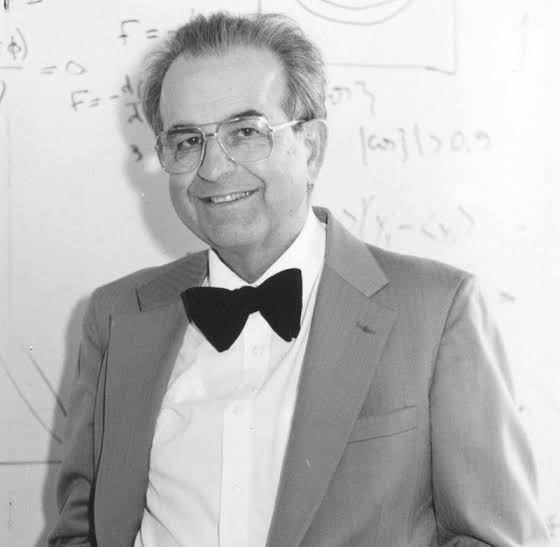
With a heavy heart, the College of Engineering and Computer Science (ECS) announces the passing of chemical engineering alum, Andreas Acrivos ’50, on February 17, 2025. Acrivos was recognized by the American Institute of Physics as one of the greatest fluid dynamicists of the 20th century and was a leading figure in the chemical engineering field.
Born in Greece, he came to the U.S. to study at Syracuse University on a fellowship and received a bachelor’s in chemical engineering in 1950. He earned a Ph.D. degree from the University of Minnesota in 1954 and began his academic career as a faculty member in chemical engineering at the University of California, Berkeley shortly after.
In 1962, he moved to the newly formed chemical engineering department at Stanford University and played a major role in bringing the chemical engineering program to national prominence. In 1986, Acrivos became the Albert Einstein Professor of Science and Engineering and the Director of the Benjamin Levich Institute for Physico-Chemical Hydrodynamics at the City College of New York, where he worked until his retirement in 2001.
Acrivos won numerous awards and recognitions for his research. He was a member of the National Academy of Engineering, the National Academy of Sciences, and the Academy of Arts and Sciences. He served as editor-in-chief of the scientific journal Physics of Fluids from 1982 to 1997. He received the National Medal of Science from President George Bush in 2002 and was awarded Honorary Doctor of Science degrees from several universities. During his long academic career, he also mentored numerous students, many of whom distinguished themselves in academia and the industry.
“The two-quarter course that Professor Acrivos taught at Stanford was the most memorable course I ever took in my entire education,” says biomedical and chemical engineering professor Ashok Sangani, who was one of Acrivos’ graduate advisees. “The course was so good that I have been teaching the same material at Syracuse University over the past 40 years even though there is a lot of temptation to add more. It was simply a classic!”
As a fitting tribute to his monumental mentorship, the American Physical Society named its annual award for the outstanding doctoral dissertation in fluid dynamics after Acrivos. Since 2014, the American Institute of Chemical Engineers has also given the Andreas Acrivos Award for Professional Progress in Chemical Engineering to individuals who have made significant contributions to chemical engineering.
Acrivos’s enduring legacy is reflected in his stellar academic family, which spans approximately four generations of scholars teaching at various universities across the United States and the world. Additionally, he was a great support of ECS and its commitment to providing its students with transformative learning experiences. His impact will be felt for generations to come.
Advancing Women Engineers Hosts Professional Networking Event
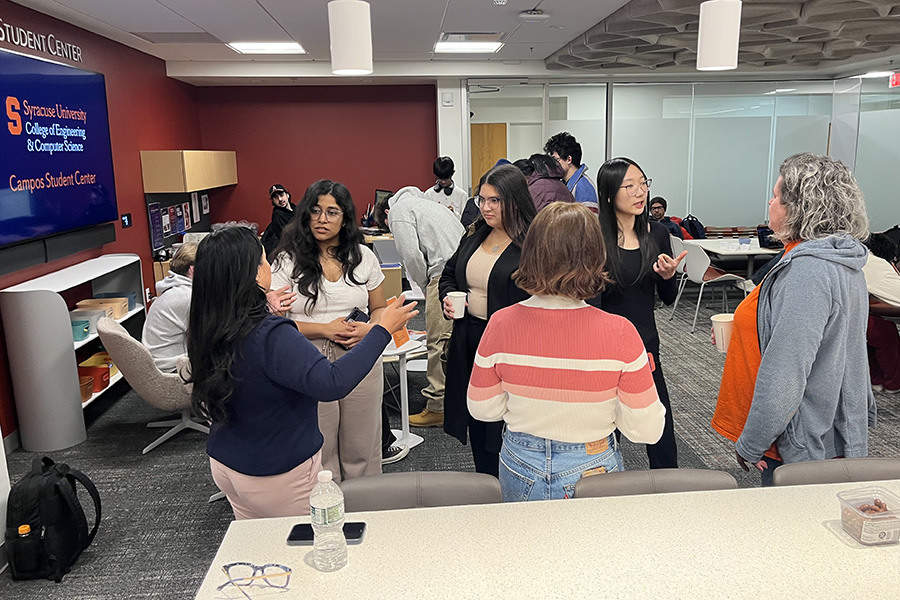
In celebration of National Engineers Week, Advancing Women Engineers (AWE) held a professional networking event where students could connect with alumnae from the College of Engineering and Computer Science (ECS). Students engaged in meaningful conversations with former ECS graduates on topics ranging from soft skills and imposter syndrome to work-life balance and career growth.
“This event is more than just career prep—it’s about building a strong community where students in engineering can support, inspire and empower one another,” says Heather Carroll, assistant director of alumni and donor engagement.
Alumnae who attended the networking event included Gay Kasegrande ’93, senior group leader at Mondelēz International, Inc., who earned a bachelor’s in chemical engineering in 1993 and Dawn Penniman ’90, G’97, certified senior project engineer II at ARCADIS, who earned a bachelor’s in civil engineering in 1990 and master’s in environmental engineering in 1997.
“It was a great experience! I loved talking to alumni and gaining insights about networking and career pathways, ” says computer science student Adya Parida ’25.
“It was great speaking with alumnae,” says Liv Ochtabec ’28. “They provided us with support and advice that will benefit me in my career growth.
“The alumnae provided students with useful advice for networking and career development. For me, it emphasized the breadth and diversity of the SU alumni community and how we can use it to our benefit” says aerospace engineering student Aliza Willsey.
AWE plans to continue hosting events to engage both alumnae and students through networking opportunities, immersive programming and virtual conferences to empower the next generations of students for success.
Aerospace Engineering Student Tatiyyanah Nelums ’25 Joins Patti Grace Smith Fellowship
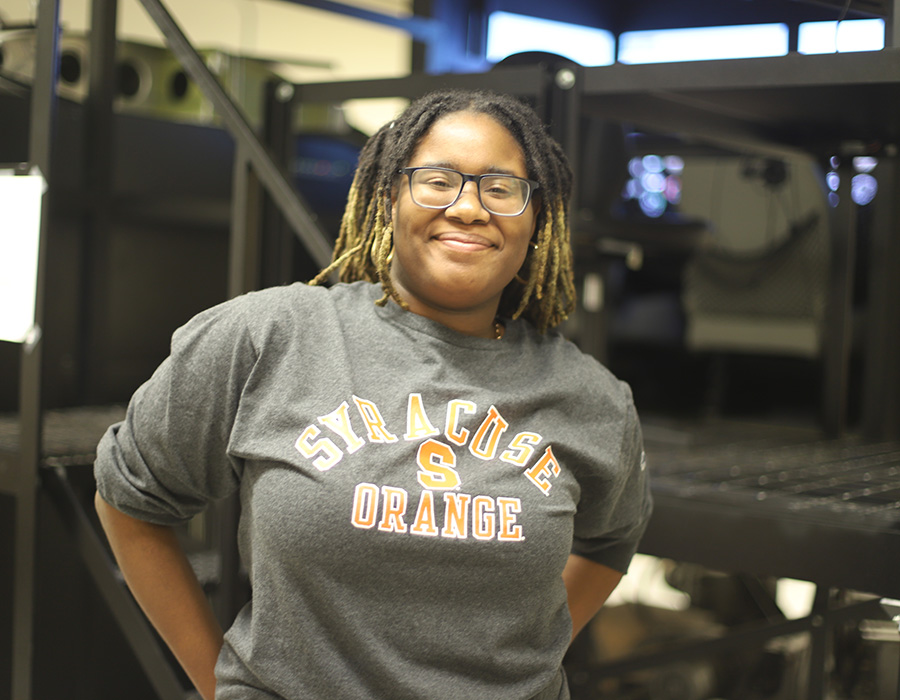
Aerospace engineering student Tatiyyanah Nelums ’25 was selected by the national nonprofit Patti Grace Smith Fellowship as a member of its latest cohort. The program is designed to support the careers of Black aerospace leaders. As part of the fellowship, Nelums will participate in a challenging summer aerospace internship at one of America’s leading aerospace companies. They will also receive a scholarship, personalized mentorship and access to a community of young Black professionals pursuing careers in aerospace.
Nelums conducts research in computational fluid dynamics and aims to work in the commercial space sector. They are the co-president of the Syracuse University branch of the American Institute of Aeronautics and Astronautics (AIAA) and serve as the aerodynamics and propulsion lead for Syracuse’s AIAA Design/Build/Fly team. As part of the fellowship, Nelums will be working at the research and development company Draper during the summer.
“Tatiyyanah’s fellowship is a recognition of their academic achievement and leadership skills as demonstrated during their studies in Syracuse. As their instructor in airbreathing and rocket propulsion, I can attest that they are well-equipped to succeed in the aerospace field. This award further sets them on that path to success,” says Ben Akih Kumgeh, associate professor and aerospace engineering undergraduate program director.
“Being a part of this fellowship is an amazing opportunity, and I am proud to be included in such an amazing program,” says Nelums. “It is not often that I get to interact with people in my field who look like me, so this representation matters a lot to me.”
Electrical Engineering and Computer Science Professor Moamer Hasanovic Awarded National Science Foundation (NSF) Grant for Quantum Workforce Development
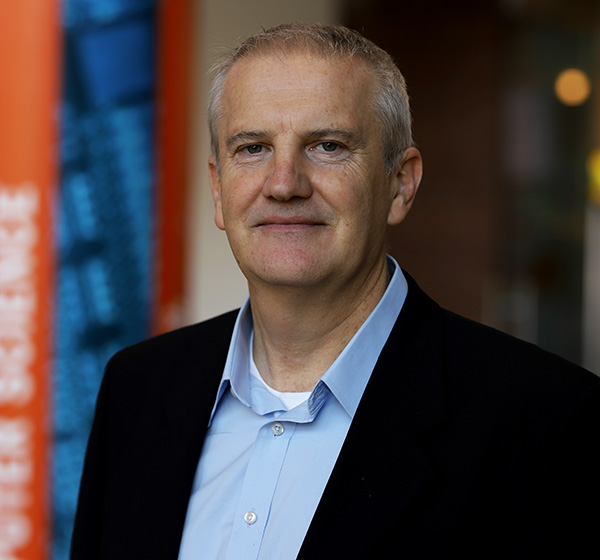
As quantum science advances, there is a growing demand for skilled professionals who can apply quantum technology and develop commercial products. To address this need, Moamer Hasanovic, assistant teaching professor in electrical engineering and computer science, has received a grant from the National Science Foundation (NSF) to provide training, education, and career development for quantum technicians. This initiative supports Syracuse University’s mission to remain a leading research institution while expanding its quantum educational programs.
Hasanovic previously developed a quantum curriculum, known as the EdQuantum Project, which provides quantum technicians—specialists who assist researchers in the lab—with the necessary skills required for the workforce. The curriculum consists of three courses in quantum technologies that combine theory and hands-on activities to raise awareness and build essential knowledge in quantum information science at a technician level.
As part of ongoing efforts to raise awareness of quantum programs, Hasanovic has visited numerous community colleges to lead workshops and strengthen relationships with academic institutions such as Onondaga Community College, State University of New York Broome Community College, and Jefferson Community College, among other colleges regionally and nationally.
While attending quantum conferences across the country, Hasanovic has gathered information from the industry to enhance his curriculum and has been working on establishing a laboratory at Syracuse University that will support local community colleges as well as the University’s undergraduate program. The NSF grant award will play a crucial role in advancing these initiatives.
“We are very much ahead of the curve. There’s no one in the nation doing quantum at the community college level and we can lead these efforts. We’re expanding the program’s outreach, establishing collaborations to bring funding to the University and creating a quantum center,” says Hasanovic.
Some partners that Professor Hasanovic is collaborating with include the Quantum Economic Development Consortium, Chicago Quantum Exchange, Duke Quantum Center, University of Chicago, Georgetown University, Colgate University, and the University of Queensland in Australia. He will also introduce quantum science into K-12 and undergraduate programs to provide a firm foundation for the emerging workforce.
“We have to collaborate more. We don’t have to build labs across the nation that are costly. Nothing is impossible if we share the resources we have,” says Hasanovic. “I’m grateful for the NSF award and how it will impact the future of the quantum workforce.”
New Campos Student Center Opens in the College of Engineering and Computer Science
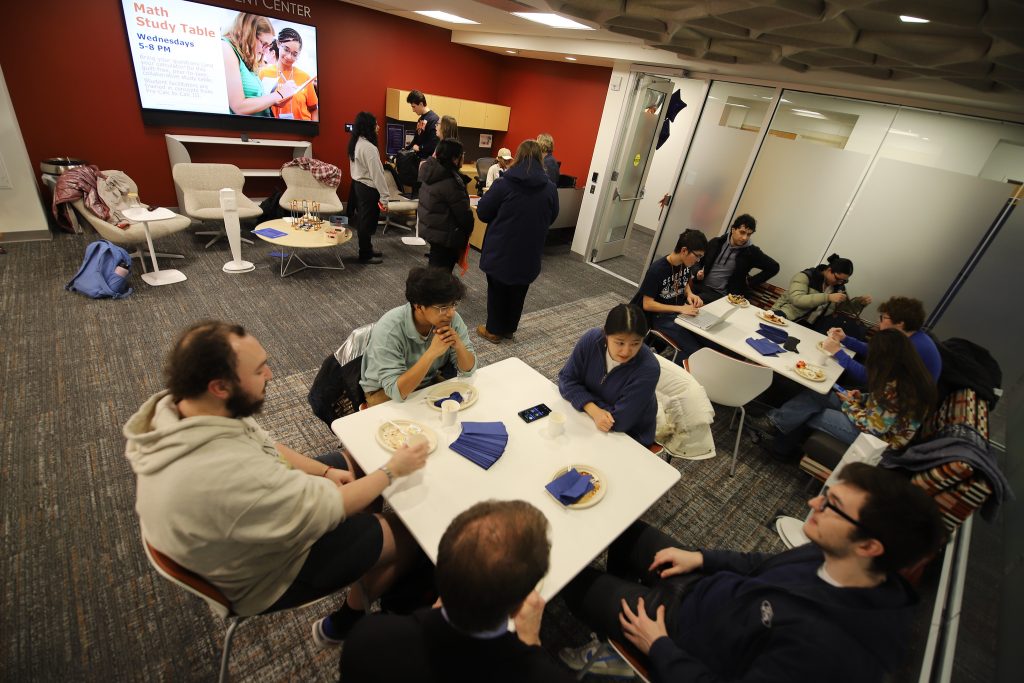
The College of Engineering and Computer Science (ECS) is excited to announce the opening of the Campos Student Center, a new community space designed for ECS students. The center celebrated its opening last week with a waffle bar, games and giveaways for attendees. Located on the second floor of the Center of Science and Technology, the Campos Student Center is a welcoming home-away-from-home where students can receive academic support, connect to campus resources and find a sense of community and belonging.
“Our overarching mission is to promote a sense of belonging for the breadth of undergraduates who comprise our college,” says Abby Fite G’18, director of inclusive excellence.
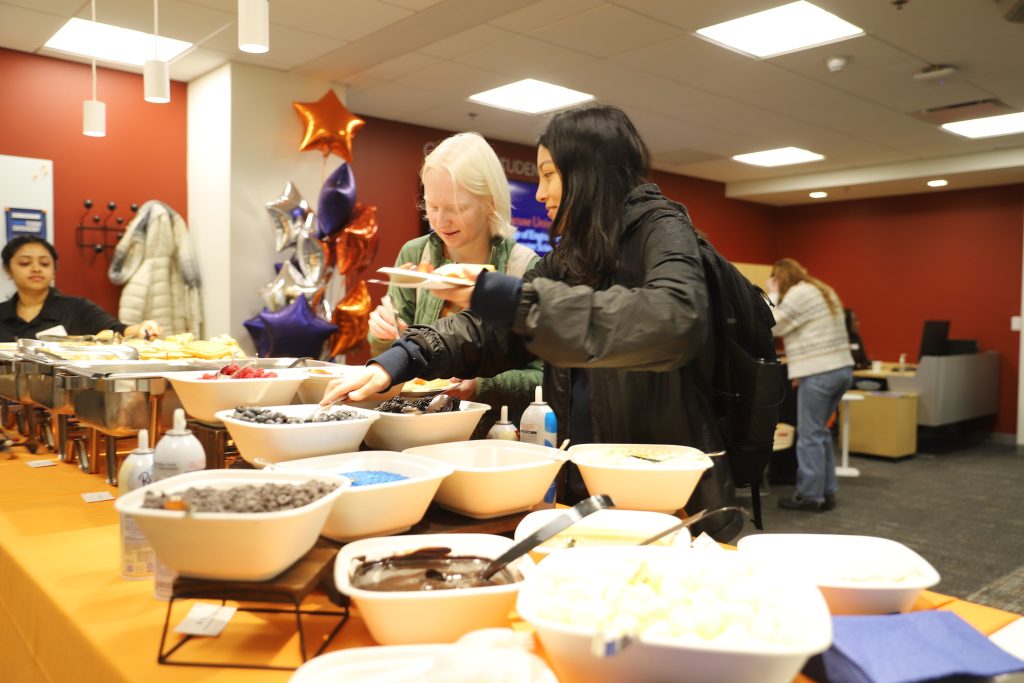
“There isn’t a space like this in the Life Sciences Building so it gives students an opportunity and place where they can come and study,” says computer science student Brianna Anthony ’26.
Established by Marco Campos and his sister Deanna Campos Miller to make STEM accessible to all students, the student center offers a variety of weekly programs that foster community-building and collaboration. These weekly programs include study sessions for programming on Mondays, open study tables on Tuesdays, math study tables on Wednesdays, Thriving Thursdays, and a weekly wind down on Fridays.
“I’m really excited for this space,” says computer science student Jenna Ballback ’26. “On Mondays, I’m running the computer programming study table. There’s a different thing going on every day.”
In celebration of National Engineers Week, the Campos Student Center will offer free headshots taken by a professional photographer on February 19 from 11 a.m. to 5 p.m. All students have the option to participate in the #ILookLikeAnEngineer campaign, which highlights the breadth of people in engineering.

“It feels very homely, I like the couches,” says civil engineering student Kevin Guerrero ’28. “I also really like the campaign slogan, #ILookLikeAnEngineer. A lot of people think of a specific picture when thinking about an engineer so it’s nice having a campaign that celebrates all of us.”
“I think the center meets the needs of what Abby was going for, which is comfortability,” says civil engineering Candance Tabb ’26. “It’s very cozy and close-knit and it’s a space for students to be themselves.”
“Belonging is a reliable predictor of retention and graduation, so we see this as integral to our academic mission,” Fite says. “It’s also a predictor for a range of wellness outcomes, so we also see this as integral to our ethical mission to care for our students.”
Exploring the Toughness of Bamboo Skin Through Artificial Intelligence
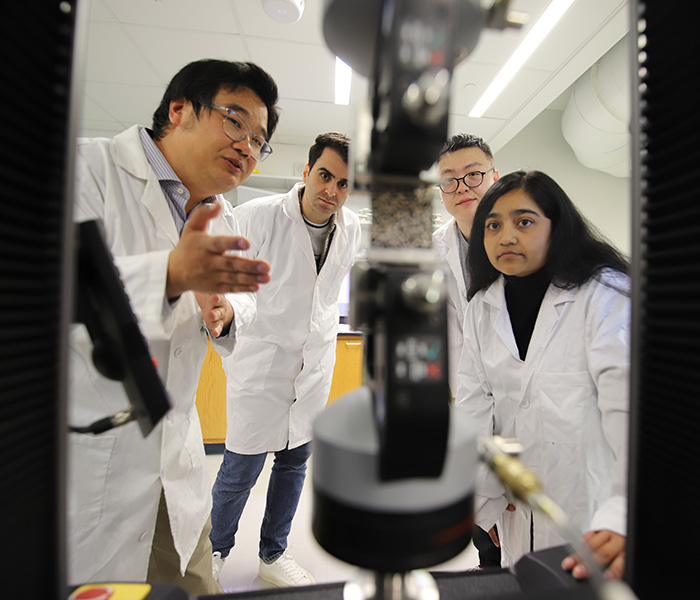
Bamboo is a fast-growing and renewable plant that has important environmental benefits. It grows in many different climates, captures carbon and its root system improves soil health while preventing soil erosion. Bamboo’s natural strength and flexibility have also made it a great alternative to timber and metals for buildings, scaffolding, and many other manufacturing uses.
Studies have shown that bamboo’s outer layer is actually stronger than its inner layers. Known as the epidermis, bamboo’s outer layer is smooth and dense, containing cellulose fiber and silica particles, which contribute to the plant’s functionality and durability. Silica particles in particular may strengthen and help plants like bamboo withstand environmental stresses.
For decades, researchers have been attempting to understand how the low amount of silica particles helps strengthen the outer layer of bamboo and prevent the inner fibers from splitting. To explore this concept, Zhao Qin, assistant professor in civil and environmental engineering, combined theoretical analysis, experimental imaging, generative artificial intelligence (AI) and 3D printing to study how the arrangement of silica particles affects bamboo.
“There are individual particles embedded in the matrix material of bamboo skin,” says Qin. “We realized in the microscopic images of bamboo skin, we see when there are cracks. These cracks will be captured by the silica particles because they are harder and stiffer than the matrix. So, the crack will not propagate straight through the bamboo, but instead, it gives you the zig-zag pathway to dissipate more energy.”
When studying the structure of bamboo skin, Qin found that it’s a composite material, meaning bamboo skin is made from two or more materials with different properties. This material includes soft cellulose fibers and rigid silica particles that are arranged differently in various directions. This arrangement makes the bamboo skin tougher and more durable.
“The silica particles are very ordered in the direction that is perpendicular to the bamboo fiber bundles, with dense areas located where the bundles meet,” says Qin. “Since fiber splitting is the main way bamboo fails under different stresses, such as buckling, bending, and twisting, the silica particles at the fiber junctions help increase the material’s toughness and prevent cracks from spreading. However, their distribution along the fiber is highly disordered.”
To understand how this arrangement affects the toughness of bamboo skin, Qin input his findings into generative AI and created a model based on the structure of bamboo skin. The AI model not only looks similar to actual bamboo skin but also breaks and withstands force in the same way. This research helps us understand the mechanics of bamboo skin better, discover ways to create materials similar to bamboo, or improve the strength of bamboo materials for sustainable development.
“Understanding how the bamboo epidermis works at the microscopic level can help us connect the beginning of mechanical cracks in bamboo with larger issues like buckling and splitting when under extreme pressure,” says Qin. “This understanding is essential for making bamboo products more durable. Additionally, insights gained from the bamboo epidermis can guide the design of composites by defining particle distribution in fiber-reinforced composites, which is important for sustainable construction and manufacturing techniques.”
Syracuse University and ANDRO Computational Solutions Awarded Navy Contract for AI Spectrum Research
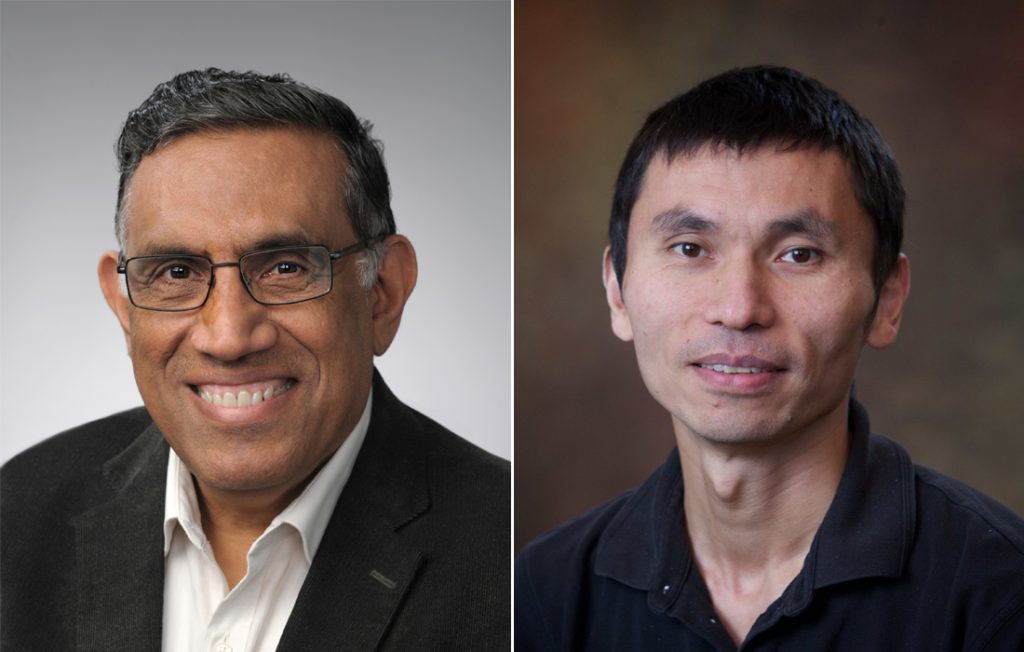
Syracuse University, in collaboration with ANDRO Computational Solutions, LLC, Marconi-Rosenblatt AI Innovation Lab of Rome, has been awarded a Phase II Small Business Technology Transfer (STTR) research contract by the Office of Naval Research (ONR) valued at approximately $2 million. This project focuses on pioneering research to integrate artificial intelligence (AI) deep learning technologies to enhance radio spectrum utilization in challenging conditions.
The project is led by Anu Jagannath, ANDRO Chief Scientist and Chief Research Officer, and Jithin Jagannath, ANDRO Chief Scientist and Chief Technology Officer (CTO). The lead project team at ANDRO also includes Senior Scientist Sabarish Krishna Moorthy, with support from Syracuse University professors Biao Chen and Pramod Varshney from the Department of Electrical Engineering and Computer Science. Their expertise contributes valuable insights into advanced signal processing and distributed systems modeling for the project.
The collaboration between ANDRO and Syracuse University showcases the power of academic-industry partnerships in tackling complex challenges. This collaboration has persisted for over 30 years and has benefited over the years from support from the Center for Advanced Systems and Engineering (CASE) which is a NYSTAR-designated Center for Advanced Technology (CAT). Under the STTR contract, the team is well-prepared to provide innovative solutions for both military and commercial applications. This venture aims to transform the landscape of intelligent spectrum technologies for various spectrum intelligence use cases.
Staying Ahead of the Game

Liesel Odden ’24 G ’25 knows all too well the challenges of being a student-athlete. One minute she’s in the research labs of Link Hall, the next minute, she’s boarding a bus for an away game in a different state. As the co-captain of Syracuse University’s women’s soccer team and a student in the College of Engineering and Computer Science (ECS), Odden juggles these responsibilities much like she juggles soccer balls on the field.
“One of the hardest parts about being a student-athlete is traveling. In the fall semester, over the course of 9 days, I was in Texas, Virginia and Florida,” says Odden. “But I’ve learned a lot more about time management since being in college.”
Playing soccer for as long as she can remember, Odden was thrilled to learn that Syracuse University’s team was in the Atlantic Coast Conference (ACC), widely recognized as the top conference for women’s soccer. And the chance to play her favorite sport while pursuing her research interests was appealing.
“My coaches made this place feel like home, and treated me like family,” she says. “I also saw Syracuse had environmental engineering and that, along with research opportunities, was exciting.”
Odden is enrolled in the 4+1 accelerated program for environmental engineering, a combined degree where students complete both their bachelor’s and master’s at the same time in five years, though she will complete both degrees early. She credits Civil and Environmental Engineering Professor Cliff Davidson with helping her discover this accelerated program and though the courseload is rigorous, it’s also been helpful. Online lectures make catching up on work much easier, especially when she’s on the road.
As a research assistant, Odden collaborates with Professor Davidson to analyze survey data on how different organizations respond to extreme weather events caused by climate change. Using information gathered from survey data, they’re attempting to find patterns between locations, organizations and strategies to respond to extreme weather events.
“With climate change, we’re going to be seeing a lot more flooding, droughts, heat waves and other extreme weather events so we need to have better ability to respond. I think that we can be prepared and respond better if we know how different people and organizations strategize.”
Displaying leadership qualities both on and off the field, Odden has traveled to Mixco, Guatemala for several summers, leading volunteer teams for Hogars Helping Hands, a non-profit organization founded by her parents. The non-profit focuses on supporting orphaned children and the local community, with volunteer groups building stoves, installing concrete floors, and painting village homes among other tasks.
With the help of professors Elizabeth Carter and John Trimmer, Odden also aims to establish a student chapter of Engineers Without Borders at Syracuse University. The organization develops sustainable engineering solutions for underprivileged communities.
“One of the biggest things I’ve learned from Dr. Carter and Dr. Trimmer is engineering in low-resource settings. We spent time looking into socioeconomic inequities in Dr. Carter’s class which I’ve really enjoyed and got even more passionate about.”
As Odden continues balancing her life as a student-athlete, she relies on her strong support system to achieve her goals and stay ahead of the game.
“I’ve always felt very encouraged by Dr. Davidson. He’s been an incredible mentor to me and I feel like I’ve learned a lot from him. Dr Trimmer and Dr. Carter have also both been super supportive of me as a student-athlete,” says Odden. “In ECS, I have felt very supported and love how much I’ve grown as a student and my passions have been fueled and cared for. After I’m done playing soccer, I’ll have a great environmental engineering background that I can have a career in.”
‘Cuse Baja: The Road Ahead

Ian Storrs ’24 joined ‘Cuse Baja as a wide-eyed freshman eager to build off-road vehicles for rough terrains. But to his surprise, the club once known for participating in rugged vehicle competitions had seemingly lost its drive. The impact of the pandemic, coupled with former members graduating, left the student organization without guidance. The club’s off-road vehicle was also just a frame, and the remaining members didn’t know how to complete it. As the club’s numbers began to dwindle, Storrs knew he had to do something.
Assuming the position as the club’s leader, Storrs worked hard to rebuild ‘Cuse Baja from the ground up, focusing on recruiting and training the next generation of engineers to take the wheel. Today, ‘Cuse Baja is a thriving student organization that actively competes across the country and the off-road vehicle that was nothing more than a simple frame is now breaking records.
“The development of our current car has been a long road. With a large amount of reverse-engineering and scrappiness, we managed to cobble together a functional car,” says Storrs.
Despite challenges in their early competitions, ‘Cuse Baja didn’t let any roadblocks slow them down. And in September 2024, the club would set new records at the Baja Society of Automotive Engineers (SAE) competition held in Michigan. After undergoing rigorous inspections, the team competed at different events that tested their vehicle’s acceleration, maneuverability, suspension and traction as well as rock-crawling ability.
The final event on the last day of the competition was the endurance race, where each team that passed inspections strives to complete as many laps as possible in 4 hours. ‘Cuse Baja was able to complete 15 laps, which was more than double the six laps they completed in a previous competition, making history as the best a Baja team had done at the University in over 20 years.
“We had gone from having never been to a competition to being legitimately competitive in only one year,” says Storrs. “Prior to us, a Baja team from SU had not raced at a competition in 20 years, so we are enormously proud of our accomplishments.”
“This year was filled with many great successes allowing our team to meet multiple goals,” says aerospace engineering student Laney Price ’27. “However, when I look back at Michigan, I will not remember our scoring. I’ll remember the excitement our team felt and expressed during that week when we worked through many obstacles to reach that success.”
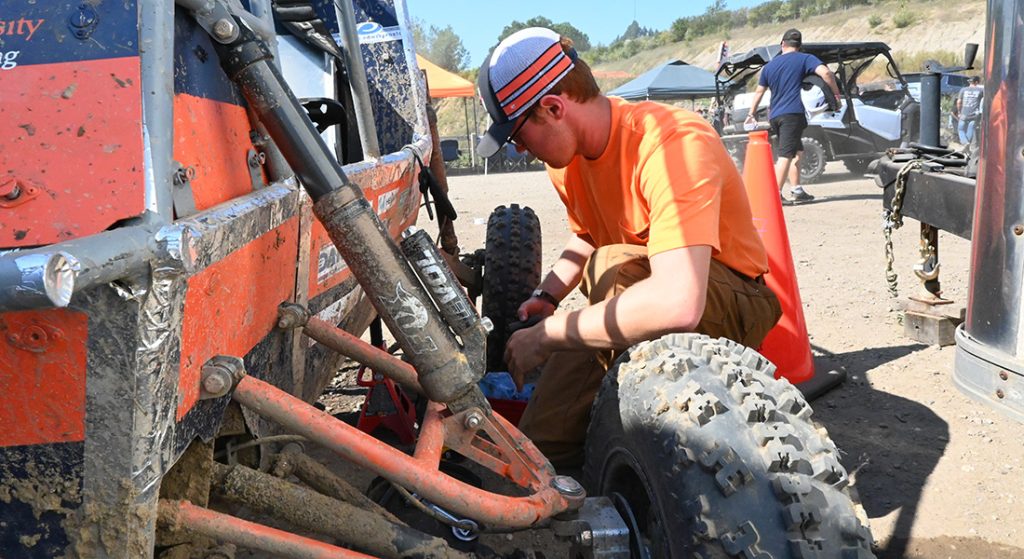
Through Cuse Baja, Storrs has connected with other students who share his passion for designing and building off-road vehicles and gained hands-on experience in engineering through machining and welding. As president and chief engineer, he has also developed valuable leadership skills that have strengthened his team-building and project management abilities.
“Throughout my leadership, I have made it my number one priority to recruit and train the next generation of ‘Cuse Baja members who will be able to grow the team after I have graduated,” says Storrs. “Our current success is due to the large influx of passionate and interested members over the past year, who have shown great initiative in learning and leading the team.”
“I became a member at the beginning of the 2023 school season and have witnessed ‘Cuse Baja grow so much since I’ve been on the team,” says mechanical engineering student Riehen Walsh ’27. “With a new generation car being designed and an ever-growing connection with the local Syracuse community, I look forward to seeing what the team can become in the upcoming years.”
Even as Storrs prepares to graduate, he believes the club will continue to thrive. “Baja and the other engineering teams are an invaluable addition to the ECS community, and are, in my opinion, undervalued. We provide practical and hands-on experience to students, which is something that cannot be taught in class. I hope that through our continued success and growth, we can further prove our value to the engineering community.”

Mechanical and Aerospace Engineering Alumna Spotlight: Emily Greaney ’21 G’22

When Emily Greaney ’21 G’22 faced the decision of where to attend college, she pictured a place that embodied the typical college experience – a campus with a beautiful landscape, great academic programs, and a vibrant school spirit with athletics and club sports. So when she came across Syracuse University during her search and saw everything the University had to offer, she knew it was the place to be.
“The programs were good, the campus had a collegiate feel, and it wasn’t too far from my home in New Jersey. I started playing ice hockey in high school senior year and SU had a club and D1 team, so it was an ideal school for me,” Greaney says.
Before graduating high school, Greaney initially planned to become a physical therapist but pivoted to engineering when she attended a summer camp at Stevens Institute of Technology in New Jersey. This experience would be crucial to discovering her passion for mechanical engineering.
“The summer camp touched on each engineering discipline. The mechanical module came up and we were playing soccer with robots” says Greaney. “It was taking all the things I loved, math, science, and physics, and putting it all together. After that, I knew mechanical was the way to go.”
Enrolling in the College of Engineering and Computer Science (ECS) as a mechanical engineering student, Greaney experienced what life at SU was all about. Joining clubs and connecting with others, she also got the chance to play ice hockey and find community among like-minded individuals.
“I really liked how welcoming the staff at ECS was. It was an environment where I never felt unsafe and felt that I belonged there,” she says. “They fostered that environment and my overall experience at Syracuse was great. There was always something to do, and I appreciated how the campus catered to anyone’s interest.”
Graduating from ECS with her bachelor’s in 2021 and her master’s in 2022, Greaney now works as a Generator Insulation and Non-Metallic Mechanical Engineer at General Electric (GE) Vernova. GE Vernova primarily focuses on energy generation, decarbonization, building power plants, and wind turbines. In her current position, Greaney works on the insulation that goes on copper bars inside power plant generators.
“In our power plants, we have generators. Those are what create the electricity that goes to the power grid. I’m working on the insulations that go around the copper bars that sit inside those generators.”
Greaney also runs a mechanical testing lab where a material’s mechanical properties are examined to see if they’re suitable for use. She’ll often start her day by going to the manufacturing floor of the building to see what’s going on. These workplace walkthroughs, known as “Gemba walks”, help management understand the work being done and engage with employees. Gemba walks derives from the Japanese word “Gemba” which means “the real place.”
“Gemba is where you actually go to where things are happening. You talk to the people, you understand what issues you’ve been experiencing for the past 24 hours and that kicks off your day on what you need to focus on or prioritize. I go there to understand what issues they’ve been experiencing and if that will be applicable to projects I’m working on.”
Greaney has also been interfacing with the mechanical manufacturing shop to create some samples for mechanical testing in her lab among other projects. She loves that her job continually keeps things interesting, and it goes hand-in-hand with her passion for sustainability.
“My advice to students would be to find your passion. I’m into sustainability and use this passion to contribute to making the world a better place. Whatever your passion is, find it since that will make you not dread your job.”

Mechanical and Aerospace Engineering Professor Quinn Qiao Named as Interim Associate Dean for Research

Mechanical and Aerospace Engineering Professor Quinn Qiao has been named Interim Associate Dean for Research (ADR) in the College of Engineering and Computer Science.
Qiao joined Syracuse University in 2020. He has published over 200 papers in leading journals with topics ranging from battery storage and photovoltaics to sustainability and precision agriculture, establishing him as a global leader in electrical and materials engineering research. He has more than 16,000 citations on Google Scholar and received funding from a wide range of federal and industrial sources.
Qiao has experience in building and promoting successful interdisciplinary research teams as the Site Director for the National Science Foundation (NSF) Industry-University Cooperative Research (IUCRC) Center for Solid-State Electric Power Storage (CEPS) at Syracuse University. He is also a campus lead at Syracuse University for the NSF Regional Innovation Engines New Energy New York led by Binghamton University and a recipient of the NSF CAREER Award in 2010.
“Quinn Qiao possesses exceptional research expertise, and his colleagues throughout the College have truly come to admire his passion and excitement for innovation since he came to Syracuse University,” says Dean J. Cole Smith. “His experience and proven ability to build successful interdisciplinary teams will be crucial for advancing our College’s research initiatives to new heights.”
“I am honored to step into this ADR role to build on the numerous successes that have been achieved, maintain the great momentum ECS currently has, grow new research areas to broaden the funding opportunities, partner with industry to advance technology and develop the workforce, and support our faculty and students to continue to innovate and succeed in a competitive world,” Qiao says. “We will certainly encounter new challenges, but I am confident that with the determination and persistence of our highly talented faculty and students, we will continue to grow as a leader in engineering fields.”
Distinguished Professor in Electrical Engineering and Computer Science Pramod K. Varshney Receives Best Paper Award from the Institute of Electrical and Electronics Engineers (IEEE)

Distinguished Professor in Electrical Engineering and Computer Science Pramod K. Varshney has received the Best Paper Award from the Institute of Electrical and Electronics Engineers (IEEE) International Conference on Signal, Information, and Data Processing. The conference took place in Zhuhai, China on November 22-24, 2024.
The award-winning paper focused on using copulas for change detection in heterogeneous remote sensing images. Copulas are a powerful tool used for modeling the dependence between multiple random variables. Over the past 15 years, Varshney’s research group has used copulas in various decision-making problems, including national security and defense and medical diagnoses, such as the early detection of Alzheimer’s disease.
Varshney and his colleagues proposed using copulas to improve change detection using heterogeneous remote sensing images. Heterogeneous remote sensing involves analyzing multiple images captured by different sensors or satellites at various times to identify changes in geographic features. This method is commonly used for disaster monitoring and land-use management. Experiments with different types of remote sensing images showed that the copula-guided neural network was effective and helped users better understand changes in geography.
“I co-authored the paper with two of my former visiting scholars who are professors at the famous Tsinghua University in China and my former doctoral student who is a faculty member at the University of Alabama at Birmingham,” says Varshney. “It is indeed a pleasure to maintain collaboration relationship with former members of my research group. The novel approach that combines copula theory with deep neural networks (DNNs) is quite novel and innovative. I am extremely happy that this work was deemed worthy of a Best Paper Award.”
Biomedical and Chemical Engineering Graduate Student Spotlight: Anand Wadurkar
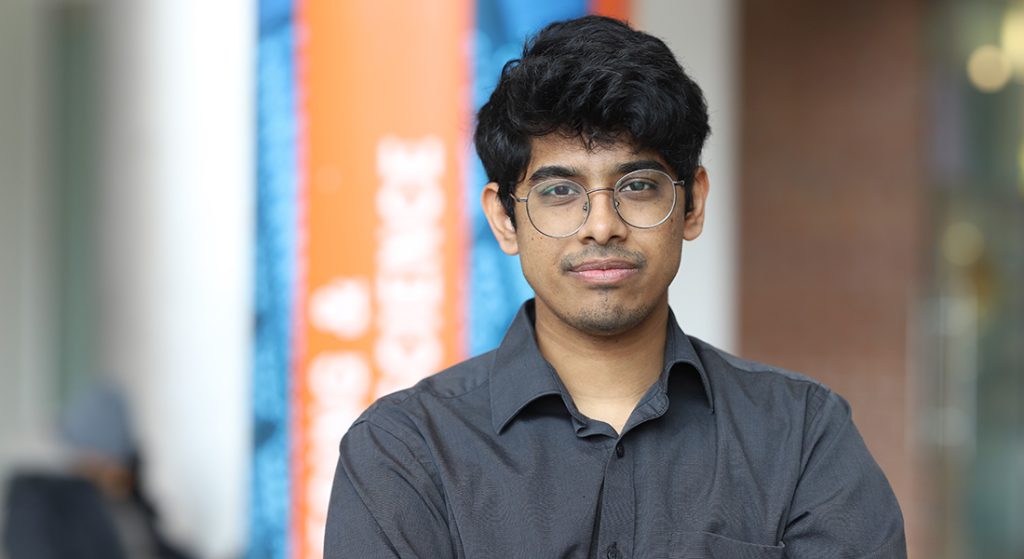
Anand Wadurkar’s journey in biomedical and chemical engineering is a testament to his resilience, passion, and relentless pursuit of knowledge. His interest in science and engineering began at a young age, when, at just 15, he started exploring various STEM projects. From enhancing soil fertility by utilizing biodegradable waste to excelling in robotics competitions, Anand’s passion for science and engineering grew stronger, eventually gaining him recognition in his graduate school journey.
Hailing from Mumbai, India, he received his bachelor of technology in biotechnology and began his professional career at the bioprocess company, BiOZEEN. However, the desire to continue pursuing his education bubbled within him, which made him apply to Syracuse University’s Department of Biomedical and Chemical Engineering.
“As soon as I started the program, I had a co-op opportunity with the Center for Advanced Science and Engineering (CASE) for about 5-6 months at Triton Bio,” says Wadurkar.
Computational work was another aspect of biotechnology he found most interesting, and this eventually became his primary pursuit. He discovered this passion during the graduate student orientation at the College of Engineering and Computer Science (ECS) and was captivated as Biomedical and Chemical Engineering Professor Shikha Nangia presented her computational research on the blood-brain barrier.
He then became a research assistant in Professor Nangia’s lab, where he explored his interests in molecular modeling and simulation. This computational process simulates and analyzes the properties of biological molecules. One project he is working on is enhancing small molecules to destroy bacteria or viruses. This molecule can prevent infections in biomedical devices, such as knee or hip implants, by forming a protective layer using biomaterials like microgel or hydrogel.
Wadurkar has also co-authored two research papers, one paper which involved predicting the clustering of devised small molecules. The paper was a huge breakthrough in small molecule research, and he even won a Master’s Thesis Prize. “The small molecules I work with are not naturally found in the body, but it can open great pathways to understand what’s in our body like proteins, cell membranes, and other things,” he says.
He also attended the Foundations of Molecular Modeling and Simulation (FOMMS) 2024 and International Community for the Advancement of Peptoids (ICAP) conferences in Berkeley, California where professionals worldwide gather and discuss their research and the latest developments in the field.
Under the guidance of Professor Nangia, who also serves as Interim Department Chair, he seeks to continue making breakthroughs in research. “It’s amazing,” he says when asked about collaborating with his advisor. “She empowers us to make our own decisions and, even if we don’t always succeed, she is understanding and supportive, providing us with additional opportunities to grow. Despite serving as the interim department head, she remains committed to ensuring that we stay on track and receive the guidance we need.”
Study Tips from ECS Peer Leaders

As the fall semester comes to a close, and final exams approach, we’ve gathered some tips from ECS peer leaders on how they study for exams. Here’s what they had to say:
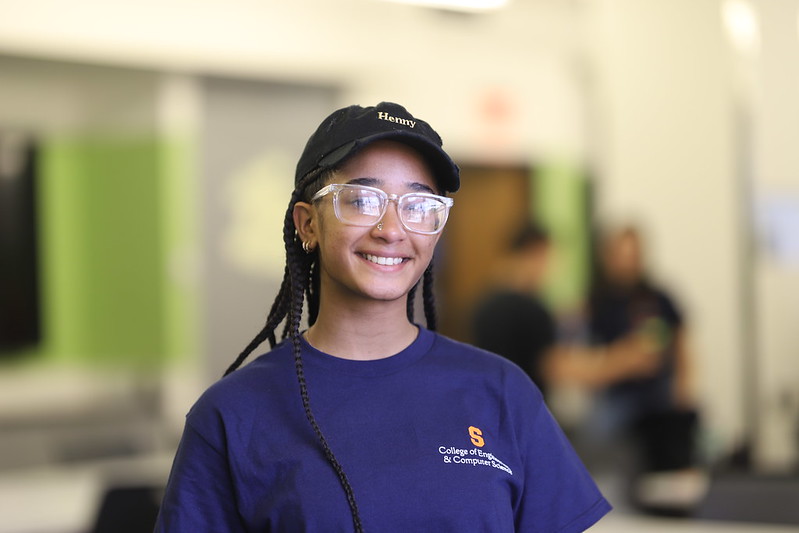
Hennecys Castro | Environmental Engineering | 2025
- One way I mitigate stress and study for exams is by creating a cheat sheet. It allows me to have all the content in one place and I split it into topics, formulas, and examples similar to a mind map
- I use the Cornell method where I have all the formulas and relationships, I need to solve a problem then I solve the problem. Then on the bottom, there is a summary section to see where I might’ve messed up or any extra notes
- I prefer not to study with friends for certain classes and then for other classes, I like to collaborate
- I like doing my work in Goldstein Student Center where there’s a food court so I can make sure I am eating and hydrated. If anyone feels like they blank out during exams I would suggest referring them to the Center of Disability Resources (CDR) for extra exam time
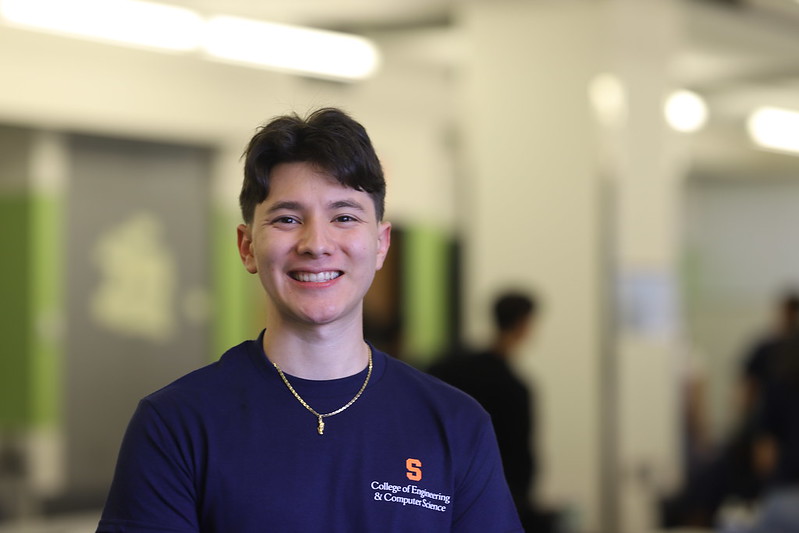
Aaron Shinn | Civil Engineering | 2025
- Note-taking in class can be a good form of studying with the right approach. When in lecture, be aware of what the professor says is most important to know, organize your notes in a way that works for you, and spend each day quickly reading over your notes to put what you wrote down to memory
- Make sure to do your homework on your own or collaboratively without copying others
- Putting an honest effort and asking questions is a form of practice for future exams. By retaining information from lecture and doing homework with an honest effort, you can save time with additional studying by focusing on the concepts that are more difficult to you
- Make sure to also prioritize getting enough sleep and taking breaks because overworking yourself will negatively affect your performance on exams

Aicha Gory | Computer Science | 2026
- For studying, I will make sure to start practicing two weeks before the exam with practice exams, homework and extra quizzes the teacher provides. If you don’t understand a concept, make sure to go to office hours or approach your Academic Excellence Workshop assistant
- For math, you can go to the Syracuse library and find some past exams. The format is similar. Make sure to do at least one or two
- Try approaching the teacher. Studying with your peers also helps since they might explain things easier than the teacher. And don’t wait till the last day to study!
Automotive Engineering Course Focuses on Vehicle Design and Development
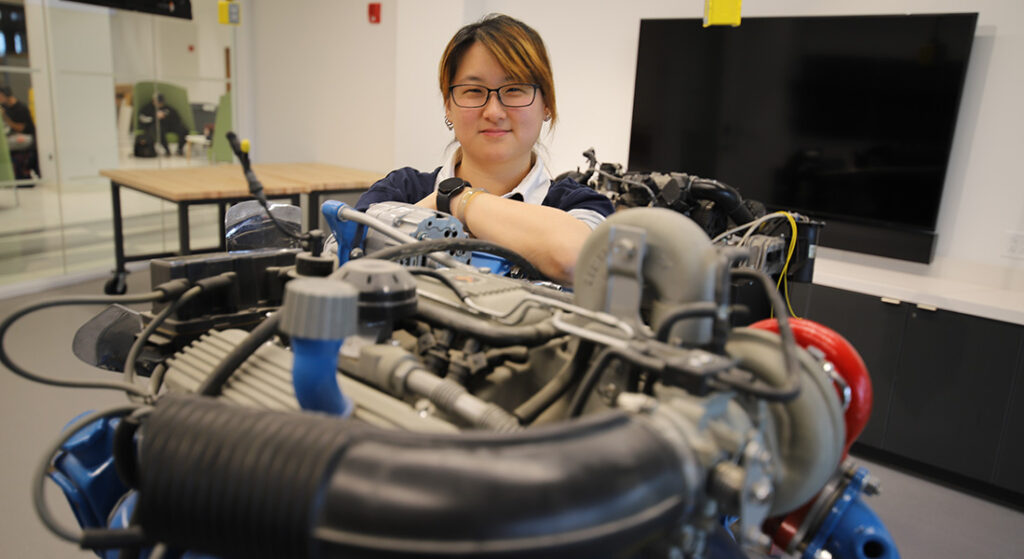
Automotive Engineering (MAE 457) is a course designed to equip students for careers in the automotive industry and a variety of other fields. This course will ignite students’ curiosity to explore the design and development of different vehicle engines and will be taught by Mechanical and Aerospace Engineering Professor Andrea Shen. The course will also cover new topics in automotive engineering, including hybrid and electric vehicles.
Students in MAE 457 will learn about how internal combustion engines work, the significance of biofuels, vehicle dynamics, and how different factors impact engine performance. They will also have hands-on learning experiences with engines, observing the functions of a diesel engine and gasoline engine located in Link Hall. Additionally, each student will complete a project where they will conduct research on a vehicle of their choice.
The course will also feature guest speakers from companies such as Space X, Ford, Harley Davidson, Sierra Space, Roush Yates, Cummins and Caterpillar, and students will have an opportunity to interact with these industry professionals.
“I’m hoping students will gain an appreciation for cars,” says Shen. “They will gain an understanding of all the things that go on in the car and how they interact with each other. I also want to bring awareness on biofuels and the importance of research on combustion engines and automotives in the face of electric vehicles.”
Shen earned her bachelor’s and master’s degrees at Virginia Tech and her Ph.D. at the University of Wisconsin-Madison in the Engine Research Center. She will incorporate her research focuses on gasoline engines, biofuels, and engine performance as well as creating representative models of different base fuels into the course.
Syracuse University, Georgia Tech and MIT Startup Lamarr.AI Raise $1.1 Million in Pre-Seed Funding
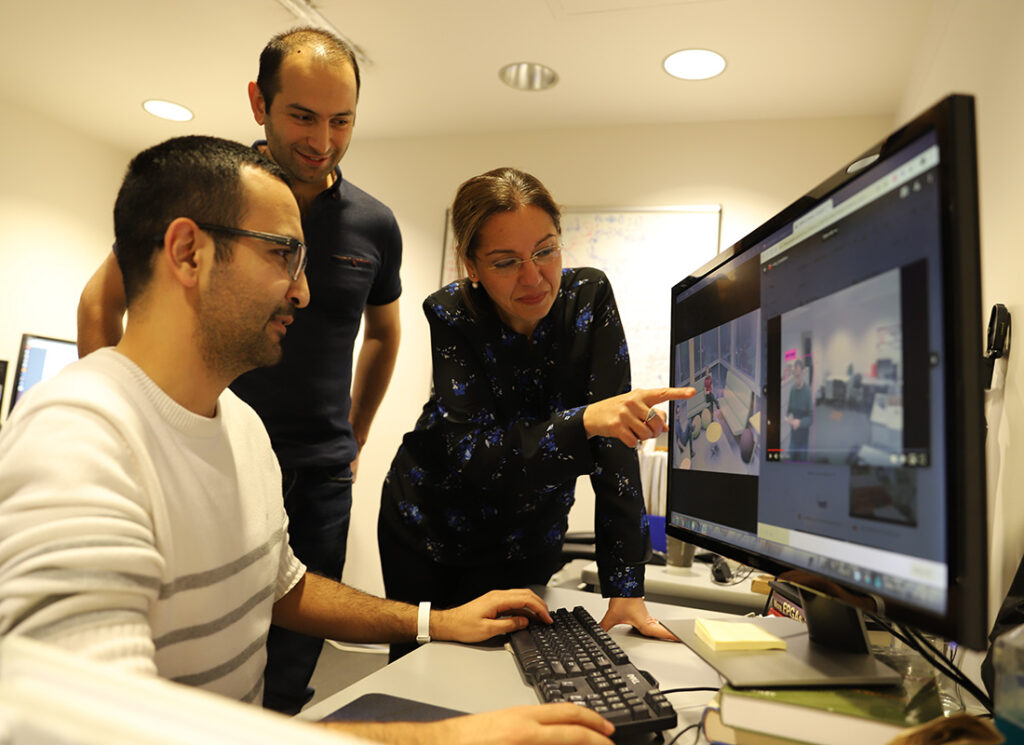
From the collaborative research efforts at Syracuse University, the Massachusetts Institute of Technology and the Georgia Institute of Technology comes sustainable building startup Lamarr.AI. The startup recently raised $1.1 million in pre-seed funding to commercialize its automated technology which will use drones, thermal imaging and machine learning techniques to inspect and analyze buildings. The startup aims to reduce building carbon emissions and lower maintenance and ownership costs.
Electrical Engineering and Computer Science Professor Senem Velipasalar has been collaborating with former Syracuse University professor Tarek Rakha, who is now at Georgia Tech, as well as Norhan Bayomi and John E. Fernandez from MIT. Velipasalar has been working on autonomous thermal anomaly detection using machine learning on building envelopes, which include windows, doors, walls, and roofs. Thermal anomaly detection involves identifying and classifying temperature variations in different areas.
Led by Rakha, the team received a $1.8 million grant awarded by the U.S. Department of Energy in 2019 for their preliminary work on thermal anomaly detection. Lamarr.AI was then founded in 2021 to commercialize this technology, and Velipasalar has played a crucial role as the startup’s Chief Technology Officer (CTO). Rakha serves as the startup’s Chief Executive Officer (CEO).
Using AI to automate building analysis, Lamarr.AI has collaborated with several building owners and facilities managers, saving over $1 million in engineering and construction costs. Their AI technology identifies issues, such as deteriorated window seals and leaky roofs. It has also helped in effectively planning and scoping large building envelope retrofits, a process that improves a building’s energy efficiency.
The algorithms Lamarr.AI has developed contribute to transforming building energy audits by providing recommendations significantly faster, more affordably and more accurately than traditional manual audits. The startup filed two patents based on this technology, both of which are co-owned by Syracuse University, Georgia Tech and MIT.
“I am very excited and happy that commercialization of this technology will allow us to increase the visibility of Lamarr and Syracuse University both nationally and internationally and draw attention to not only the AI-related research being conducted at Syracuse University but also the commercialization of these developed technologies for the betterment of the society,” says Velipasalar.
The Department of Electrical Engineering and Computer Science Hosts Annual Power Engineering Workshop
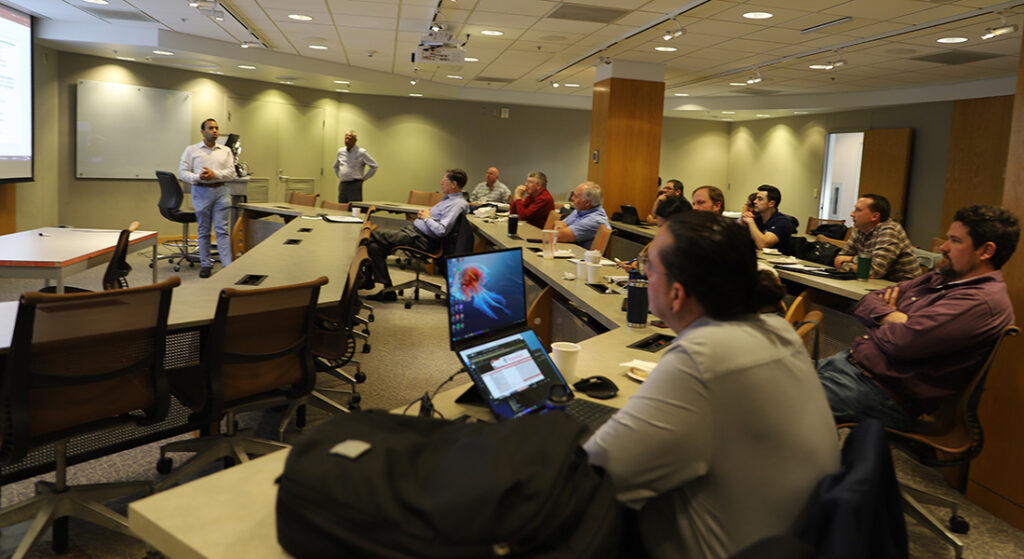
The Department of Electrical Engineering and Computer Science (EECS) hosted its electrical engineering workshop in collaboration with the Institute of Electrical and Electronics Engineers (IEEE) Syracuse Section and the National Society of Professional Engineers (NSPE) Central New York (CNY) Chapter on Friday, October 11th, 2024. The workshop covered various electrical engineering topics and aimed at power engineering professionals.
The IEEE Syracuse Section has over 770 members and is part of the world’s largest professional engineering society. Its mission is to promote technological advancement in CNY through events, lectures, and business, as well as technological advancement in CNY through events, lectures, business, and educational development. NSPE CNY comprises engineering professionals from all disciplines and seeks to promote the ethical, competent, and lawful practice of engineering while providing career development, networking opportunities, and other benefits to students and professionals.
The workshop is an annual event that was started 12 years ago. Originally envisioned by Electrical Engineering and Computer Science Professor Prasanta Ghosh, and William Maxwell, ’87 G’03, they have co-chaired the event since the beginning. Its mission is to serve the continuing education needs of New York State’s licensed professional engineers as well as licensed professional engineers in other states with a primary focus on power engineering. Since the COVID-19 pandemic, the hybrid format has expanded its reach both locally and across the Northeast and benefits presenters who can’t physically attend the event.
“Over previous years, there have been Ph.Ds. and senior practicing engineers from Canada, Saudi Arabia, India, and Australia. Although a small workshop, it is thrilling that every year, the best minds from around the U.S. and the world present to the professional engineering students. Typically, the workshop has 35 participants and continues to grow in number and breadth of attendance,” says Professor Ghosh.
The workshop was presented by faculty from Syracuse University, Binghamton University, Rensselaer Polytechnic Institute, State University of New York (SUNY) Upstate Medical University and industry professionals from General Electric (GE). The students, licensed professional engineers, earned six (6) Professional Development Hours (PDHs) toward the continuing education requirements of their engineering license.
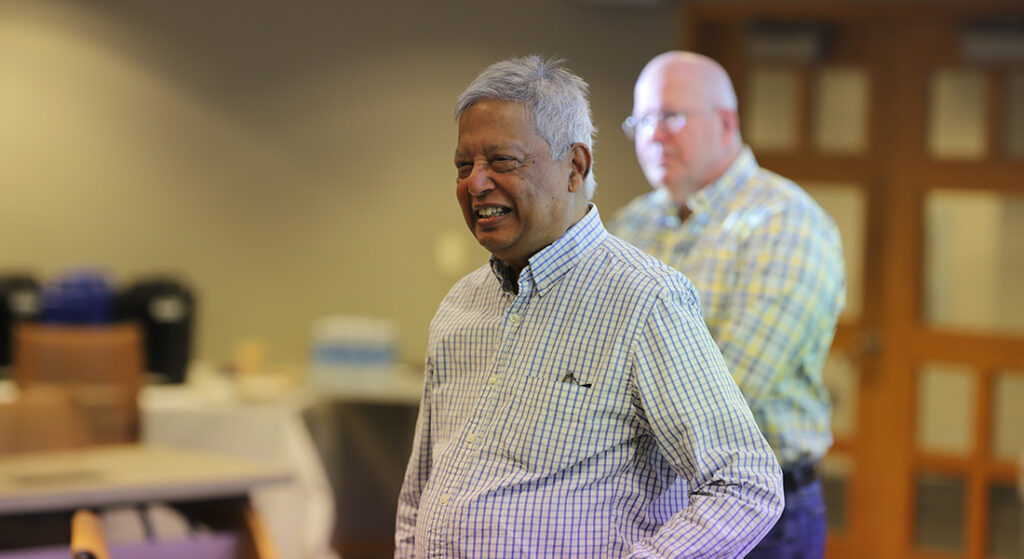
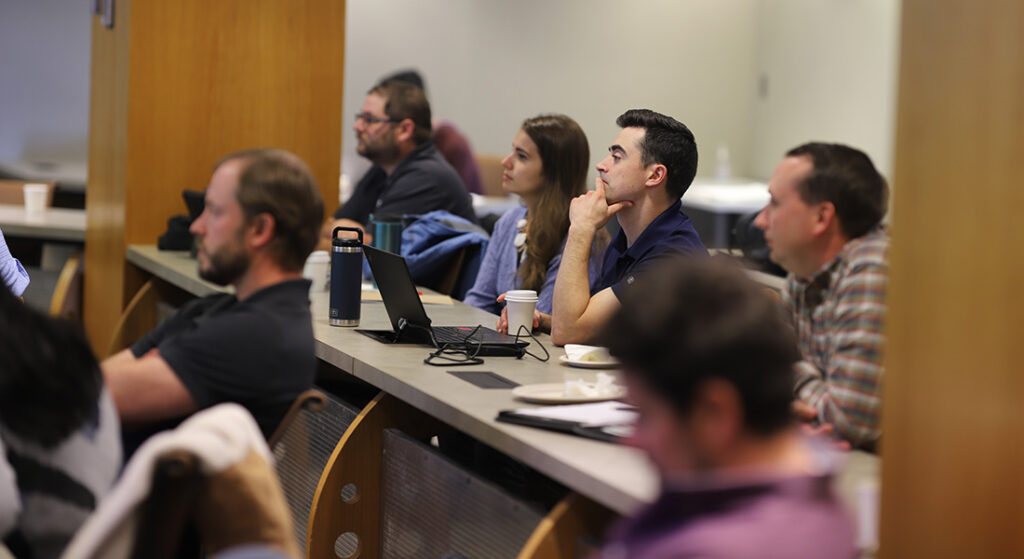
Electrical Engineering and Computer Science Graduate Student Spotlight: Siwei Zhang
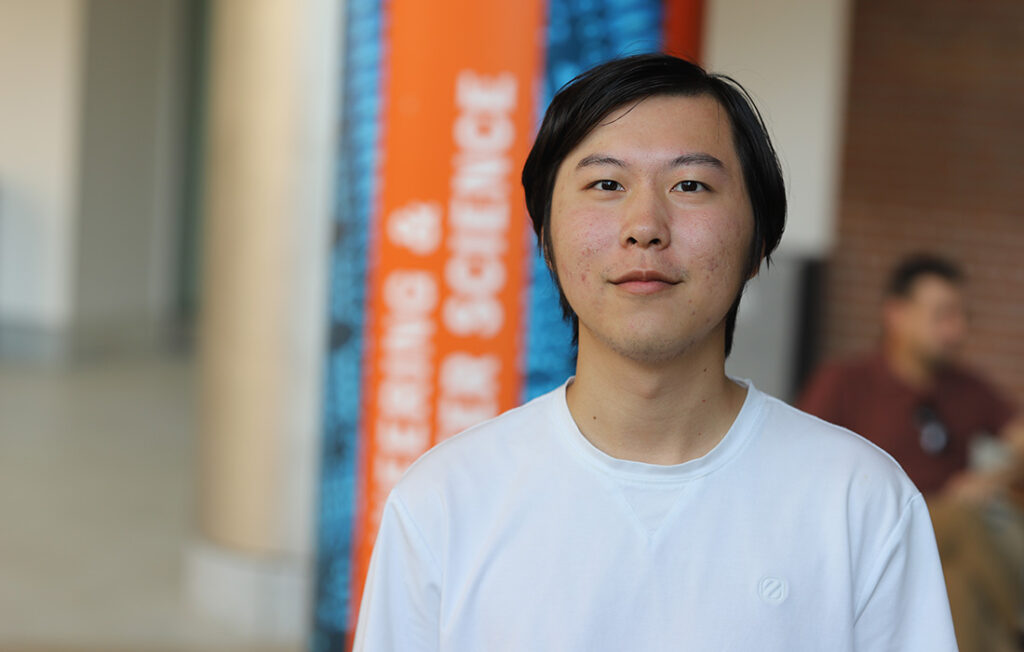
In just one year, computer science Ph.D. student Siwei Zhang has made outstanding achievements in research. Advised by electrical engineering and computer science (EECS) professor Endadul Hoque, Zhang has been involved in multiple projects, presented research at conferences, and published a paper, contributing significantly to the cybersecurity research field.
Joining the EECS master’s program in the fall of 2023, Zhang worked with Hoque on developing fuzzing methods. In cybersecurity, fuzzing is a security testing technique that uses an automated approach to find vulnerabilities and bugs in computer programs. “I’ve always had an interest in operating systems, and I find research interesting. In my spare time, I use new tools to find bugs in systems. Finding vulnerabilities in programs is the goal of my research.”
Zhang presented his work on fuzzing methods in operating systems at the 2024 USENIX Conference. This prestigious conference brings together researchers and practitioners in the cybersecurity field, and Zhang’s research caught the attention of several attendees. “People are interested in this area of research,” Zhang says. “It’s going to be the future.”
As a Ph.D. student, Zhang has authored and published a paper that focuses on enhancing the security of smart homes. He presented the paper at the Institute of Electrical and Electronics Engineers (IEEE) Secure Development (SecDev) 2024, a conference where academic and industry researchers present and discuss state-of-the-art techniques for developing secure computer systems.
“As a first-year Ph.D. student, Siwei has made remarkable progress in academics and research, including leading multiple projects,” Hoque says. “He excels at system-level programming and quickly grasps complex problems. As a master’s student in my group, he developed an open-source gateway for large language models (LLMs)—advanced AI systems trained to understand and generate human language—which streamlines integration with both open and closed-source models. This tool has greatly supported our research. With his skills and enthusiasm, he shows strong potential to become a leading cybersecurity researcher, and I’m pleased to have him in our Ph.D. group.”
The Catalyst for Renewable Energy Research
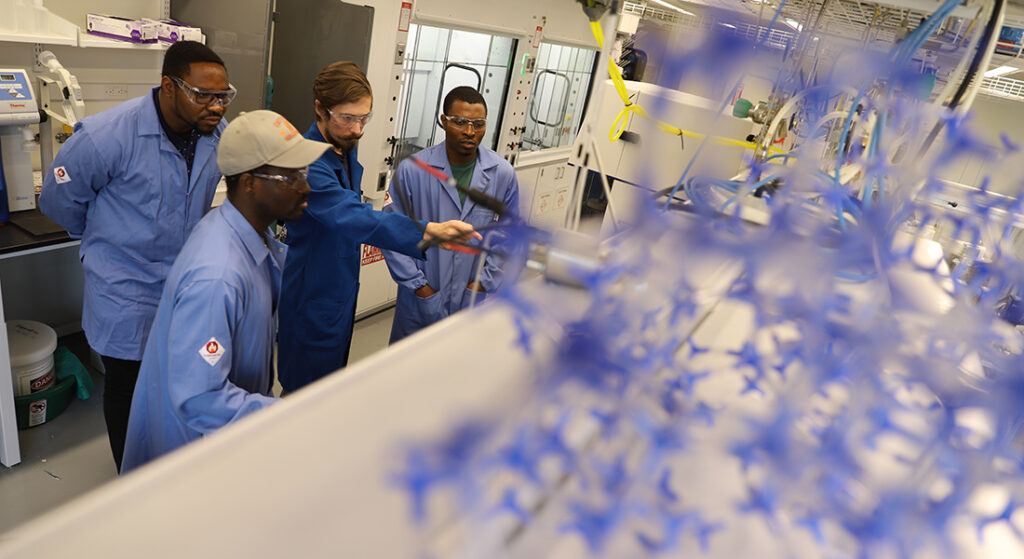
Catalytic materials are defined as substances that speed up a chemical reaction without being changed in the process and many products that exist today are only possible because of catalysts. In fact, hundreds of catalytic materials are discovered or created each year, yet only a small number of them are commercialized. This is because many catalytic materials aren’t stable and break down over time, making them difficult to study and use.
The stability of catalytic materials is what motivates Biomedical and Chemical Engineering Professor Theodore Walker and his research team’s work. In his lab, they’re attempting to create new, stable catalysts for renewable energy products.
“Catalytic materials need to last for two to three years minimum without being replaced. The timescales we can readily access in the lab are about 24 hours or weeks at most,” says Walker. “That makes probing catalyst deactivation behavior and exploring all the physical processes that govern that deactivation difficult. Our goal is to test the activity and stability of catalytic materials to transform raw materials into products and leverage these insights to invent more robust and stable catalytic processes.”
One project Walker and his research group are working on is changing the molecular structures of molecules taken from biomass, organic materials made from plants and animals. Using acid catalysts, they can create entirely new substances from these molecules. For example, the molecule hydroxymethylfurfural (HMF), which is created from fructose, or plant sugar, can be turned into bio-degradable plastics when its molecular structure is changed.
However, the process of making HMF from fructose isn’t efficient. Once the acid catalyst creates an HMF molecule from fructose, the same acid quickly degrades HMF into other molecules. Walker and his team will conduct research to change the molecular structure of biomass molecules and stabilize these catalysts. “In my lab, we’re decorating catalysts with polymers to protect them from deactivation or steer them to selectivity towards the products we want,” he says.
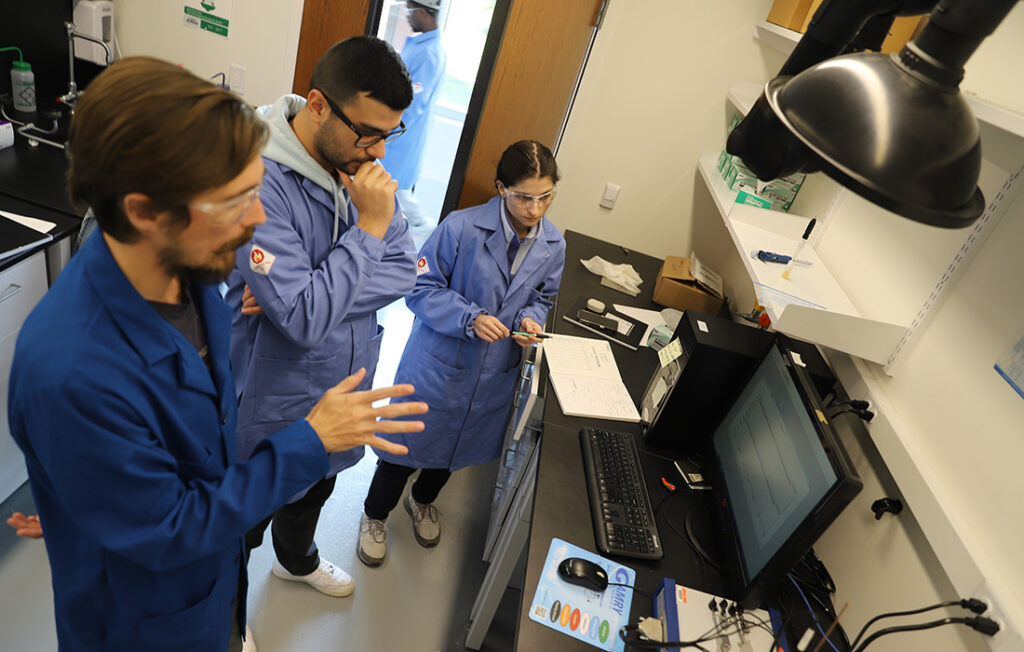
Another project Walker and his team are working on involves pyrolysis. Pyrolysis is the process of heating an organic material without oxygen to initiate a chemical change. This process can be used to create eco-friendly biofuels that are similar to gasoline. Though this biofuel has promising potential, it runs into the same problems as HMF: catalyst instability. Biomass contains calcium, potassium, and other metals that cause catalyst instability, so Walker and his team are exploring ways to make more stable catalysts for biomass pyrolysis.
“The catalyst deactivates in the presence of alkaline metals like calcium and potassium which crude oil has none of, but biomass has plenty of it,” says Walker. “We’re exploring strategies to prevent the alkali metal poisons from entering the pore structure or render them in a form where poison can be easily recovered.”
The Walker lab’s third project involves electrochemistry, a process where chemical reactions are driven by electricity rather than high temperatures. Walker’s team is working on creating stable electrodes, or electrical conductors, to produce renewable electricity and hydrogen fuel through water splitting, which involves breaking water down into oxygen and hydrogen gas.
“If you apply a voltage of greater than one volt across two platinum electrodes in an alkali aqueous solution, it will split the water apart into hydrogen and oxygen, which is zero-carbon fuel, and you can harvest electricity from this process as well,” says Walker. “But platinum is expensive. It would be great to use cheaper materials like iron, tin, or cobalt. However, the iron electrode rusts when placed in an alkali solution and oxidation occurs. We want to make electrodes more stable and use the same electrode formulations to oxidize molecules into carboxylic acids, a high-value molecule.”
By studying catalytic materials, Walker and his team hope that their research will have a massive impact on renewable energy resources. “Catalyst deactivation represents a real bottleneck in our technology-development pipeline. I can name a handful of promising technologies that, if broadly implemented, could be transformative; yet they haven’t because conventional catalysts aren’t stable,” Walker says. “If we could learn something new about what governs the catalyst degradation processes, that could be very impactful.”
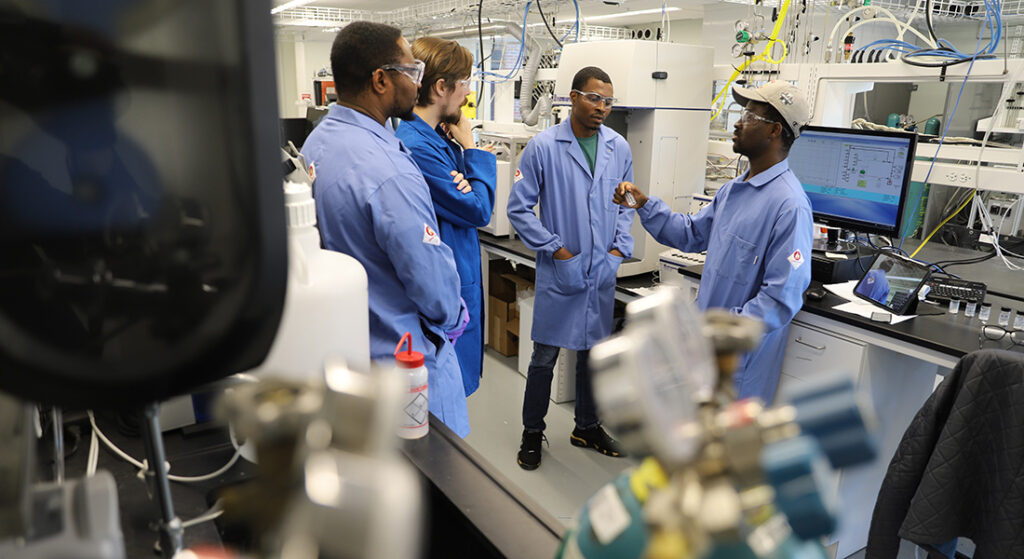
“Managing Mass Timber: From Forest to Future” Exhibition Comes to Syracuse University
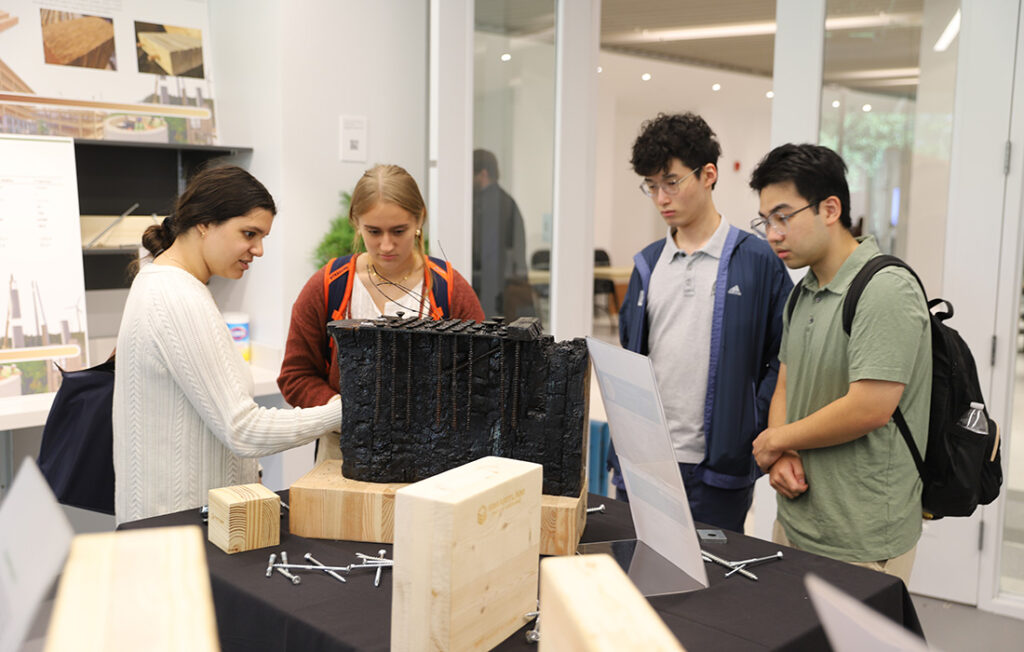
When it comes to sustainable construction materials, there’s no contest: mass timber buildings require less heavy equipment, save on labor costs, and take less time to install than concrete and steel. By utilizing mass timber, the construction industry can utilize green building practices without compromising efficiency.
That was the message of “Managing Mass Timber: From Forest to Future,” a lecture delivered by Dr. Anthony Mirando and Dr. Lameck Onsarigo of Kent State University. Presented on September 30 at the College of Engineering and Computer Science, the lecture was part of a national tour showcasing Dr. Mirando and Dr. Onsarigo’s research at Kent State University’s College of Architecture & Environmental Design.
Mass timber refers to a class of engineered wood products (EWPs) that are often used for wall, roof and floor construction. Because commercial-scale mass timber construction projects are on the rise across the United States, Professors Mirando and Onsarigo highlighted the importance of educating the next generation of professionals about these green building materials.
The lecture featured data from one of the tallest mass timber buildings in the United States: INTRO in Cleveland, Ohio. A mixed-use structure with 300 apartment units and ground-floor commercial space, the project was uniquely efficient because of the use of mass timber materials such as Glued-Laminated Timber (GLT) beams and columns, as well as Cross-Laminated Timber (CLT) slabs. The real estate developer reported that construction time was about 25 percent faster than typical concrete or steel construction.
“Managing Mass Timber: From Forest to Future” also included a weeklong exhibit in Link Hall where students could examine real-life examples of mass timber building materials, including dowel laminated timber, nail laminated timber, and connections and assemblies used in mid- and high-rise construction projects. The “Managing Mass Timber: From Forest to Future” national exhibit tour is funded by the Softwood Lumber Board (SLB) headquartered in Portland, Oregon. Dr. Andria Costello Staniec, Department Chair of Civil and Environmental Engineering, and Mr. Reed Kelterborn, Director of Education for SLB, delivered welcoming and opening remarks.
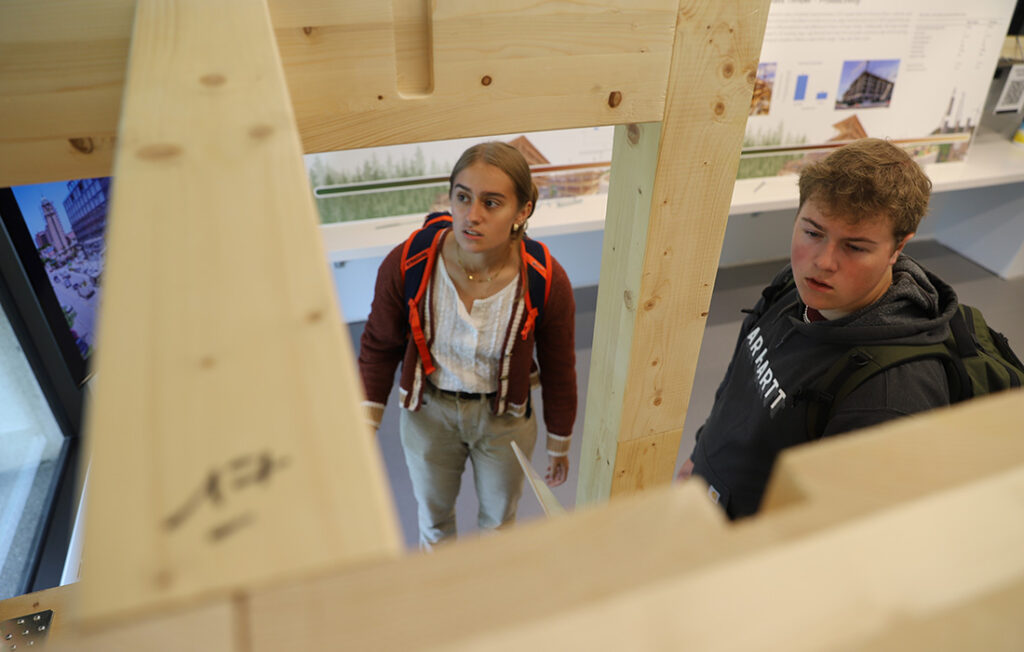
The visit from Kent State University faculty was organized by Yilei Shi, Associate Teaching Professor and Undergraduate Civil Engineering Program Director, and Cliff I. Davidson, Civil and Environmental Engineering Professor Emeritus. “We were thrilled to host Drs. Mirando and Onsarigo’s national touring exhibition on the construction management aspects of the mass timber building industry, and to highlight the benefits of mass timber as a sustainable construction material to the Engineering, Architecture, and Construction (EAC) community here in Central New York,” says Professor Shi. “Interest in mass timber buildings is rising rapidly throughout the country. Skilled labor and seasoned professionals are in great demand. This state-of-the-art exhibition and lecture can help bring our students up to speed and get them ready for the next generation’s EAC industry.”
“In addition, we are training students to design and build more sustainable and resilient infrastructure to approach the immense challenges of climate change and natural disasters,” Professor Davidson adds. “Mass timber can be one of the most effective construction materials to meet these challenges.”
Students in engineering, architecture and other disciplines who are interested in the topic of sustainable building materials may also want to register for the 2025 New York State Green Building Conference, which will be held in Syracuse this coming March.
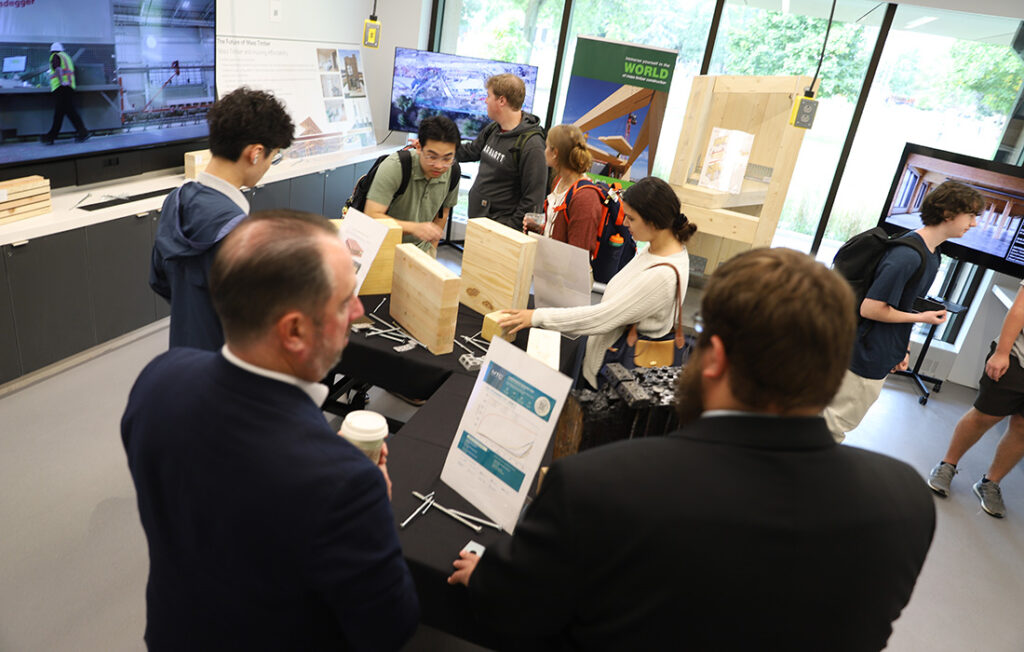
Electrical Engineering and Computer Science Graduate Students, Faculty, and Staff Celebrate Diversity in Computing and Technology at the Tapia Conference

Two electrical engineering and computer science (EECS) graduate students, Nathalie Uwamahoro (electrical engineering) and Polina Kozyreva (computer science) attended the prestigious 2024 CMD-IT/ACM Richard Tapia Celebration of Diversity in Computing Conference in San Diego, California. Known for its emphasis on diversity, inclusion, and collaboration in computing, the conference provided invaluable educational, professional, and networking opportunities for students and professionals alike.
The three-day event featured technical workshops, expert panels, and a robust career fair with major companies like Google, Microsoft, and IBM. For Uwamahoro and Kozyreva, the Tapia conference opened doors to new professional connections and deepened their understanding of key topics such as artificial intelligence, cybersecurity, next-generation computing, and robotics.
“Being at the booth and engaging with people interested in graduate school or research was a fantastic opportunity to learn about the diverse projects my peers are working on. This conference reaffirmed my passion for academia, and I’m eager to contribute to this vibrant community in the future,” says Kozyreva.
“Attending the Tapia conference for the first time was an unforgettable experience. It strengthened my commitment to inspiring students of African descent to pursue careers in technology,” Uwamahoro adds.
The conference also saw participation from the College of Engineering and Computer Science’s Senior Associate Dean for Faculty Affairs and Academic Initiatives, Jae C. Oh and Recruitment Specialist, Michaela Karcher. They were involved in initiatives such as the LEAP Alliance, aimed at increasing diversity in EECS doctoral programs and strengthening the future faculty pipeline. ECS is a Cohort 3 member of the LEAP Alliance and Jae Oh and EECS professor Jason Pollack are LEAP Advocate Faculty. At the conference, LEAP Alliance Fellows and Faculty Advocates got together to share ideas about Broadening Participation in Computer Science Ph.D. programs.
EECS Professor Farzana Rahman is a long-time TPC member of the Tapia conference. Rahman spearheaded the EECS representation at the conference alongside Assistant Dean for Student Recruitment, Kathleen M. Joyce and her team, highlighting the department’s commitment to inclusive education, research, and faculty hiring.
Karcher also developed a list of potential graduate applicants interested in learning more about EECS programs. “This was my first computer science-focused conference, and it was eye-opening to see the many opportunities available,” she says.
The Tapia conference has strengthened Syracuse University’s presence in the computing world, with students returning to campus energized and committed to shaping the future of technology through inclusivity and innovation.
The College of Engineering and Computer Science Hosts Fall 2024 Career and Internship Fair

The College of Engineering and Computer Science (ECS) hosted its annual Career and Internship Fair as part of Syracuse University’s Fall 2024 Career Week. Coordinated by the ECS Office of Student Success and Career Services, the fair allowed students to network with employers from approximately 100 companies. Students also had the opportunity to connect with ECS alumni, faculty, and staff. Employer Partners Novelis, Clean Harbors, Micron, and SRC, Inc. were represented at the fair.
“I graduated from Syracuse in 2014 and now I’m here as a recruiter for Davis-Standard,” says mechanical engineering alum Daniel Broe ‘14. “Syracuse has always welcomed me back to events like this. It feels like home, it’s always good to be back. Students are also excited for opportunities so it’s a great opportunity for both parties.”
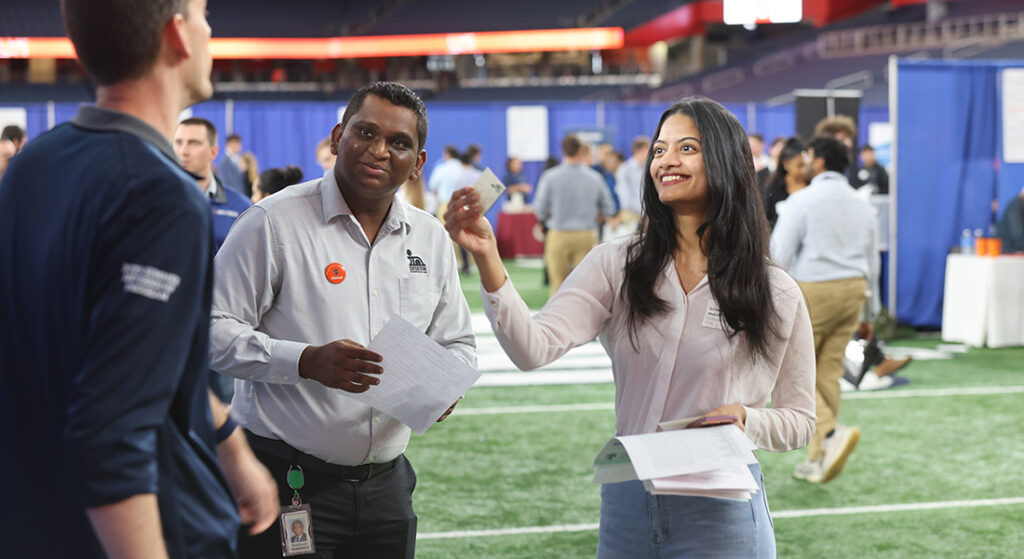
“Coming to career fairs is a great way to get exposure, talk to other people, and find out what you want to get out of your life,” says computer science student Joseph Onwe ‘25.
“It was a really great turnout. Everyone was engaged, and it was great to interact with a bunch of students you normally don’t have contact with” says environmental engineering student Claire Kuiken ‘26.
“This is my third or fourth year coming back here now as a recruiter for Barton & Loguidice. Having graduated six years ago, it’s really exciting to come back every single year,” says civil engineering alumna Emily Mahana ‘18. “This fair is particularly exciting because it’s exclusive to engineering students so I’m looking forward to having one-on-one time with engineering alumni and focusing on recruiting more students in civil engineering.”
“I’m very hopeful since in the last career fair, I got a full-time internship with Stantec over the summer so I’m looking forward to companies and recruiters the fair has this year,” says mechanical engineering student Fernando Poli ‘25.
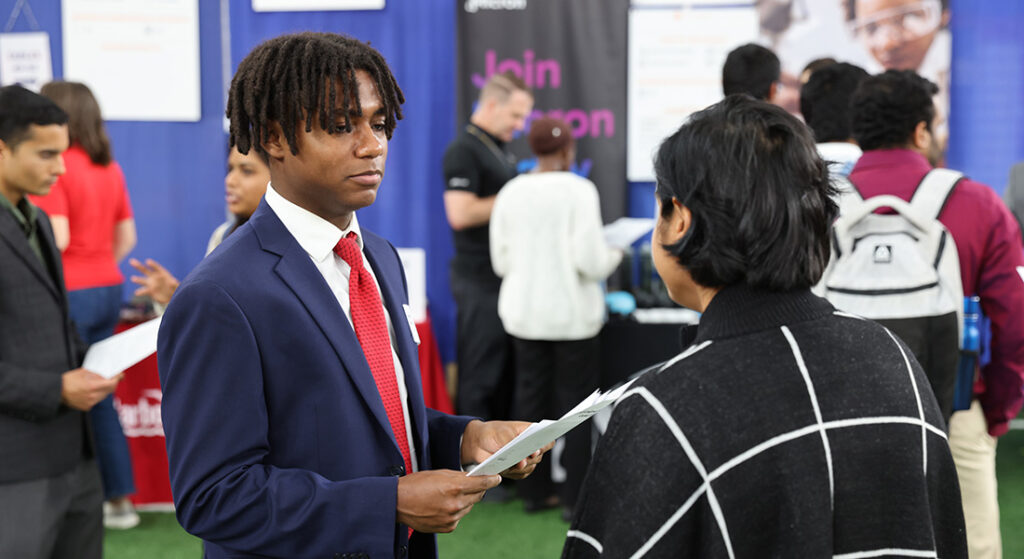
“As a freshman, Career Services has a lot of great resources for students, and I was impressed with all the companies that came in today for students too,” says computer science student Mariama Barry ‘28.
“It was an eye-opening experience where I had the chance to engage with several companies and recruiters…Each conversation offered a glimpse into opportunities that align with my computer science major, from full-time positions to internships,” says computer science student Aicha Gory ‘26. “The event was a valuable learning experience, particularly in understanding the dynamics of networking.”

Flood Forecasting
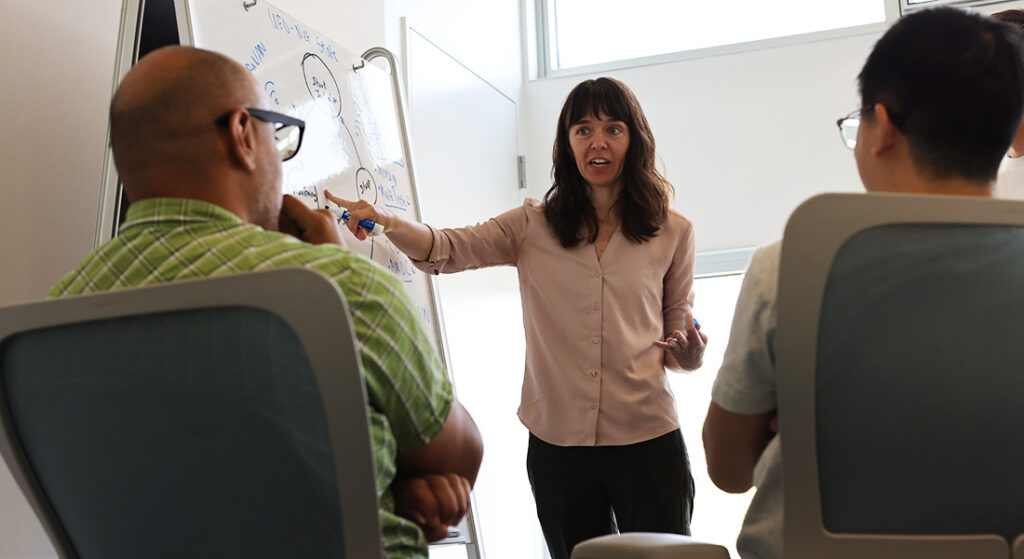
After Hurricane Katrina ravaged the southern coastline of the United States in 2005, Elizabeth Carter found herself on the Gulf Coast following the tropical storm’s aftermath. Witnessing the devastating impact of the hurricane on infrastructure and communities, she decided to place her undergraduate education on hold and join the efforts to rebuild – an experience that would be the catalyst for her future research.
“It was pivotal a time in U.S. history. It exposed a lot of the ways that structurally our publicly funded infrastructure is shunting risk down socioeconomic gradients,” Carter says. “As a young person figuring out what I wanted to do in the world, I didn’t think I could walk away from something like that and retain my humanity.”
Ignited with a passion for the environment, Carter returned to school and received her bachelor’s degree in soil science, a master’s in environmental information science and a Ph.D. in environmental engineering with a concentration in water resources. Now working as an assistant professor in civil and environmental engineering with a joint appointment as an assistant professor in earth and environmental sciences in the College of Arts and Sciences, Carter is a computational hydrologist who studies the movement of water from space. Using data from satellites, these observations of water movement allow her to develop ways to respond to natural disasters and manage water resources.
She and her research team at Syracuse University have received a water resource grant from the United States Geological Survey (USGS) to develop a sensor network that measures flooding. This sensor network will help predict different types of flooding caused by natural disasters, particularly flooding in areas where people live, which is referred to as urban flooding. This project is known as the Urban Flood Observing Network.
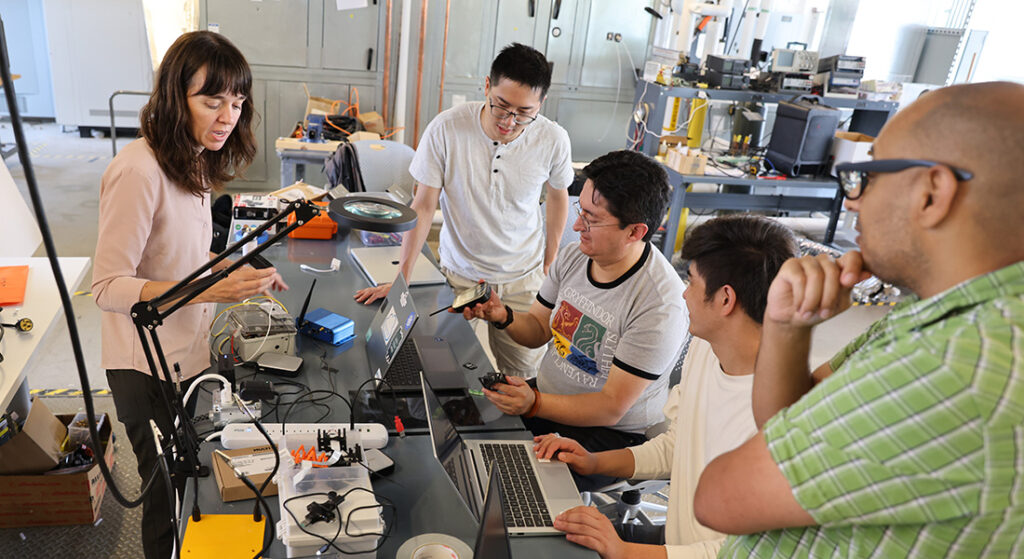
“We’re hoping to build a sensor network for better urban flood response and labels for satellite images so they can map urban flooding everywhere,” says Carter.
Fatemeh Rezaei G‘25 (environmental engineering), Huantao Ren G’21, Ph.D. ‘27 (computer science), Manu Shergill ‘24 (computer science) Nhy’ere Scanes, Ike Unobhaga, Kaitlyn Gilmore and Sharif Jafari are students from Syracuse University and Onondaga Community College (OCC) who have helped with the development of the Urban Flood Observing Network. Collaborators on the project include electrical engineering and computer science professor Senem Velipasalar and associate professor at the School of Information Studies, Carlos Caicedo.
“It’s been a great way to engage a lot of different students from different backgrounds and stages in their careers in hardware design, 3d printing, algorithm design, and photogrammetry,” says Carter.

Shergill is the primary developer leading the project and has been working on the sensor network since 2021. During a summer internship in his freshman year at OCC, he assembled the initial version of the water sensor camera. He’s also been working on adding higher-quality sensors, wireless communications, machine vision, and other features to the water sensor camera, hoping to install it on the roof of Syracuse’s Center of Excellence for testing.
“The next thing I’m tackling is a remote start function, so we can trigger continuous data collection when a storm is moving into the area the sensor is monitoring,” says Shergill.
Carter has hopes the USGS will install these sensor networks in different locations where quick responses to flood events are needed which can help manage future flood events.
“It’s been great to collaborate with different students on this project and make an impact on tackling natural disasters that are a result of climate change,” Carter says.
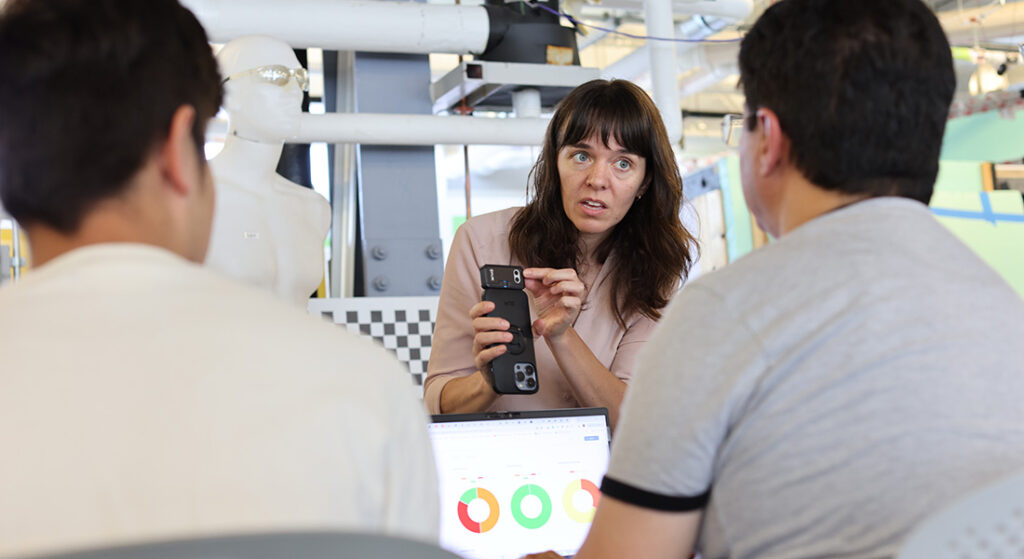
The College of Engineering and Computer Science Hosts Annual Student Leadership Conference
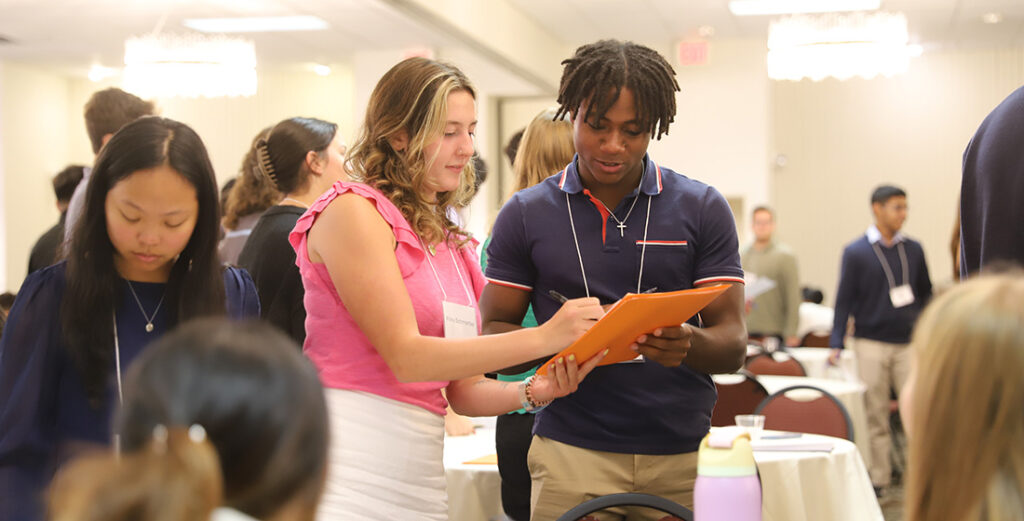
The College of Engineering and Computer Science (ECS) kicked off the 2024 fall semester with the Student Leadership Conference. The conference allowed students to connect with peers, learn tools and resources for professional development, and grow as student leaders.
Coordinated by the ECS Office of Student Success and Career Services, students representing student organizations, Academic Excellence Workshops (AEW), and those looking to hone their leadership skills and feel better prepared for their career development participated in the three-day conference. Sessions were facilitated by representatives from Micron and SRC Inc., in addition to the success and career services team. Alumni from SRC Inc. and Barton & Loguidice also participated.
“We had different speakers from Micron narrating about their professional experiences, what leadership meant to them, and how their perception of leadership changed over the course of their career,” says aerospace engineering student Fatimata Gory ‘26.

“I believe the conference was a great way to reinforce what resources are available to students here at ECS, while also giving us clear great examples of how to behave professionally in different environments,” says civil engineering student Esau Merino ‘25.
“The leadership conference was an amazing opportunity to practice professional development with the employers in attendance and it was great getting to workshop some new skills with my peers,” says chemical engineering student Isabella Perkins ‘25.
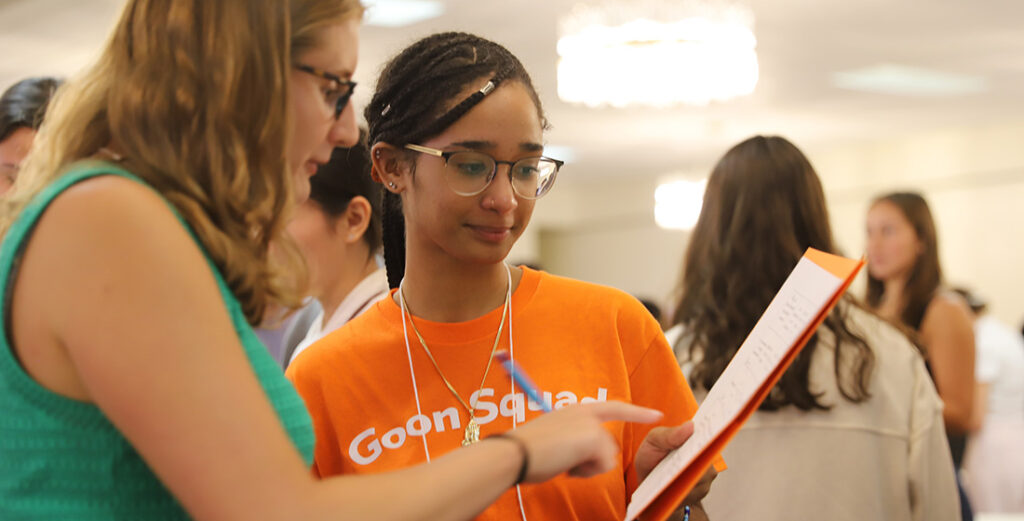
The conference also had mentorship training for student leaders and opportunities for students to socialize.
“A great leader leads by example but also ensures that whoever they lead can step into the darkness with them and shine just as bright or even brighter alongside them. Thanks to the student leadership conference, I know what type of leader I am, and how I want to help those who I lead to shine even brighter than me,” says electrical engineering student Luis Santin ‘24 G’25.
“As a student who went in without connections to AEW or a school organization, I wasn’t sure what to expect but I was delightfully surprised with so many opportunities. Networking with peers whose faces I recognized but didn’t know by name, as well as connecting with various companies, was particularly rewarding,” says environmental engineering student Rylee Smith ‘26.

“I went to the conference as a leader for the Information Security Club and CuseHacks. There were a lot of knowledge gaps that I needed to learn leading a club and encouraging student engagement. The conference helped me feel confident and more comfortable to lead my clubs this year,” says computer science student Daniella Lat ‘27.
The Student Leadership Conference was made possible in part through the generous support of the ECS Employer Partners, Micron, Novelis, and SRC Inc.
Preparing the Next Generation of Biomedical and Chemical Engineers
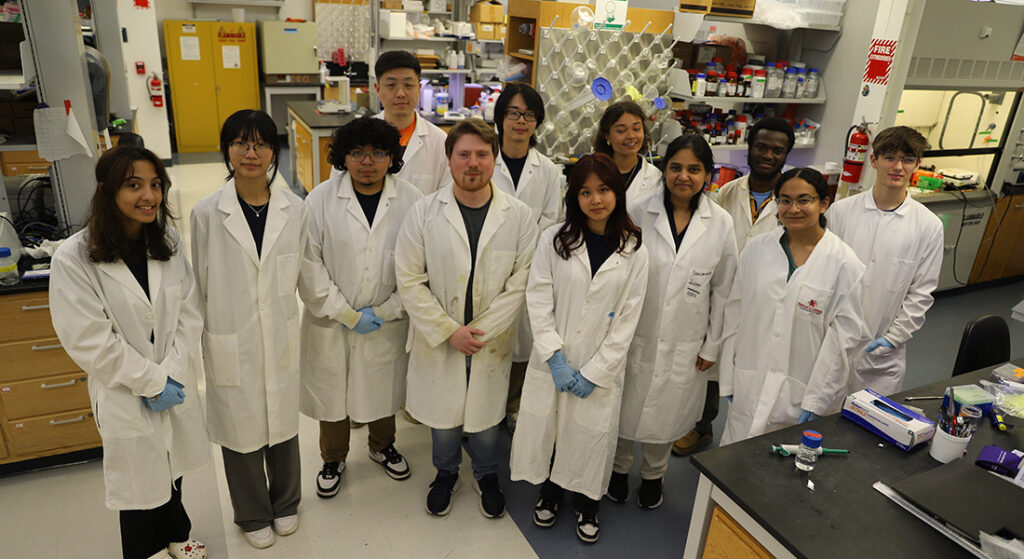
The ESTEEMED LEADERS program at Syracuse University recruits and trains the next generation of biomedical engineers. Made possible by the National Institute of Health, the program supports undergraduate students from historically underserved backgrounds.
The program began during the summer of 2023 with immersive research experiences in the labs of biomedical and chemical engineering faculty. It includes a six-week summer bridge to help students transition from high school to college, scholarships, research, mentorship, and professional development resources. Beginning in their third academic year, students will also be enrolled in the Renee Crown University Honors Program.
“In the ESTEEMED LEADERS program, we are focusing on developing our research skills and being exposed to lab environments to join a lab by our second semester. We’re also focused on developing skills such as calculus,” says biomedical engineering student Joshua Garcia ’28.

This year’s cohort worked with several biomedical and chemical engineering (BMCE) faculty, including Mary Beth Monroe, Shikha Nangia, Zhen Ma, Era Jain, and Yauying Wu. In Professor Monroe’s lab, students examined smart biomaterials for improved wound healing. In Professor Nangia’s lab, students received hands-on experience using computational tools to understand the physical structure and function of proteins, lipids, DNA, and RNA. In Professor Ma’s lab, students learned the significance and applications of induced Pluripotent Stem Cells (iPSCs) in research with hands-on and computational training.
“I want to prioritize research in my future endeavors, and I believe this program is a great opportunity to do so,” says biomedical engineering student Aubrey Williams ’28.

While collaborating with faculty and other students in the program, ESTEEMED LEADERS will receive training, mentorship, and support to enhance their confidence in their academic abilities. They will also receive focused mentoring skill development and preparation for careers in biomedical engineering research.
“I’ve enjoyed interacting with other ESTEEMED LEADERS. We’ve been in different types of labs and spent a lot of time together working on projects and homework. Since I’m from New York City, it’s a new environment for me, but I’m glad I’ve grown a family here,” says biomedical engineering student Emily Gao ’28.
“We currently have 10 outstanding students in our program who are doing research in biomedical engineering, and we look forward to welcoming new cohorts of students in 2025 and 2026,” says Shikha Nangia, the Principal Investigator of the ESTEEMED LEADERS program and professor and interim chair of the BMCE department.
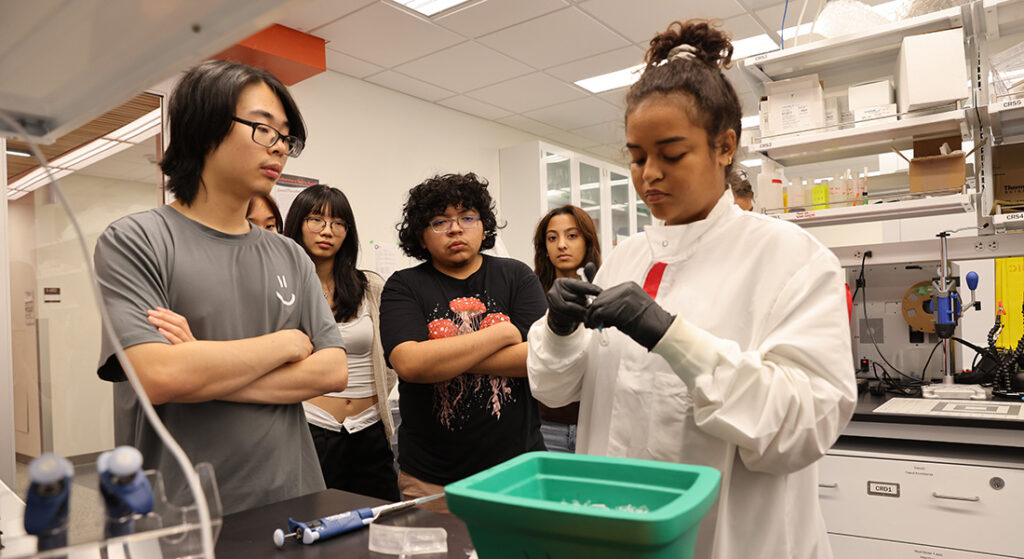
Electrical Engineering and Computer Science Alum Ademola Adejokun Joins Engineering Honor Society Tau Beta Pi
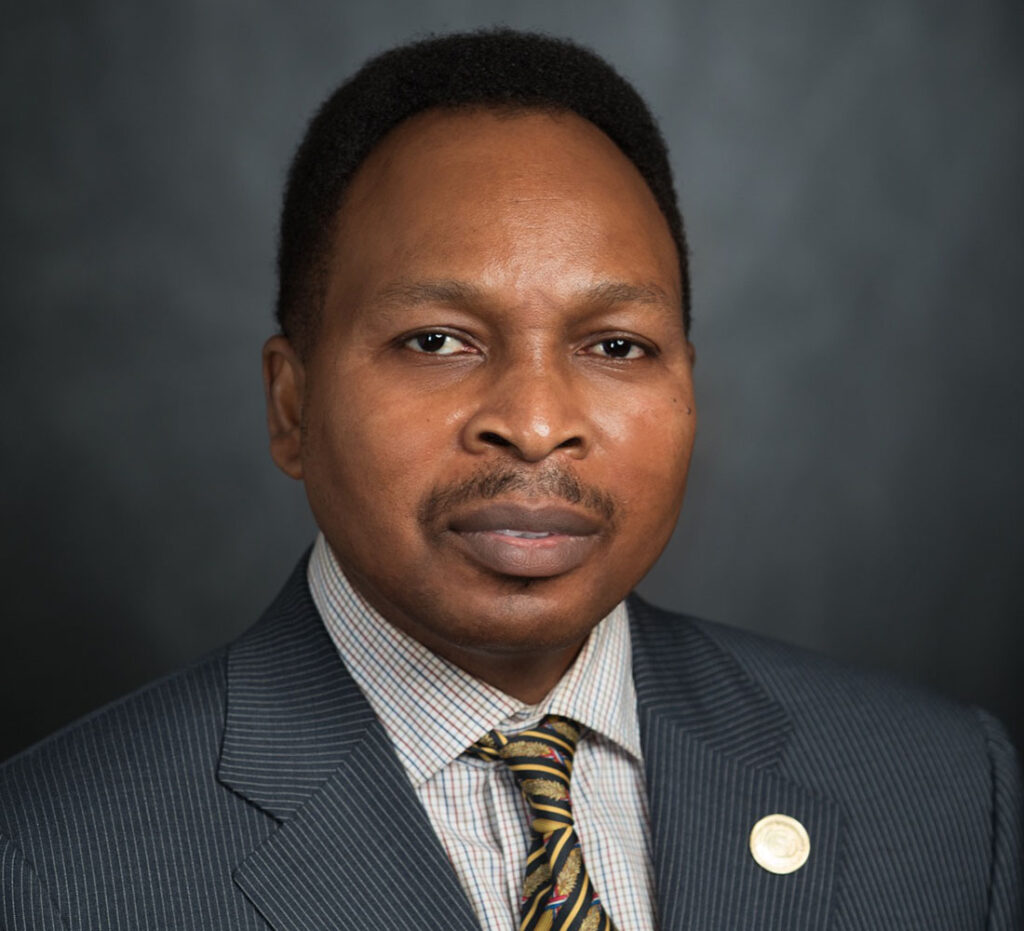
Electrical engineering and computer science alum, Ademola Adejokun G’20, has joined Tau Beta Pi, the oldest engineering honor society, for his outstanding contributions to systems software development and research efforts in open standards for mission-critical embedded systems.
Founded in 1885, Tau Beta Pi represents engineers from all disciplines and honors those who have demonstrated a history of academic and professional achievement. Adejokun has over 20 years of experience in the aerospace domain with competency in systems, software, computer, and cyber security engineering. He is currently a Cyber Security System Engineer at Lockheed Martin Aeronautics in Fort Worth, Texas. He is an International Council on System Engineering (INCOSE) Expert Systems Engineering Professional, a Six Sigma Black Belt, and a Project Management Professional.
Adejokun received his master’s in cybersecurity at the College of Engineering and Computer Science (ECS) and felt the program equipped him well for his professional pursuits. “The master’s program was fast-paced, challenging, and rewarding. It’s also well-respected, and propelled me to where I am now,” says Adejokun. “Everyone knows the value of a Syracuse University degree. Although other schools offer cybersecurity courses, they’re mostly theory-based. At Syracuse, many professors are IEEE fellows and well-known professors who have a hands-on approach.”
Adejokun is also a senior member of the Institute of Electrical and Electronics Engineers (IEEE), the Association for Computing Machinery (ACM), and the American Institute of Aeronautics and Astronautics (AIAA), a member of the Project Management Institute, International Council on Systems Engineering, National Society of Professional Engineers (NSPE), Texas Society of Professional Engineers, and the InfraGard National Infrastructure Protection Program.
Among his engagement in engineering societies’ boards and committees at regional and national levels, Adejokun serves on the College of Engineering Board of Advisory at the University of Texas at Arlington. Additionally, he is a board member and the current vice chair of the Texas Board of Professional Engineers and Land Surveyors (appointed by Texas Governor Greg Abbott.)
Adejokun has also been recognized with numerous awards including the IEEE Region 5 Outstanding Individual Award, IEEE USA Professional Achievements Award (For contributions to IEEE Professional activities and for consistent efforts to professionalize software engineering), United States President’s Lifetime Achievement Award (For lifelong commitment in building a stronger nation through volunteer service) and the Black Engineer of the Year Award-Outstanding Achievement-Science Spectrum Trailblazer.
Electrical Engineering and Computer Science Graduate Student Pardha Sourya Nayani Receives IEEE Antennas and Propagation Society (AP-S) Fellowship Award
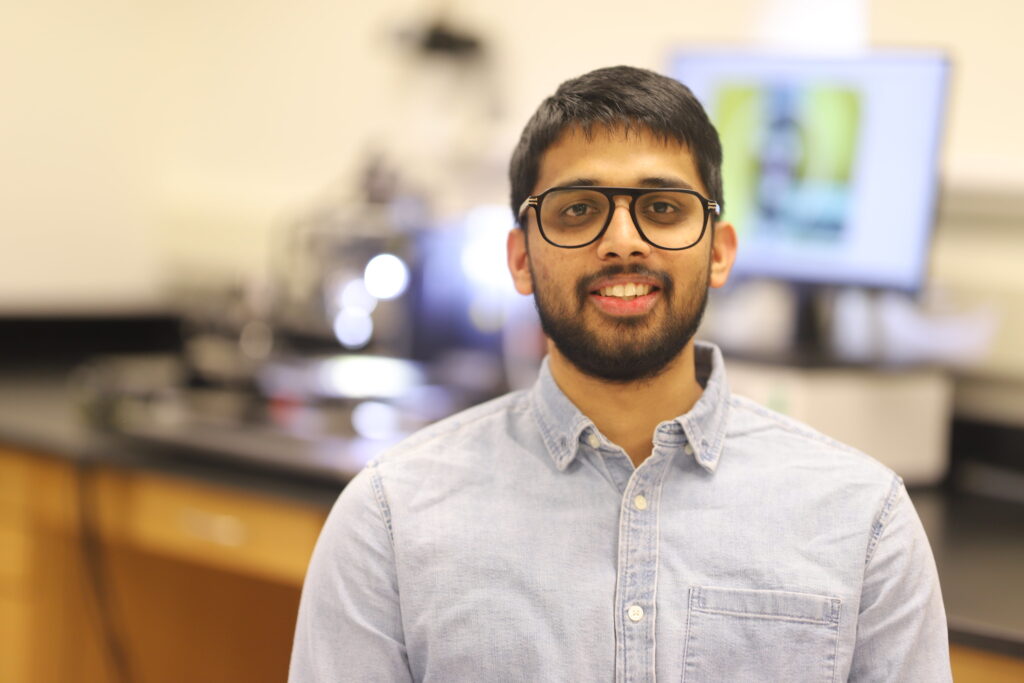
Pardha Sourya Nayani G’28, a Ph.D. student in electrical engineering and computer science (EECS), has received the Institute of Electrical and Electronics Engineers (IEEE) Antennas and Propagation Society (AP-S) Fellowship Award for his research on “Unleashing Bandwidth: Passive Highly Dispersive Matching Network Enabling Broadband Absorbers with Record-High Bandwidth-to-Thickness Ratio”.
The AP-S Fellowship Program aims to support graduate students and postdoctoral fellows worldwide interested in antenna analysis, design, development, and other research areas related to AP-S. Nayani joined EECS professor Younes Radi’s research group at the Radiation Laboratory of Syracuse University in the summer of 2023. “I am deeply honored to receive this award and look forward to making significant contributions in the field of electromagnetics and microwave engineering,” Nayani says.
“As a faculty member at Syracuse University and the prior institutions I have been involved with, I have had the opportunity to see and work with many talented students and researchers,” says Radi. “Rarely have I had the opportunity to work with a student as passionate, talented, and hardworking as Pardha. I am happy and proud that IEEE awarded him this prestigious Fellowship.”
Interdisciplinary Engineering Group Designs Smart Water Box for U.S. Environmental Protection Agency’s P3 Program
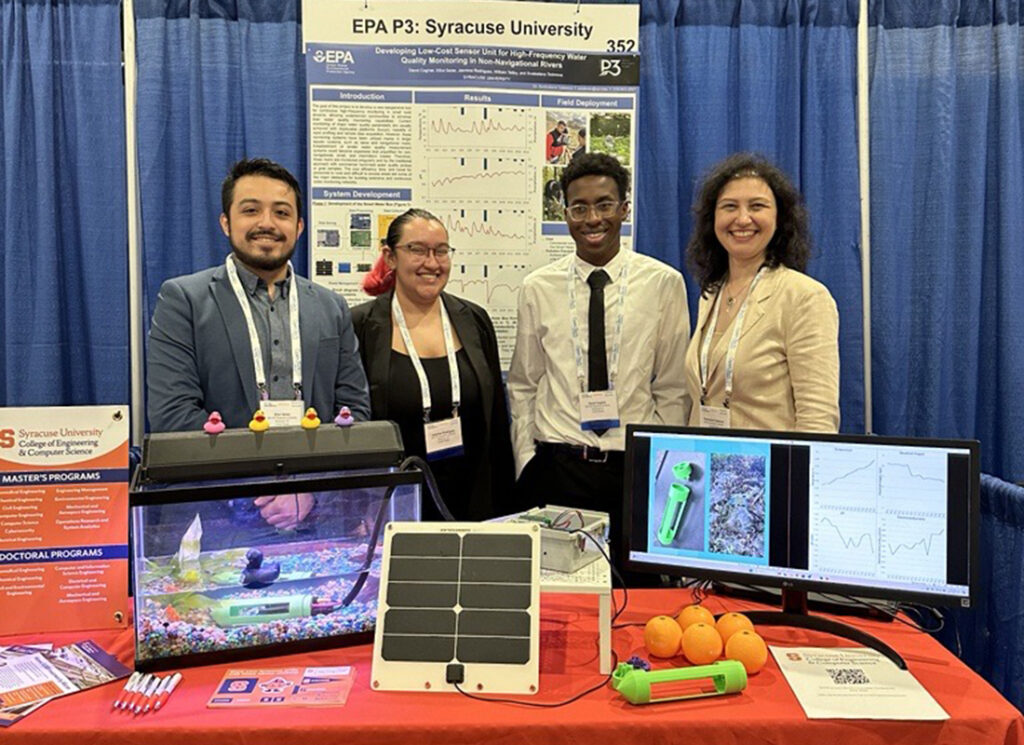
Civil and environmental engineering professor Svetoslava Todorova, retired electrical engineering and computer science professor William Tetley, engineering students David Coghiel ‘24 (civil engineering), Elliot Salas ‘24 (electrical engineering) and Jasmine Rodriguez ‘25 (mechanical engineering) participated in the TechConnect World Innovation Conference and Expo in Washington, DC from June 17-19. The group was a recipient of the U.S. Environmental Protection Agency’s (USEPA) People, Prosperity and the Planet (P3) competitive program grant.
The EPA’s P3 program is a competition where undergraduate/graduate student teams design sustainable solutions to real-world environmental challenges. Todorova, Tetley, Coghiel, Salas and Rodriguez showcased their Smart Water Box, a low-cost sensor unit designed to monitor water quality in small rivers, in a 90-second sales pitch and answered questions in a booth where they displayed their sensor unit.
“The TechConnect World Innovation Expo was a great opportunity that I utilized to network with other student researchers, government agencies, and private companies,” says Rodriguez. “As one of the few student attendees, it was easy to stand out and make better connections with the professionals I interacted with. The P3 National Student Design Competition also gave me valuable insight into what other universities are researching and what issues are at the forefront of people’s concerns when it comes to our environment.”
“Our project stood out as a cost-effective, low-maintenance, solar-powered alternative to traditional water quality monitoring systems. I assisted with the development of the unit and fieldwork to ensure its continuous operation,” says Coghiel. “I was able to connect with different universities and companies to share experiences, knowledge, and accomplishments. Furthermore, introducing our project in an elevator pitch and a booth in the conference hall gave us valuable presentation experience that is bound to help us in our careers.”
P3 has a two-phase program where teams receive $25,000 for a one-year award. The expo concluded phase 1 of the EPA P3 award cycle and the group will compete for the second round of funding in phase 2 during the fall.
“The experience of presenting our project to other schools and EPA representatives was incredibly rewarding,” says Salas. “I was also thrilled to support my team and celebrate their achievements, like David’s impressive elevator pitch and Jasmine’s unique 3D prints, which are integral to our project. While I served a significant role in this project, I must acknowledge the collective effort of our group and the guidance of our mentors, Svetla and William. The time spent in DC was enjoyable and inspiring, and I eagerly anticipate the future improvements our group will make to the water quality monitoring box.”
“Although we discuss the need of using a multifaceted approach in solving contemporary issues, at college level students are often taught in silos. This design project stimulated interdisciplinary collaboration and creativity by bringing together students from three different engineering departments,” says Todorova. “I am extremely proud of their motivation, team spirit, and drive for success. The team stood out with their 90-seconds sales pitch. Everyone came to congratulate us. We are thankful to Linda Hartsock, Strategic Advisor at SU Libraries, for her invaluable guidance and tips in developing a strong sales pitch.”
Mechanical and Aerospace Engineering Student Sameeraa Soltanian-Zadeh Joins Innovation in Buildings (IBUILD) Graduate Research Fellowship
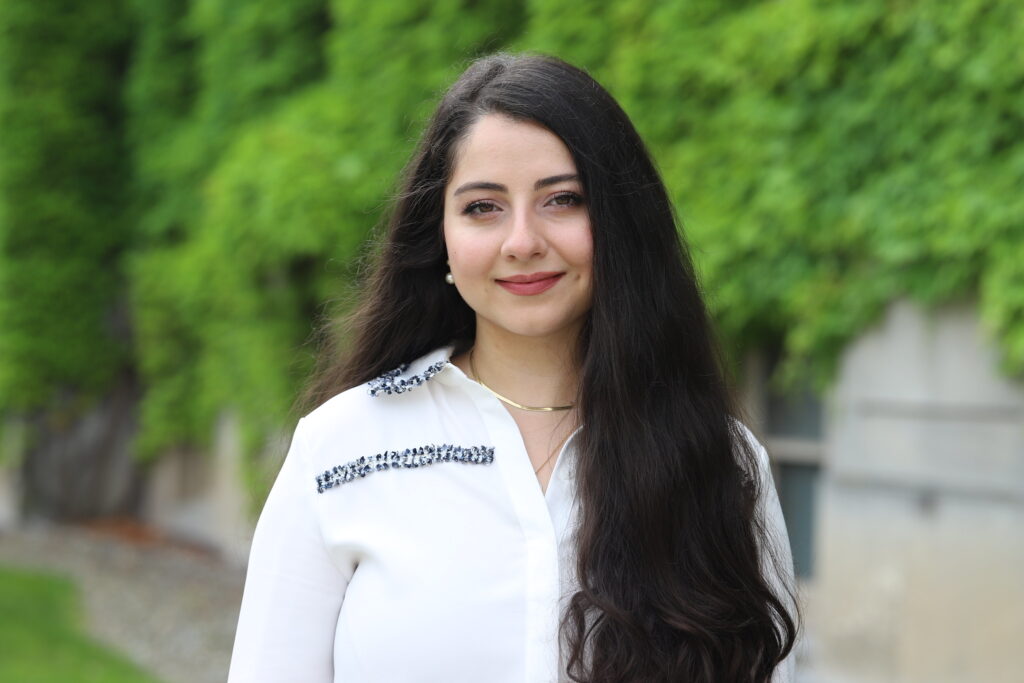
Sameeraa Soltanian-Zadeh ’26, a third-year Ph.D. student in mechanical and aerospace engineering, has been selected as an Innovation in Buildings (IBUILD) Graduate Research Fellow by the US Department of Energy (DOE). The fellowship is managed by Oak Ridge National Laboratory (ORNL) and administered by Oak Ridge Institute for Science and Education (ORISE).
The Graduate Research Fellowship aims to support the number of well-trained, diverse graduate student scholars prepared for research-intensive careers in fields supporting decarbonization. Recipients of the fellowship will receive financial support to conduct research at their home institution in an area that has shown relevance to advancing decarbonization efforts. Soltanian-Zadeh’s research focuses on indoor air quality and urban environmental dynamics, highlighting the effects of occupant behaviors on indoor air quality and building energy efficiency. This research will contribute to environmental justice, offering insights into public health, energy efficiency, and sustainable urban development, especially regarding the role of building occupants.
“By focusing on the intersection of indoor air quality, occupant behavior, and energy efficiency, my work has the potential to significantly impact how we design and operate buildings in the future. This research is crucial as we strive to create healthier, more sustainable urban environments while simultaneously tackling the urgent need for decarbonization,” says Soltanian-Zadeh. “Receiving the prestigious IBUILD fellowship marks a significant milestone in my academic journey and research career.
“This fellowship supports my ongoing work and is a step forward in my mission to create healthier, more sustainable built environments. The IBUILD program offers great opportunities to grow my skills, connect with other researchers, and learn about new developments in building science. Ultimately, it will help me contribute to a future where buildings not only meet energy needs but also enhance air quality and promote healthier living environments for all. I also want to thank my advisor, Professor Jianshun ‘Jensen’ Zhang, for his continuous support and guidance.”
“Sameeraa has made excellent progress in her Ph.D. study and played a key role in the project on ‘Integrated Whole-Building Energy Efficiency Retrofit Solution for Residences in Cold/Very Cold Climates’ and the Building America project on ‘Reducing Applied Losses in Heat Pumps’, both sponsored by DOE as well as the project on developing a multiscale building and urban environmental and energy monitoring systems supported by Syracuse Center of Excellence (SyracuseCOE)”, says Professor Jensen Zhang, Executive Director of SyracuseCOE and Soltanian-Zadeh’s Ph.D. study advisor.
Self-Following Smart Carts
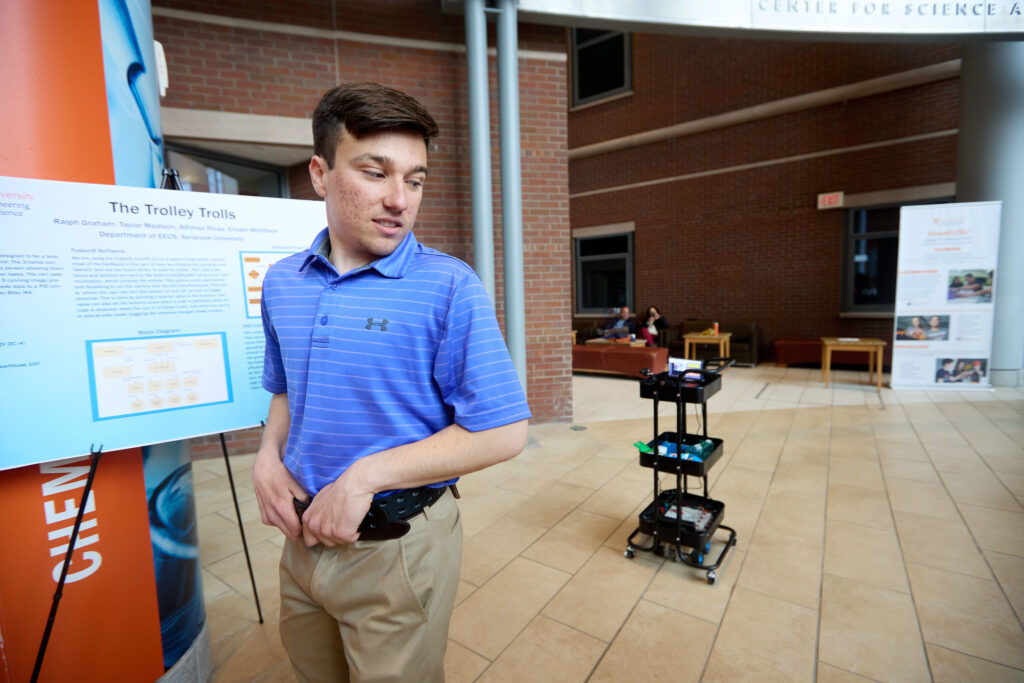
Trolley Trolls is a motorized cart designed to assist in carrying items, allowing users to have their hands free for other tasks. This original device was presented as a senior design capstone project at the College of Engineering and Computer Science’s Open House and was created by Ralph Lawrence Graham ‘24, Taylor Michael Madison ‘24, Alfonso Rivas ‘24, and Ernest Whitbeck ‘24. In this Q&A session, team members Graham and Madison discuss their project.
How does your senior design capstone project work?
Graham: Our project is a 3-tiered self-following motorized cart. The person using the cart wears a belt with a code on it. The code is then detected and that’s what triggers the cart to move. We used webcams attached to a Fusion 5 running image processing via Python that then feeds data to a PID controller system running on an Itsy Bitsy M4 chip to make the cart function.
Madison: We also talked about having distance sensors on the lower half of the cart. It goes much slower in reverse than it does forwards. If you go forward, it will go forward but if you come toward it, it will go backward but not as fast.
What inspired you to pursue this project?
Madison: Our team member, Alfonso, originally had the idea of a suitcase that would follow you through an airport. Some faculty didn’t know how practical placing a bunch of batteries and cameras on a suitcase would be, especially considering security risks for the Transportation Security Administration (TSA) and Federal Aviation Association (FAA).
We decided to go with something more utility-based that we could use around campus and came to a cart that could be used for a lab or food.
Are there other applications this motorized cart can have?
Madison: It can be applied to maintenance, hospitals, grocery stores, and even restaurants. We see all these areas benefiting from something like our cart for hands-free tasks.
How do you feel after completing your project?
Graham: We achieved what we were intending. It took a lot of research and trying things out. It was a process, and it was amazing to see the result of it and how everything works. It helped develop our skills more and we look forward to doing more things in a professional environment.
Madison: Even as a senior project that was supposed to be a showcase of what we’ve learned, we were learning continuously through this project. Continuously touching on other parts of engineering and developing skills we already have, it was great to put it all together.

Mechanical and Aerospace Engineering Student Andrea Hoe Joins NASA Graduate Research Fellowship
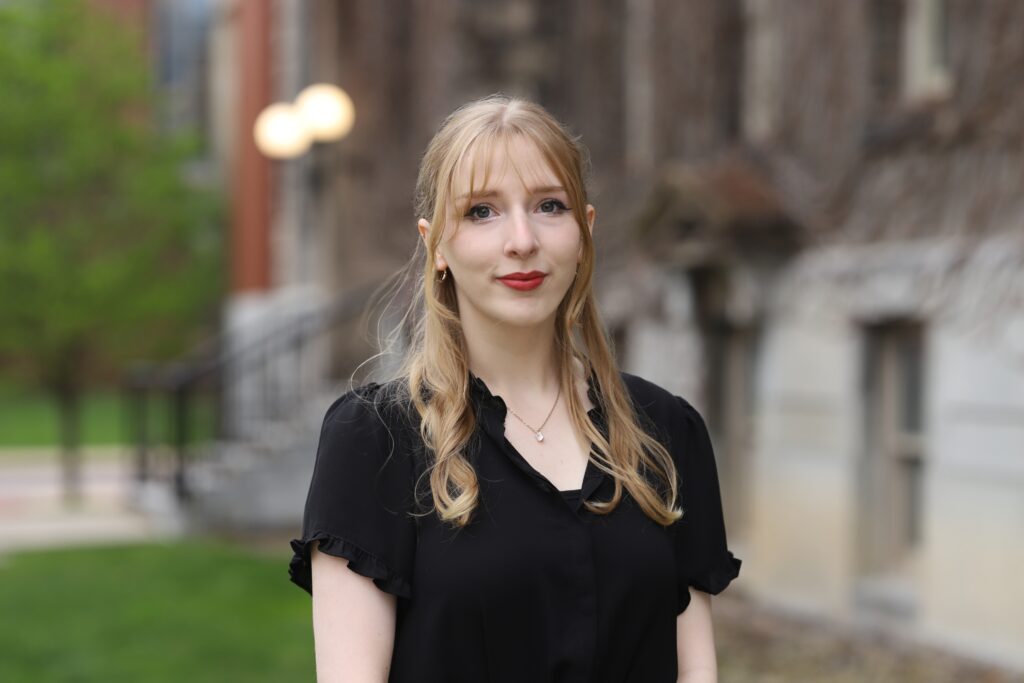
Andrea Hoe ‘23 G‘28 was ecstatic when she received an invitation to join NASA’s Graduate Research Fellowship program. It felt like years of hard work had finally paid off. She had always been fascinated with space, but it wasn’t until high school that she discovered her passion for space architecture. Since then, she’s made it her mission to work with NASA and continue exploring her interests in cutting-edge design.
“Whether it was participating in STEM programs or conducting independent research, my goals and achievements were strategic towards realizing my dream of becoming a space architect,” says the aerospace engineering student. “Now, to have the opportunity to collaborate with NASA feels like the culmination of a journey filled with challenges, setbacks, and moments of sheer determination. It is a surreal experience, and I am eager to begin this new chapter in my academic career.”
She initially began her undergraduate studies at Syracuse University as an architect student but found herself gravitating towards research opportunities. While architecture and space habitat design have their differences, she saw concepts that overlapped and knew she could apply her studies in architecture to space habitats.
“Architecture provided me with a solid foundation in design principles and unconventional thinking. I knew I wanted to apply this knowledge to engineering. I believe the intersectionality of disciplines is important in today’s time and will push society forward. By embarking on this academic journey, I aim to bridge the gap between creativity and innovation to explore new possibilities for space exploration.”
The NASA Fellowship sponsors graduate student research and development of innovative space technologies. The fellowship includes a research grant, which will provide her the opportunity to research lunar regolith composites with carbon nanotubes for space habitation applications. The study aims to create a concrete-like structural material that can be made from soil on the moon, which is known as lunar regolith.
The primary focus of the research is to investigate the effects of adding carbon nanotubes to lunar regolith. Even a small amount of these nanotubes can significantly enhance the compressive strength of the lunar soil, making it an ideal choice for durable structural material in space architecture. “Our future testing plans are diverse and exciting as we aim to delve deeper into optimizing the composition and properties of this lunar regolith-based material. Space is an extreme environment, so exploring its durability and resilience is imperative.”
She believes this research is pivotal to ensuring secure and stable habitats on the moon as well as manned missions to Mars and beyond, paving the way for the future of human space exploration. “Syracuse’s architecture program empowered me to be creative and think critically, particularly in my final thesis project. The aerospace engineering department has allowed me to pursue my ambitions and gain insightful experiences. I am truly grateful. Receiving the NASA Fellowship and grant is an indescribable event for me. It is a validation of years of hard work, dedication, and unwavering determination.
“I am so grateful for the support from the professors at Syracuse who assisted me in this journey and for the recognition from an institution as esteemed as NASA. I am particularly grateful for the mentorship of my research advisor, Dr. Wang, whose guidance and support have made this possible.”
Electrical and Computer Engineering Students Develop Plastic Sorting Robot for Waste Management
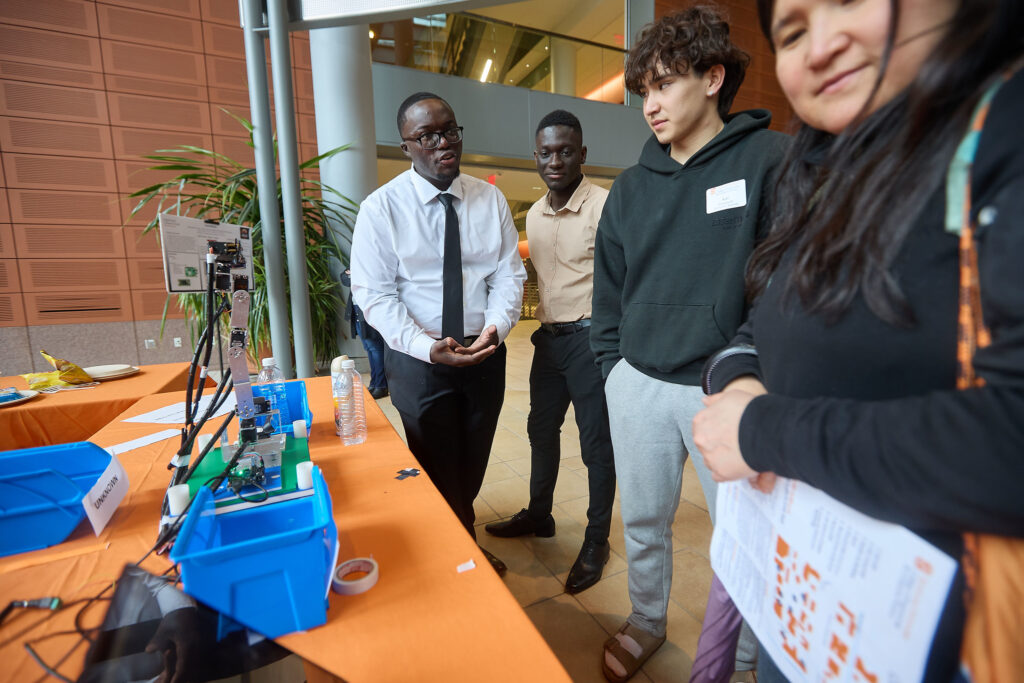
As engineering students Fundi Juriasi ‘24, Hanna Salem ‘24, Prince Sarquah ‘24 and Sukhleen Atwal ‘24 brainstormed ideas for their senior design project, they couldn’t seem to land on an idea they all agreed on. Sarquah’s interest lay in robotics, Juriasi was fascinated with face-tracking cameras, and Salem liked the idea of a Lego sorter that could assort the bright-colored blocks by color. Inspired by her passion for the environment, it wasn’t until Atwal combined their ideas that the group finally came to a project they all loved: a camera-tracking, plastic-sorting robot.
Plastic pollution continues to be a significant environmental issue, with millions of plastic items entering our planet’s oceans every year and this is often due to improper waste disposal. The engineering group’s plastic sorting robot shows promise in enhancing current waste management methods by automating the sorting process. They believe that this technology could play a crucial role in reducing landfill waste, increasing recycling rates, and promoting more sustainable practices.
“Most plastics come with recyclable code, but the problem is, sometimes the code gets damaged, and it can’t be seen without advanced cameras,” Juriasi says. “We wanted to make our project more achievable, so we placed QR codes on objects to mimic how it can be implemented in the real world.”
Their robot, ARMie, uses a camera to scan QR codes and identify the type of material based on the code. With instructions from the user interface, ARMie sorts each item into the appropriate bin for recyclable, non-recyclable, or further sorting. This innovative system streamlines the recycling process, enhancing its efficiency and accuracy.
The hardware consists of the microcontroller board Arduino Uno, a robotic arm, servo motors, a PWM/servo driver, a camera, bins, and a power supply. The key technologies and software used for the project include the open-source code-writing software Arduino IDE, Python, graphical user interface (GUI), and QR codes.
Despite the challenges that came with putting this ambitious project together such as mechanical durability and power supply balance, the students were able to present ARMie at the College of Engineering and Computer Science’s (ECS) Open House. “Overall, I would say this project was good. It has real-world applications and potential to impact sustainability,” says Salem.
“By integrating technology with environmental sustainability, ARMie facilitates a smarter way to manage waste, offering a significant step forward in our recycling efforts,” says Juriasi.
Mechanical and Aerospace Graduate Student Melissa Yeung Joins National Science Foundation Graduate Research Fellowship

Melissa Yeung, a first-year Ph.D. student in mechanical and aerospace engineering, has joined the 2024 National Science Foundation (NSF) Graduate Research Fellowship Program (GRFP). The fellowship offers three years of support for graduate research over a five-year period.
Yeung currently works in the fluid dynamics lab of Yiyang Sun, assistant professor of mechanical and aerospace engineering, and her research focuses on supersonic jet engines. “The goal of my work is to alleviate the undesired features through strategically placed small micro-jets of air,” Yeung says. “I am currently focused on optimizing these micro-jets such that they can continuously modulate themselves to adapt to various flight conditions. By doing so, the flow can be controlled even in off-design conditions and with minimal energy input.
“Understanding these complex flow physics is vital for the development of next-generation high-performance aircraft. Successfully controlling this flow can improve upon the aircraft’s performance and ensure the safety of nearby workers or civilians. This work is one of many steps in pushing supersonic flight for commercial use.”
Yeung believes the fellowship will give her greater flexibility in her research, fund her research activities and enable her to attend more conferences. She’s also grateful for the support she’s received from Sun, Professor Emeritus Mark Glauser, and Gina Lee-Glauser, retired vice president for research.
“Their guidance has been crucial to my success and without them, I would have not had the honor of being an NSF GRFP recipient,” Yeung says.
Professor Emeritus Mark Glauser Receives 2024 American Institute of Aeronautics and Astronautics (AIAA) Fluid Dynamics Award

Professor Emeritus in mechanical and aerospace engineering, Mark Glauser, has received the 2024 American Institute of Aeronautics and Astronautics (AIAA) Fluid Dynamics Award. The award recognizes individuals with outstanding contributions to the understanding of liquid and gas behavior in motion and notable accomplishments within the aerospace community. This prestigious award is proudly sponsored by the AIAA Fluid Dynamics Technical Committee.
Glauser was selected for his seminal contributions to the innovative use of multi-point low-dimensional methods for understanding and control of turbulent flows. He will be recognized during the 2024 AIAA AVIATION Forum and AIAA ASCEND event in Las Vegas, Nevada in July. He will also give a special Fluid Dynamics Award Lecture.
“This is indeed a great honor for me and reflects very positively on the Syracuse University mechanical and aerospace engineering department and the approximately 70 of my outstanding MS and Ph.D. students who have been key to my success,” says Glauser.
Civil and Environmental Engineering Research Group Wins 2024 Best Case Study Award from Environmental and Water Resources Institute
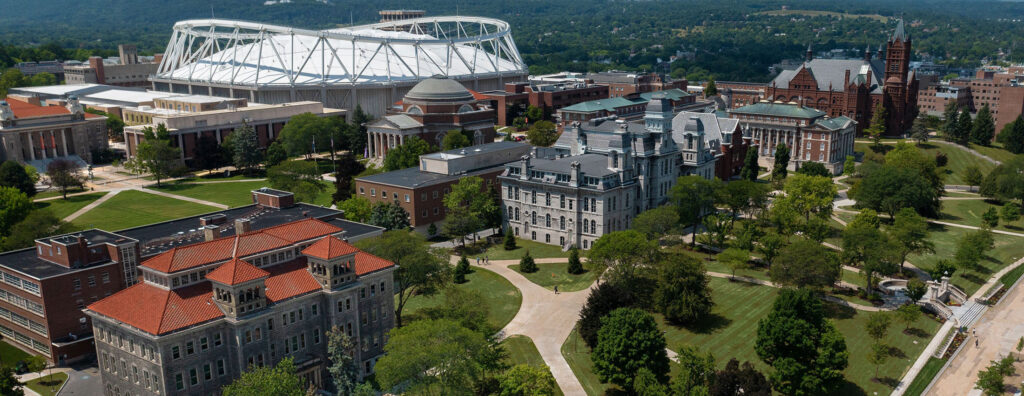
A civil and environmental engineering research group has won the 2024 Best Case Study Award in the Journal of Sustainable Water in the Built Environment. The paper was written by graduate student Lucie Worthen G’19 along with Assistant Professors Christa Kelleher from the College of Arts and Sciences and Cliff Davidson from the College of Engineering and Computer Science (ECS). The award is nominated and selected by the Environmental and Water Resources Institute (EWRI) editorial board.
The research group was awarded for their work on “A Diagnostic Analysis of Low-Impact Development Simulations with Stormwater Management Model (SWMM).” The paper compares the results of the SWMM of the U.S. Environmental Protection Agency with measurements of stormwater runoff from the green roof of the Nick Pirro Convention Center owned by Onondaga County.
Worthen, Kelleher, and Davidson will be recognized at the 2024 American Society of Civil Engineers (ASCE) Convention during the awards and lectures presentation.
Electrical and Computer Engineering Students Develop Smart Cane for Vision Accessibility
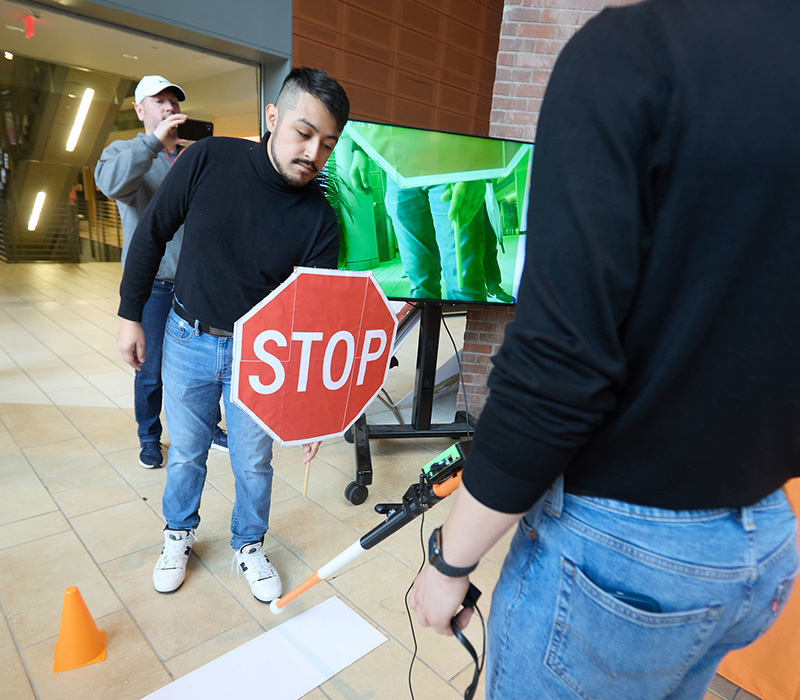
New York City has over 12,000 miles of sidewalks, thousands of buses, and a huge transit system that can get you from one end of the city to the other. It’s perfect for pedestrians – but how accessible is it?
Vision loss affects hundreds of New Yorkers, who may find it difficult to navigate sidewalks, crosswalks, and intersections. However, steps are being taken to address these accessibility issues. Along with recent federal court orders for NYC to install accessible pedestrian signals throughout the city, four electrical and computer engineering students are taking accessibility a step further with their navigational cane, Pear Vision+.
“We knew we wanted to make something that was really practical and useful,” says Armani Isonguyo ‘25. “Traditional canes serve only as a physical extension of the user, providing information of any obstacles within 5 feet proximity. Our cane offers comprehensive navigational aid.”
Created by Isonguyo, Alexander Segarra ‘24, Elliot Salas ‘24, and Isaish Fernandez ‘24, the engineering group’s smart cane can identify obstacles in a person’s way, which direction they’re facing the obstacle, and whether the objects are moving. It also provides feedback through audio descriptions via Bluetooth and vibrations, giving users a better understanding of their surroundings.
“I love video games and Nintendo Switches and PlayStation 5s all incorporate vibration into gameplay,” Salas says. “The original idea was actually to put a PlayStation 5 motor in the cane for vibration, but we used a 5V haptic motor disk instead.”
The smart cane is equipped with NVIDIA’s Jetson platform, which helps it identify objects in the surrounding environment. It also has a depth-sensing camera that can determine distances and create a three-dimensional view of the environment. This assists visually impaired individuals in identifying obstacles in real time and navigating their surroundings safely. The cane was also modeled using Shapr3D, a 3D modeling tool.
“With the design, we didn’t focus too much on the length or thickness of the cane, based on previous inspirations in the real world,” says Segarra. “We focused more on the handle and the angle you would want to hold so it doesn’t break.”
The students presented Pear Vision+ at the College of Engineering and Computer Science’s (ECS) Open House and also won the William Peil Award for the best electrical engineering and computer science senior design project. They see potential for their project to impact the lives of many.
“I saw this project as one that was meaningful in advancing a certain industry and the world. I’m glad to be part of something that can be impactful,” says Segarra.
“This project not only pushed the boundaries of what we can achieve with technology but also taught us the importance of engineering solutions that make a real difference in people’s lives. We are proud to contribute to a more accessible world,” says Isonguyo.
Get to Know New Biomedical and Chemical Engineering Professor Michael Blatchley

Michael Blatchley’s broad experiences in biomedical engineering and interests in tissue formation made him the perfect fit for both the College of Engineering and Computer Science and the BioInspired Institute. Get to know Blatchley as he discusses his career path, advice to students, and his new role as an assistant professor.
Tell us about yourself and what brought you to Syracuse University. What sparked your interest in teaching here?
I’m originally from Indiana, went to Purdue in my hometown of West Lafayette, lived in Baltimore, Maryland for graduate school at Johns Hopkins, moved to Boulder, Colorado during my postdoc, and now, of course, I’m in Syracuse. I’ve been lucky to experience many different areas of the country and loved my experiences in each place, but Central New York fits my interest in the outdoors, and Syracuse itself has been a great fit for my family.
I was drawn to Syracuse University by my great interactions with faculty and students, the investment in junior faculty, and the collaborative nature of a lot of the current research on campus. I can envision numerous collaborations within biomedical and chemical engineering (BMCE) as well as across disciplines in other departments. I’m really looking forward to working as part of the BioInspired Institute because I of course love the science and engineering components, but I also love the arts and think the crossover between the arts and sciences can lead to interesting and innovative ideas.
What are your research interests?
Despite my earliest career aspirations to become an NBA All-Star, my genetics precluded me from success along that career trajectory, so I decided instead to pursue a career in academia.
I’m interested in understanding how tissues form, and how we can take what we learn from biology to build ever-improving models of human tissues in the lab. We can use these models to understand aspects of fundamental biology and tissue regeneration, but also to model disease and, perhaps someday, produce lab-grown tissues for transplantation.
What made you interested in this research?
I became interested in this type of work through a circuitous path spanning a few different fields. When I was an undergraduate, I chose to major in Biomedical Engineering because I had broad interests in all fields that made up the “fundamentals of engineering,” and I liked how those could be applied to solving problems in human health. I also knew I was interested in research, so I looked for a number of different summer research opportunities throughout my undergraduate years.
I first worked at a small startup/contract research company synthesizing and characterizing different biomaterials for medical applications. I then worked in plant biochemistry for a summer through a program funded by HHMI to merge statistics and biology, where I learned a lot of transferrable research skills and how genetically modified organisms can be used to study fundamental science toward real-world applications. Finally, I worked in a clinical research lab with a focus on pulmonology. These broad experiences, combined with my exposure to tissue engineering during a course in my senior year, laid a perfect foundation for me to pursue a PhD with a focus on tissue engineering.
I went into the PhD program with more of an interest in translational work but really developed a love for work in building fundamental in vitro models as well. Since then, my work has spanned the spectrum of tissue engineering, from projects focused on more fundamental modeling of regeneration to designing materials to better characterize in vitro organ models, to engineering dynamic materials to control how tissues form in a reproducible and predictable way. I am fascinated by learning how tissues grow so we can better grow them ourselves, and the field of tissue engineering is perfect to pursue research questions around this central premise.
What are you most excited about in your role as an assistant professor?
Something that really attracts me about academia is the intellectual freedom. Along those lines, I am looking forward to continuing my own work and following my research interests in new directions through collaboration and discovery. But what I’m looking forward to even more is helping guide and mentor students and other trainees toward finding what they are passionate about in research or in their chosen career paths.
What advice do you have for students?
Don’t be afraid to go out of your comfort zone and learn new things. My most memorable classes helped me broaden my interests rather than narrow my scope of study. The same goes for research. I worked in a wide range of fields that helped me refine my interests to pursue research I was passionate about.
Always ask a question if you have it (maybe ask it in your head one time before you ask it out loud to make sure it’s thoughtful and constructive, but don’t be afraid to ask it!).
What are some things you like to do for fun?
I love to spend time with my family outside, hiking, biking, running, skiing, etc. I’m also a film buff, but weirdly my 18-month-old daughter isn’t as interested in Lynchian horror and 80s schlock as I am. I like to cook and bake, as well. Reviews range from feigned interest to shocking surprise.
Mechanical and Aerospace Engineering Senior Capstone Teams Present Designs to Industry Partners
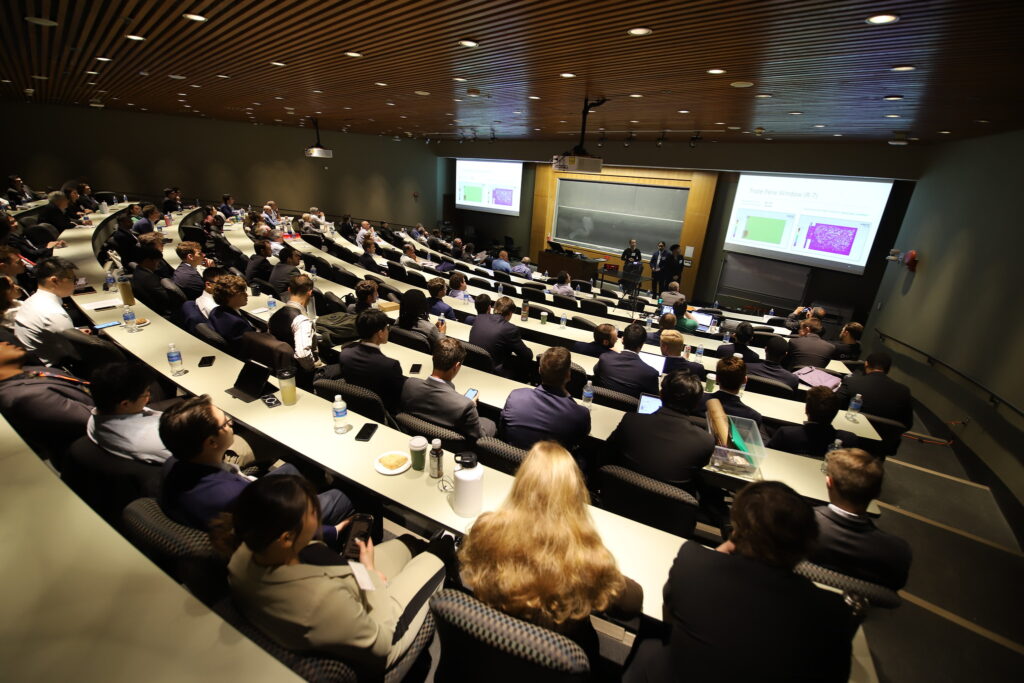
19 teams of engineering students presented their designs to industry partners at the end of the 2024 spring semester. These presentations were part of their senior capstone design course spanning the fall and spring semesters. Each team worked directly with their company sponsor to solve complex engineering problems. The top three capstone teams won a monetary prize based on the judges’ scores and this year’s winners were Pursuit Aerospace (first place), Govsphere (second place), and Aerovec (third place).
“I am so proud of all of my students who presented their senior design capstone projects to a panel of 14 industry expert judges,” says Kenneth and Mary Ann Shaw Professor of Practice in Entrepreneurial Leadership Alex Deyhim. “Each team presented the results of their year-long company-sponsored projects. They also gave poster presentations to our esteemed guests during the networking lunch.
“We are grateful to our 19 faculty mentors who worked with the teams all year, and to our esteemed panel of judges who gave their time and expertise to provide invaluable feedback to the teams. We also want to thank Boeing Corp. for sponsoring the Boeing Award. All the teams gave amazing presentations and determining the winners required calculating the scores to three decimal places!”
The projects and companies that students worked with in the 2023-2024 academic year were:
American Society of Heating, Refrigerating and Air-
Conditioning Engineers (ASHRAE)
Integrated Sustainable Building Design: Designed an HVAC System for a new library in São Paolo, Brazil.
Hydronic Shell
Simulation of a Novel Heating & Cooling Concept: Identified the key components of the design for the Hydronic Shell, a modular HVAC system integrated into panels that form an insulated shell over an existing building.
Pursuit Aerospace
CNC Machining Fixture – Clamp Redesign: Manufactured all components to be used within the CNC machine and enhanced the overall performance of the clamping mechanism.
Aerovec
Small-Scale Wind for Rooftop Applications: Assisted with the design of a small-scale wind turbine that could be installed on rooftops for commercial, industrial, and agricultural applications.
National Institute of Standards and Technology (NIST)
Neutron Velocity Selector Test Base and Cover: Designed a permanently mounted base with an attached protective cover to house all models of NVS during the testing phase and ensure the safety of all test participants in the event of a worst-case scenario.
American Society of Naval Engineers (ASNE)
Promoting Electric Propulsion (PEP): Designed and built an aquatic vessel propelled by electrical propulsion.
New York State Department of Transportation (NYSDOT)
Deformation of Elastomeric Bridge Bearings: Determined the maximum horizontal shear force bridge bearings could withstand before permanent deformation.
Microsoft
Bifacial Coldplates for High Power Servers: Developed a liquid-cooled server to provide efficient and adequate heat transfer from protected and stressed equipment.
Corning
Generative AI for Solving Real-World Problems: Improved mechanical engineering design processes by eliminating the manual operation of 3D design software through means of generative AI.
Boeing
Sustainable Composite Materials for Aircraft Interiors: Investigated the feasibility of sustainable composite alternatives to address end-of-life and environmental issues without sacrificing durability or product quality.
Lockheed Martin
Additively Manufactured Cold Plate: Investigated, analyzed, procured, and tested AM cold plate designs that were representative of designs under consideration for use in high heat dissipating electronic module assemblies.
Lote Biologics
Utility Steam Generation Plant Design: Developed an appropriately sized new design, which met current and future facility demands in a highly efficient manner.
Thermal Space
Lightweight Graphene Radiators for Space System: Developed a baseline radiator panel design that could help to predict performance such as heat rejection capacity as well as temperature gradients.
SEPAC
Universal Torque Testing Machine: Developed and prototyped a torque and burnishing system for electromagnetic clutches and brakes for SEPAC.
Northrop Grumman
Generate an Empirical Database to Characterize Critical Oscillating Heat Pipe: Designed and tested physical OHP heatsinks to determine which design would allow for the highest heat flux in a system.
L3Harris
Universal Adjustable Antenna Mounting System: Created a sustainable, reliable, and user-friendly solution for temporary communications systems installation on helicopters.
Govsphere
Modernization of MedX Rehab Medical Machines: Designed the next generation of the MedX Rehab Lumbar Extension and Cervical Extension machines, integrated electric motors, and redesigned the counterbalance, weight stack, and frame of each machine.
SAAB
Micro-Unmanned Underwater Vehicle STEM Design: Designed and constructed a cost-effective modular STEM kit variant of a military micro-unmanned undersea vehicle (UUV) at a reasonable cost for academic use.
Electrolux
AGV (Automated Guided Vehicles): Evaluated implementing Automated Guided Vehicles (AGVs) at the Kinston, North Carolina facility and facilitated efficient transportation of materials, including raw and assembled sumps, within the facility.

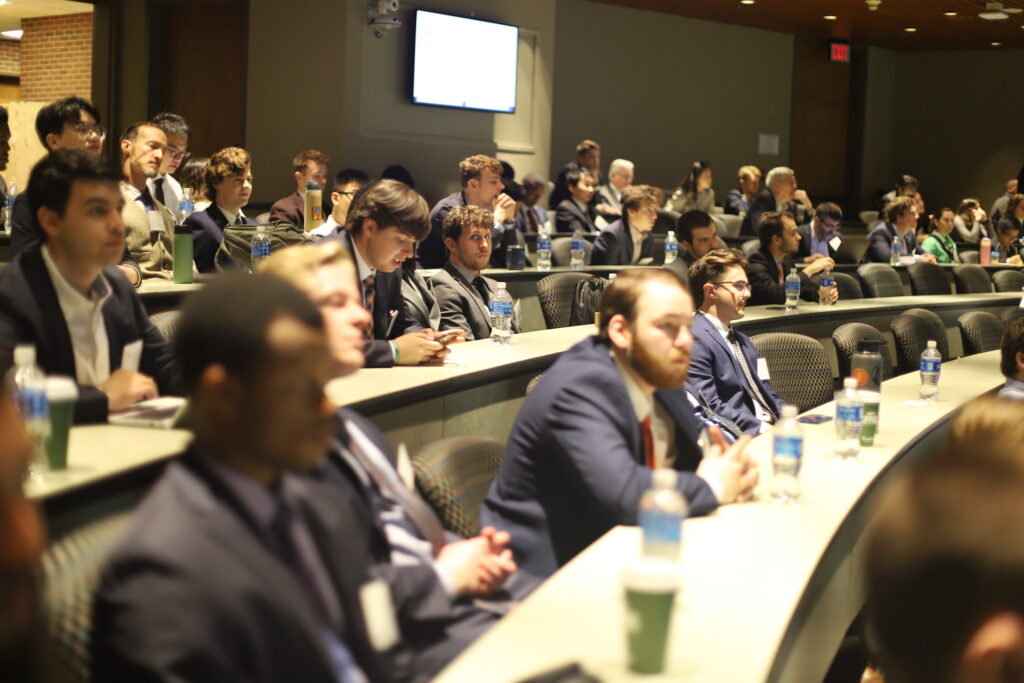
Civil and Environmental Engineering Students Participate in Sustainable Solutions and Steel Bridge Competition
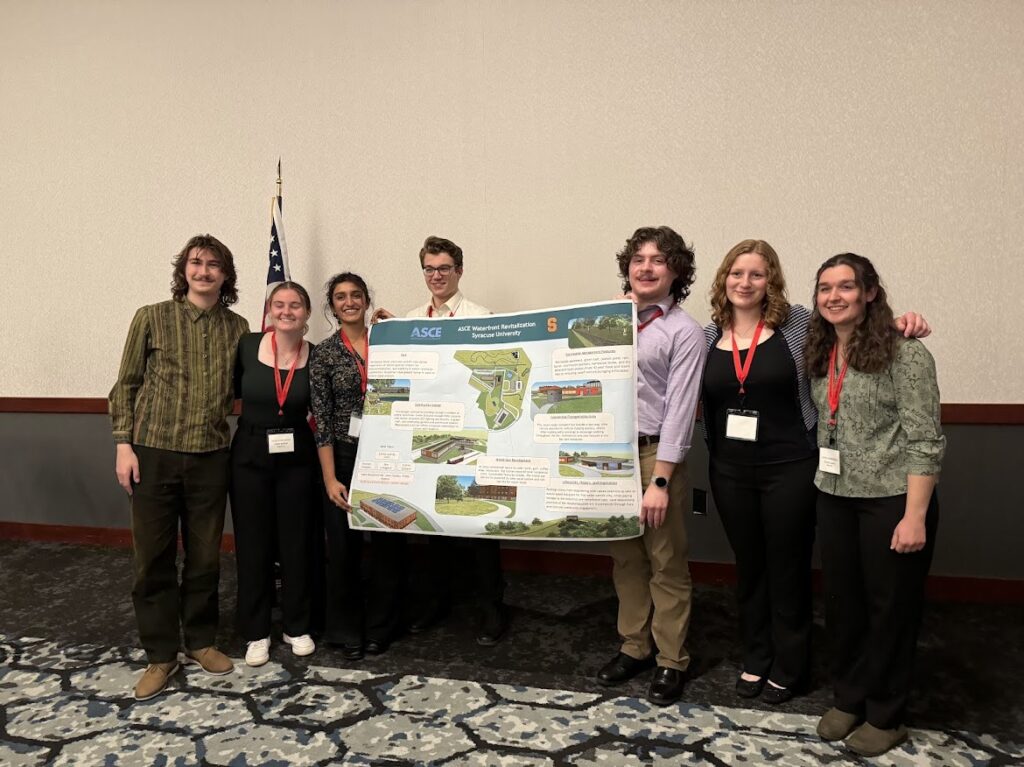
Four civil and environmental engineering students in the College of Engineering and Computer Science (ECS) won first place in the regional American Society of Civil Engineers (ASCE) Sustainable Solutions Competition. The competition took place at the Upstate New York-Canada ASCE Student Symposium at Rensselaer Polytechnic Institute (RPI) in mid-April, and the team consisted of Emma Liptrap ’24, Ananya Chandra ’24, Sam Livingston ’24, and Caitlin Spillane ’24. Liptrap served as team captain.
The ASCE competition challenges students to understand and implement sustainable solutions and the primary goal of the team’s project was to reinvigorate a fictional city’s waterfront. They designed a community center, a mixed-use development, a commercial area, and a waterfront park with pedestrian pathways and a bus loop with accessibility throughout the site. The waterfront’s innovative design also utilized green infrastructure to manage stormwater and mitigate flooding. The design exceeds the “Superior” level of the Institute of Sustainable Infrastructure’s ENVISION framework.
Additionally, a group of seven civil and environmental engineering students participated in the Student Steel Bridge Competition at RPI and the student team consisted of Patrick Alberga ‘25, Henry Bievenue ‘24, Henry Long ‘25, Sumit Mistry ‘24, Maxwell Pozar ‘25, Aaron Shinn ‘25 and Arturo Venegas ‘25. Shinn served as team captain.
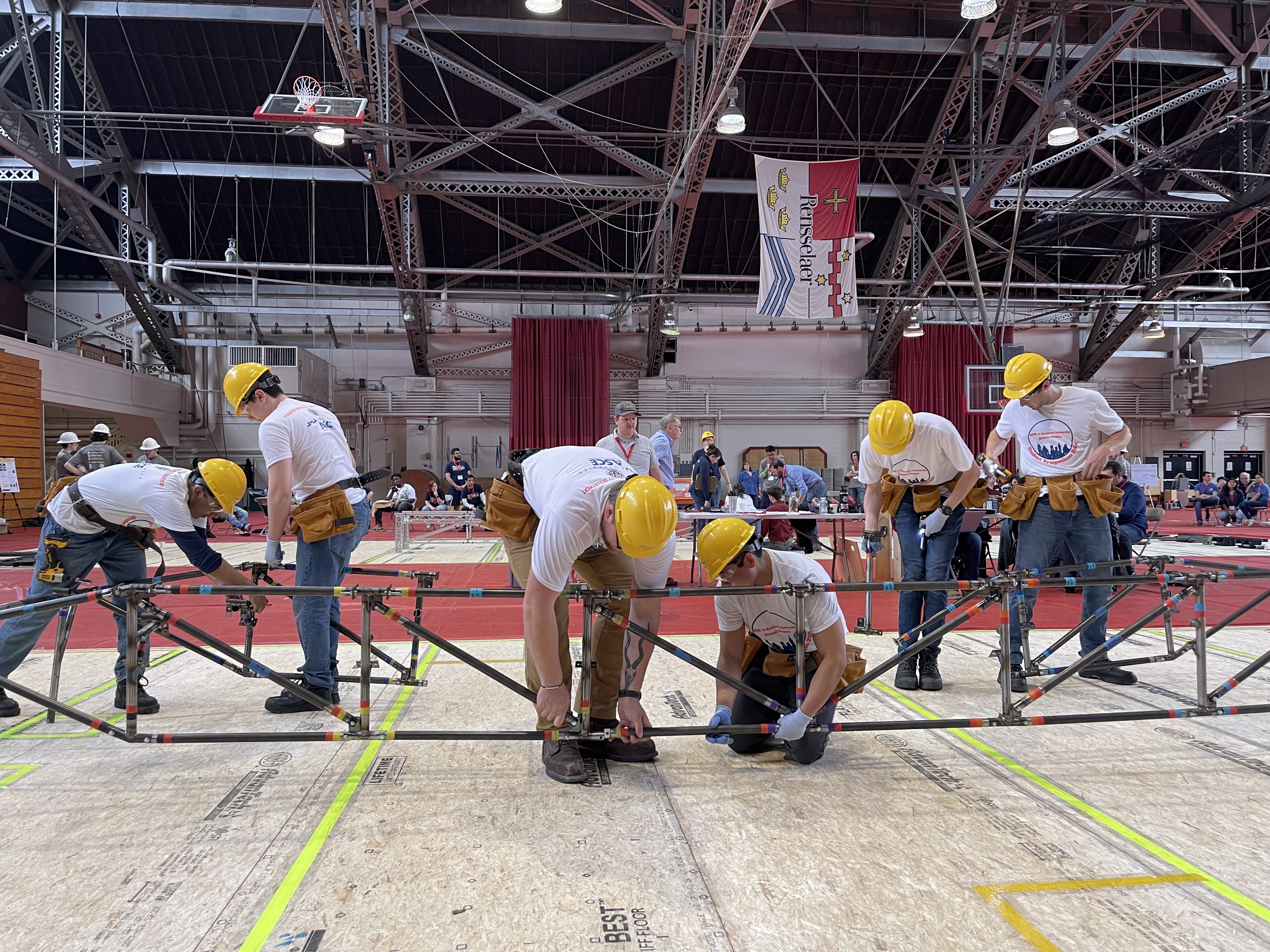
The Steel Bridge Competition challenges students to create a scaled-model steel bridge. The team designed, fabricated, and constructed a 150 lb. and 21-foot-long steel bridge in segments and assembled the segments into a fully functional bridge within a time limit. The bridge was then subjected to various geometry and loading tests during the competition.
The Sustainable Solutions team has received an official invitation to compete at the 2024 ASCE Student Championships at Brigham Young University in June and is preparing for the national competition.
Biomedical and Chemical Engineering Students Present Senior Capstone Design Projects
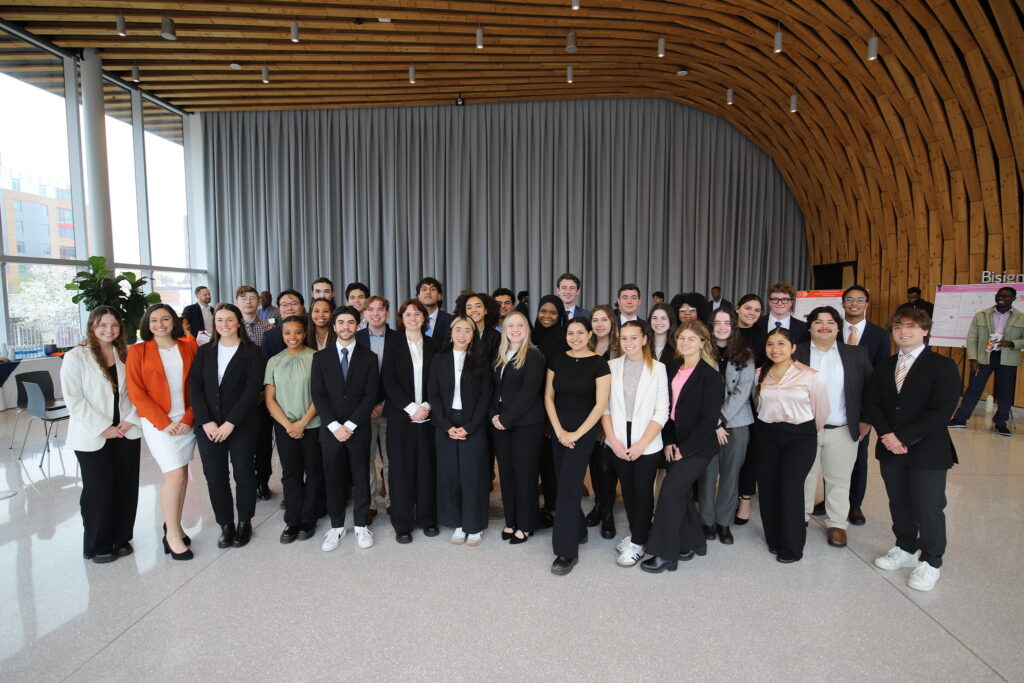
Biomedical and chemical engineering (BMCE) students presented their senior capstone design projects at the National Veterans Resource Center (NVRC). The presentations consisted of seven biomedical engineering teams and three chemical engineering teams. Members of the BMCE Advisory Board, consisting of industrial and academic representatives, served as judges for the poster session. This senior design course challenges students to study real-world issues and develop a solution from concept to prototype.
Triple C+: An Adaptive Neck Orthotic
Develops a neck orthotic focused on comfort, adaptability, and safety for patients with neck muscle weakness.
Members: Colin Babick, Shaila Cuellar, Roxana Gomez, Brenna Henderson
Client: Sarah Seib
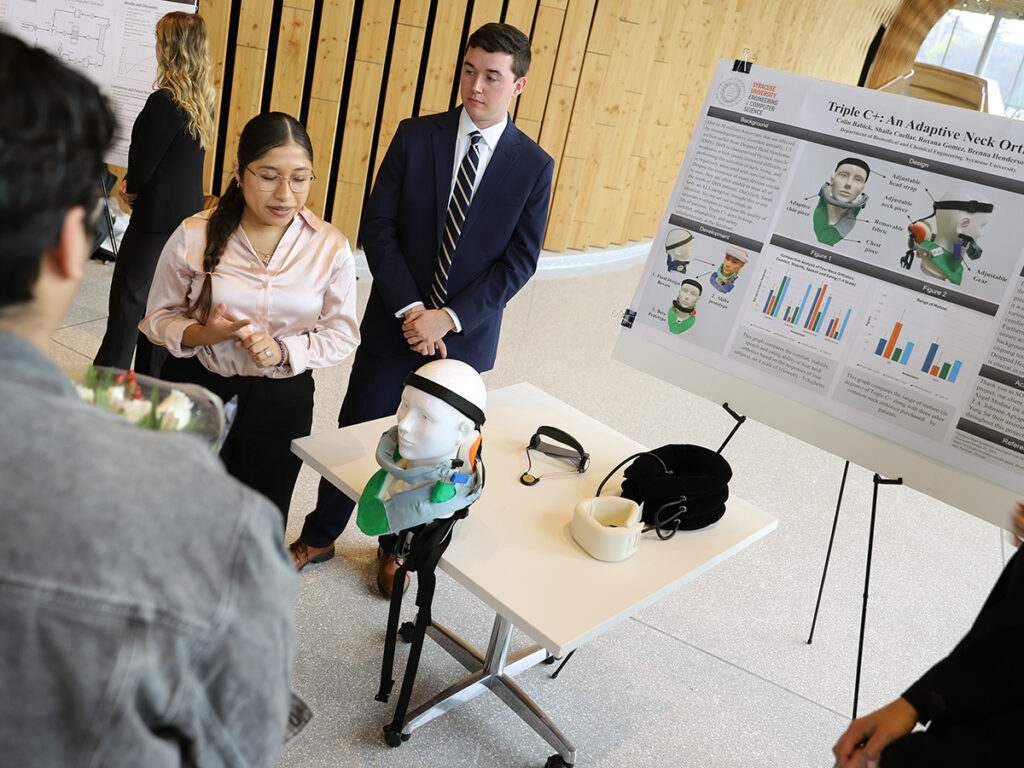
BiRed Breast Cancer Imaging Table
Aims to revolutionize breast cancer diagnosis by enhancing patient comfort and accessibility
Members: Jonathan Hernandez, AMathieu Barthelemy, Dominic Clinch, Jonathan Ngo, Alyssa Shelburne
Client: Dr. Satish Kandlikar, CEO of BiRed Imaging
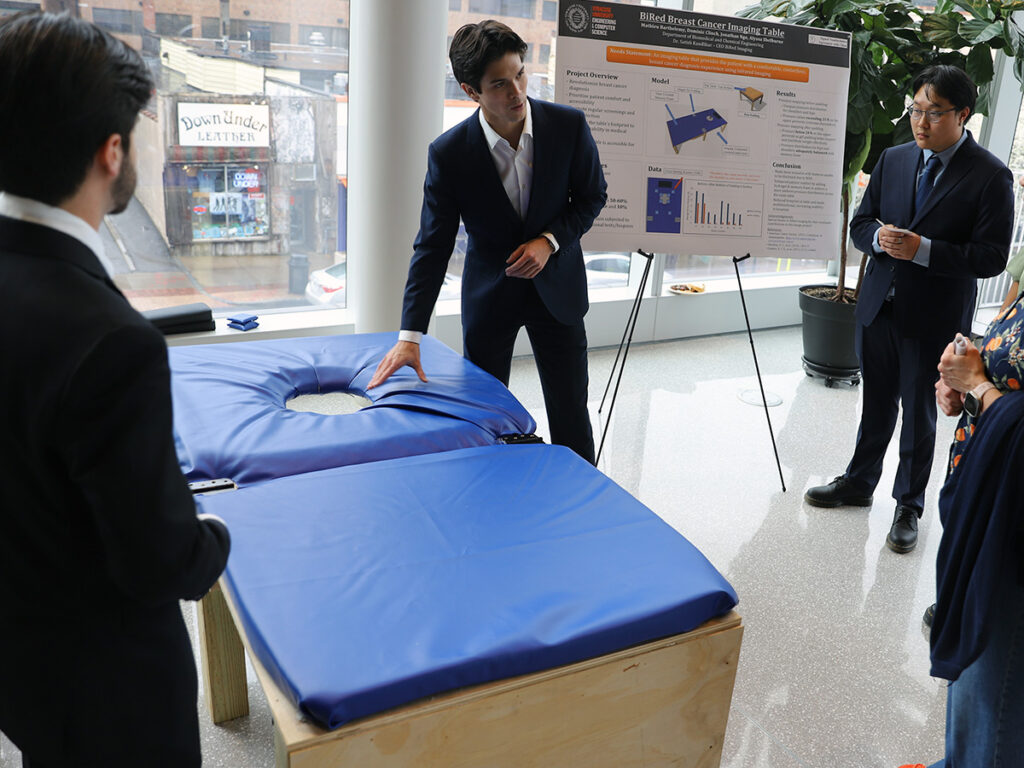
Gait 2 Go: Gait Analysis Anytime Anywhere
Simplifies gait analysis for clinicians by eliminating the need for expensive labs and gait experts
Members: Jade Carter, Shane Corridore, Cait Mehl, Lukas Cook
Client: Dr. Rajin Shahriar, Pediatric Orthopedics, SUNY Upstate Medical University

Epic Airways: Parallel Path – An Alternative Method for Intubation
Develops a hybrid intubation device combining endotracheal tube and laryngeal mask to reduce procedure risks and costs
Members: Jonathan Hernandez, Adam Spadafora, Haven Wittmann, Julian Zorn
Clients: Keith McKenna and Eric Moses at Epic Airways Systems, Inc.
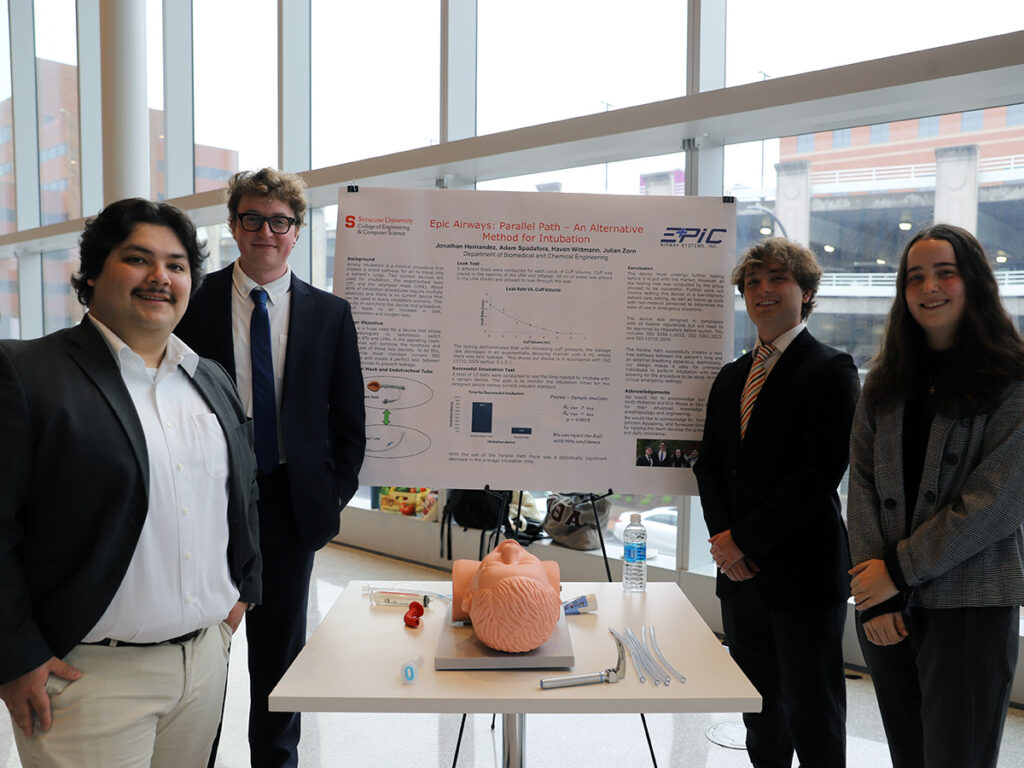
Temperacare: A Digital Cooling & Heating Pack
Creates a versatile therapeutic device providing both cooling and heating to aid
Members: Oumou Azika, Paige Bencivenga, Jillian Durand
Client: BZDesign, Inc.
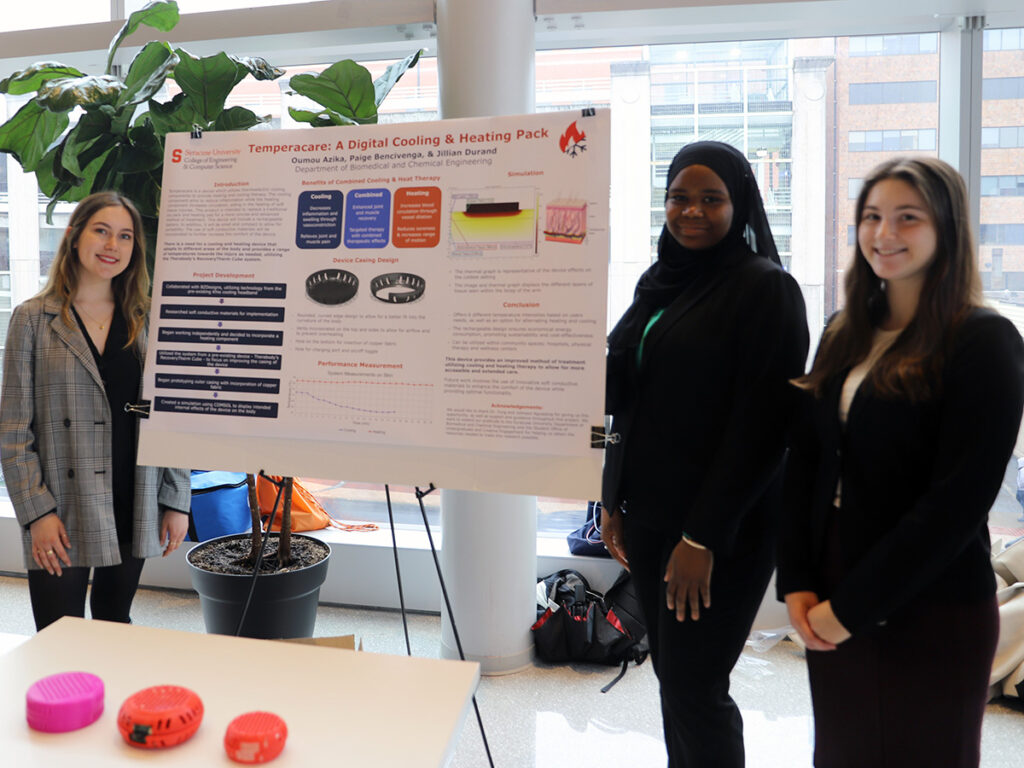
Prognosis of Prostate Cancer Metastasis Risk Through qPCR
Focuses on improving the detection of a specific prostate cancer biomarker using optimized qPCR
Members: Anthony Watt, Emily Labour, Ethan Masters
Client: Dr. Leszek Kotula, Urology, SUNY Upstate Medical University

P.I.B.I. Check: A Portable Impedance Breast Imaging Device
Designs an accessible, low-cost device for early breast cancer detection based on tissue impedance
Members: Carly Ward, Elizabeth Su, Isabelle Lewis, Mia-Marie Fields, Anthony Acierto
Clients: Dr. Neb Duric and Dr. Jennifer Harvey, Imaging Sciences, University of Rochester
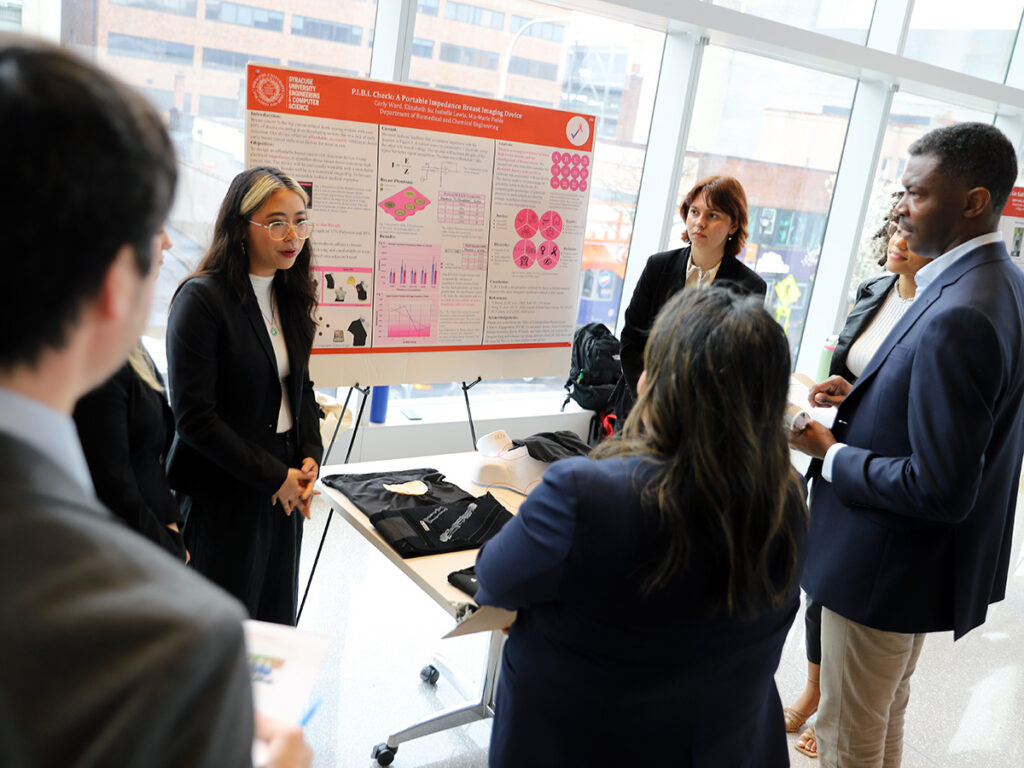

Bioprocess Plant Design for 5-Hydroxymethylfurfural Synthesis from Chlorella Vulgaris
Team Stokes: Trinity Coates, Arsh Shaikh, Sean O’Toole, Tomas Posada
Biodiesel Production via Heterogeneously Catalyzed Transesterification of Scenedesmus sp. Microalgal Oil
Breaking Bonds, LLC: Olivia Conlin, Emily Fittante, Cole Fluker
Purifying Contaminated Freshwater: Degradation of Per- and Polyfluoryl Alkyl Substances (PFAS) with Chemical Oxidation
Team No Crumbs: Karley Chambers, Samantha Esparza, Fabiana Perez
Engineering and Computer Science Views – Spring 2024

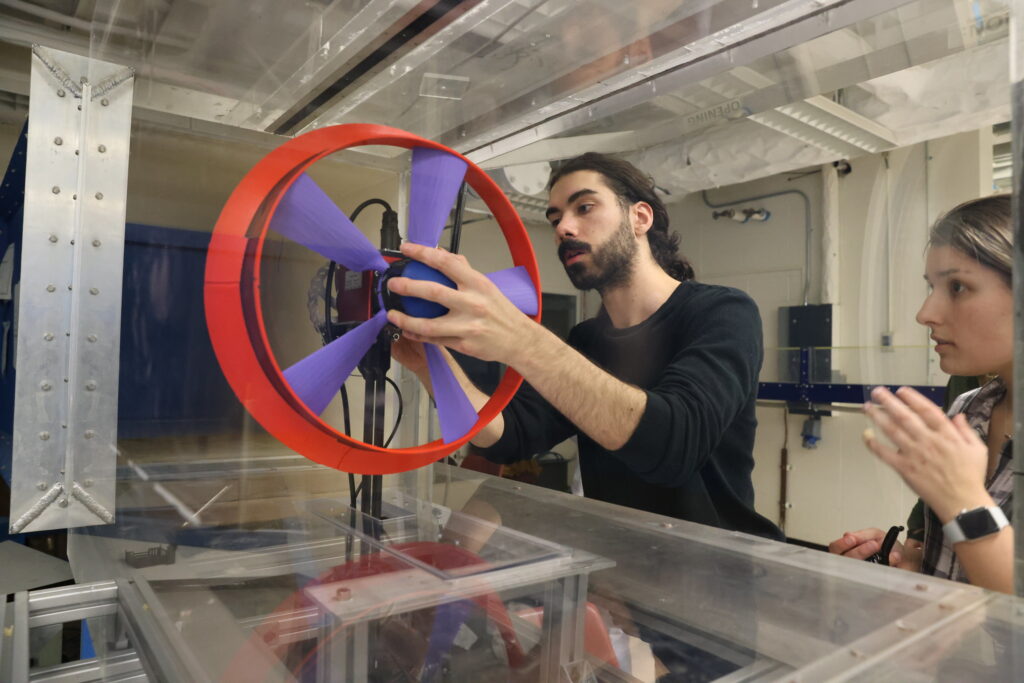
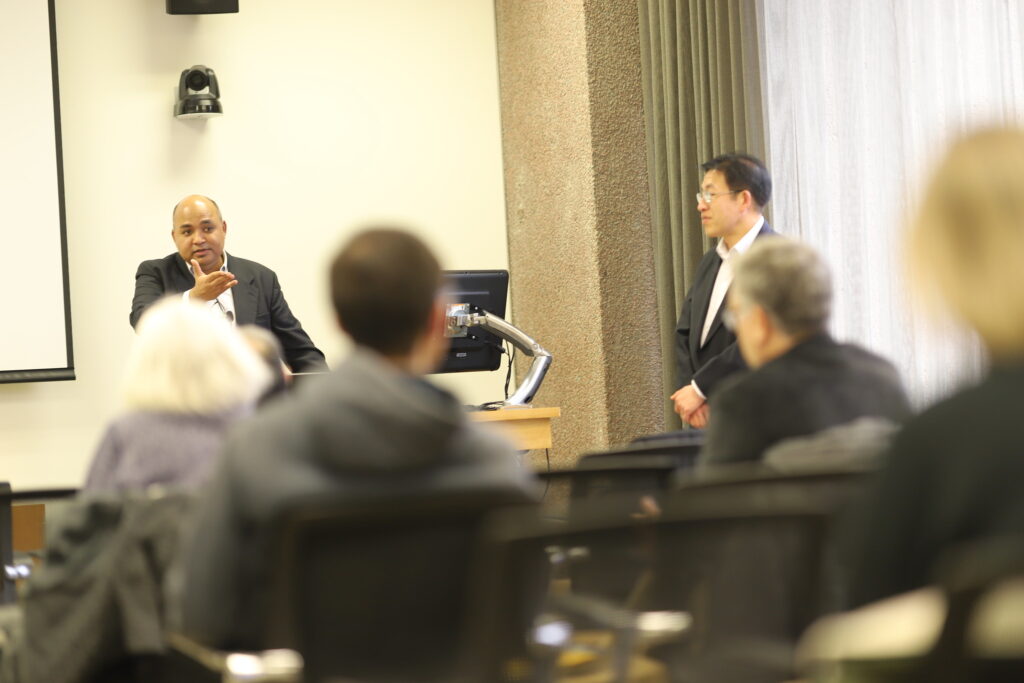
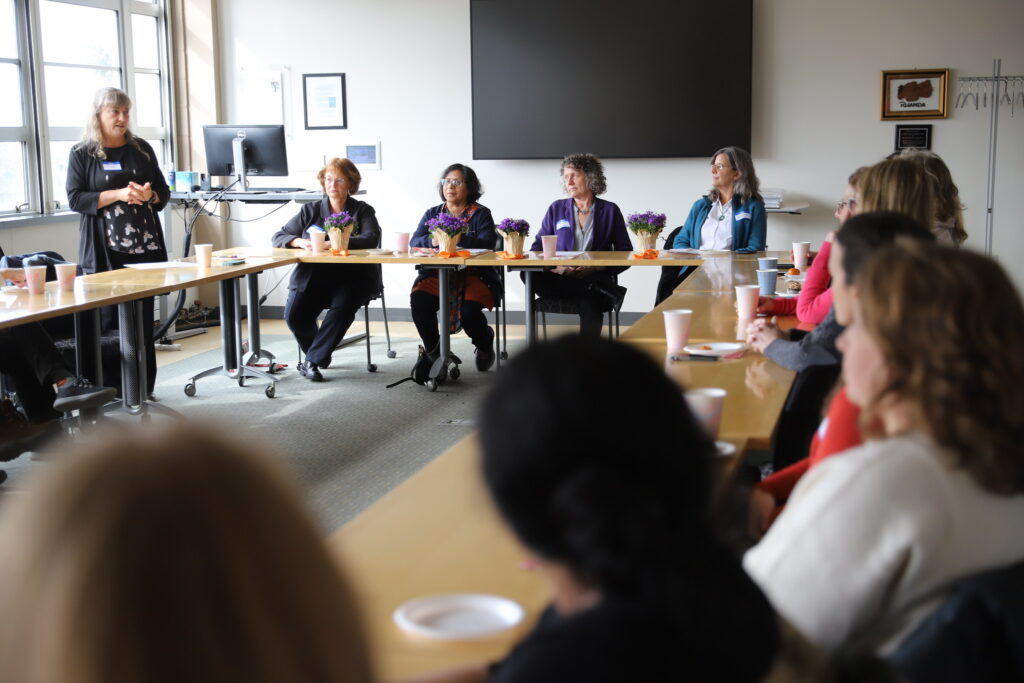

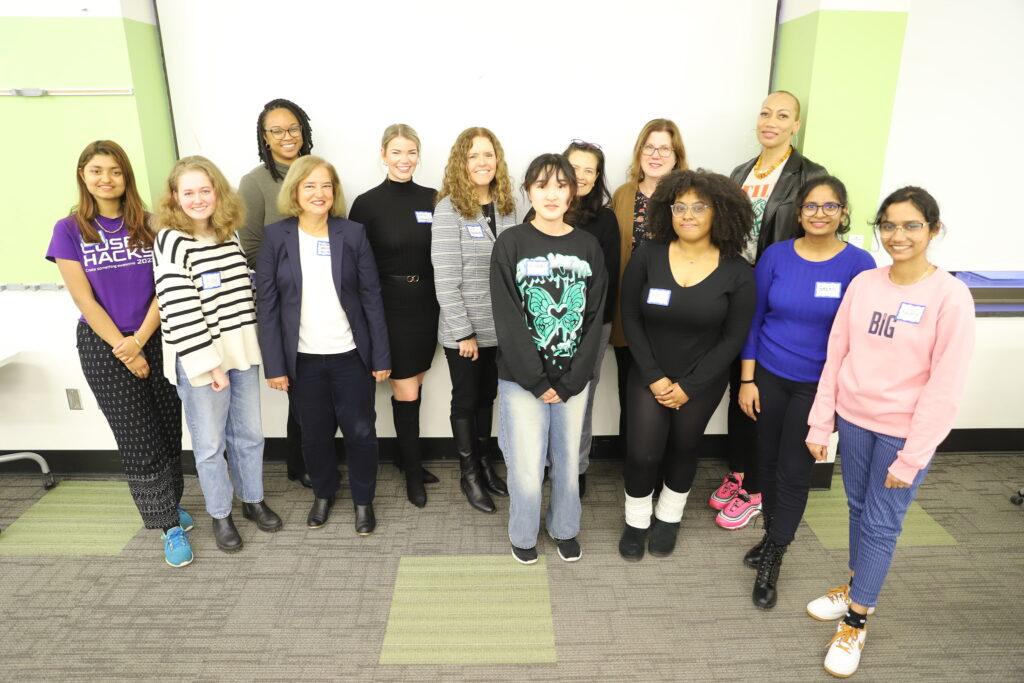

Lifelong Learning: Paul Ossenbruggen ‘63

When it comes to lifelong learning, there’s no better example than Paul Ossenbruggen ‘63. With several decades of experience as a professor, and an engineering career spanning over 40 years, he continues to publish new research papers to this day. However, the journey towards settling into his teaching role took some time. With so many different things he enjoyed learning, it made choosing a specific career difficult.
“I never seem to settle in anything. Some people got involved with one thing and that’s what they do,” he says. “That’s not me – I jump around from one thing to the next.”
Graduating from Brooklyn Tech High School in 1959, Ossenbruggen was uncertain about his career path. Though he began studying civil engineering at Syracuse University, he remained open to exploring other options. At one point, he even considered becoming an airline pilot. It was only during his internship at an energy technology company, Babcock and Wilcox, that he finally discovered his passion for nuclear engineering.
“Babcock and Wilcox make huge boilers,” he says. “Even though I was a civil engineering student, I was getting more involved with nuclear engineering. It was challenging but interesting and I loved every second of it.”
After completing his undergraduate studies at Syracuse in 1963, he continued pursuing his interest in nuclear engineering when working at General Dynamics Electric Boat, where he helped build nuclear submarines. Yet, a part of him wanted to continue learning and exploring other options.
“I loved my job at Electric Boat. They designed and constructed the first nuclear-powered submarine, the U.S.S. Nautilus,” he says. “But I felt there was so much more I wanted to learn so I decided to go to grad school at the University of Connecticut in 1967 and later Carnegie Mellon University for my Ph.D. in 1970. I like learning new things.”
Initially planning to return to Electric Boat, Ossenbruggen became interested in higher education and decided to pursue teaching instead. He began teaching at Northeastern University in Boston, and later in 1975, he moved to the University of New Hampshire where he taught for 34 years. He also taught at the University of California, Berkeley from 2000-2003.
Teaching not only allowed him to mentor and guide students but also explore new engineering concepts, which he found fulfilling. During his tenure as a professor, he also wrote a textbook in 1984 titled “Systems Analysis for Civil Engineers.” The book combined the fundamentals of engineering economics and civil engineering systems and garnered critical acclaim at the time of its publication. It was also translated into Chinese.
“It was a cutting-edge book. Civil engineers didn’t usually write this kind of textbook,” he says. “And one of the great things about it is that it’s still being read to this day.”
Nowadays, Ossenbruggen has settled down, returning to Syracuse where he sees a bright future for the University and the city. He’s been particularly excited about Micron’s plans to invest an estimated $100 billion into Central New York as well as the community grid in downtown Syracuse.
“I’m excited to be in Syracuse now to see this transformation happen. Micron is going make a big difference,” he says. “I’ve been to every meeting, and it looks promising to me. This area turned into a rust belt but hopefully, it’ll become stainless steel.”
Ossenbruggen also looks forward to the Operations Research and System Analytics Master’s Program, which he believes will bring immersive learning to the college’s forefront and fuel students’ passion for learning and discovery.
“I’ve been interested in operations research since I was a grad student at Carnegie Mellon. It had just got off the ground when I was completing my Ph.D. I even proposed a similar course while I was at the University of New Hampshire.
“I’m glad ECS is committed to introducing this program. It’s interdisciplinary, which I like very much. The course selection is great and offers a nice variety of courses that can be tailored to meet a student’s interests. Syracuse University is in a great position.”
Get to Know Our New Graduate and Global Career Advisor Britton Inglehart
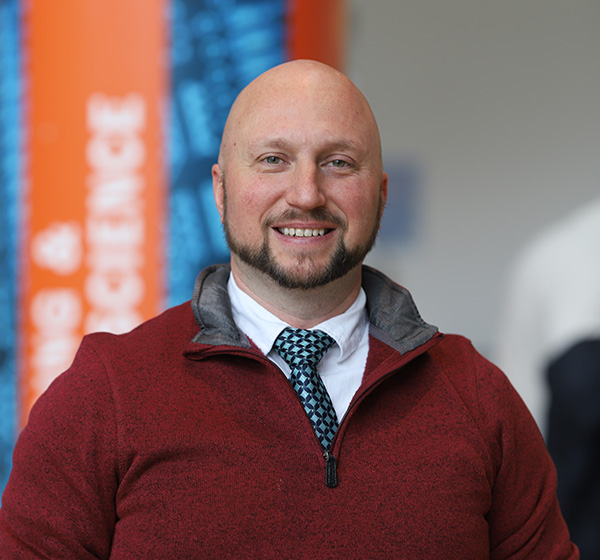
From teaching in South Korea to academic advising in the U.S. Army, Britton Inglehart brings diverse experiences to his new role as the College of Engineering and Computer Science’s Graduate and Global Career Advisor. In this Q&A session, Inglehart discusses his responsibilities, his vision for the future, and advice to students on how to make the most of their college experience.
Tell us about yourself and what brought you to Syracuse University
I’m from Wellesley Island, New York, which is about an hour and a half north of here and right on the Canadian border. The area is nice, but career opportunities are not unless you’re in the trades. My eyes were always on what else is out in the world. High school and college opened up my eyes to the world around me. I started learning Japanese, became an ESL tutor and this started my career.
I went abroad to teach in South Korea and China, leaving in 2008 and returning in 2019. Then, I worked for the US Army Education Center as an academic advisor, which is how I got into higher education. I just finished my master’s at Nazareth College and came here to Syracuse to wrap it all up into one neat, nice bow. This position fits all my experience into one role.
What is the role of the Graduate and Global Career Advisor?
This is a brand-new position so I’m building it up as I go. Currently, the main focus has been helping my students build their resumes, really diving into what they need. However, I always emphasize to them that resumes are only part of what they need to be successful.
Another big thing I’m working on with students is networking, branching out, and being open to finding roles and professionals online to connect. I’ll show them how to combine Handshake, LinkedIn, and Indeed to build up their confidence, know what they’re looking for, and go in with a broader scope.
What are you most excited about in your role and what’s your favorite part?
I’m really excited about building up a database for international students. Some international students are having a hard time finding employment. Helping them out with CPT and OPT, getting in touch with employers about visa sponsorship, and guiding students to find the right people to go to are priorities.
My favorite part is the one-on-one with students. It’s one of the reasons I decided to get into higher education. Teaching was great, and I loved it but sometimes it’s hard to help everyone. With this role, I can see a lot more progression and growth. It’s very rewarding to see this in students. [Students repeatedly come back to my office] and this shows me that the discussions I’m having with them are beneficial.
What advice do you have for students?
Don’t stress about the future right now. It’s okay to think and start planning but don’t let that prospect get in the way. In rowing, one of my favorite pastimes, you’re always looking at where you were. You don’t know what’s ahead. It’s more important to figure out what you’re doing currently and how to do that well so that the future is ready. Get your resumes ready, pass your classes, and build experience.
What are some things you like to do for fun?
I like to go to the gym, and I enjoy rowing. I’m hoping to join Cazenovia’s team so that I can utilize this area for that. I also read and write. I’m currently working on a fiction series influenced by D&D (Dungeons and Dragons). Not sure if it will ever get anywhere, but it’s something I like to do.
I also play video games. I’m big into the Final Fantasy series, which I grew up with. I also like Ghost of Tsushima, God of War, Legend of Zelda and Myst.
AIAA at Syracuse University is Reaching New Heights
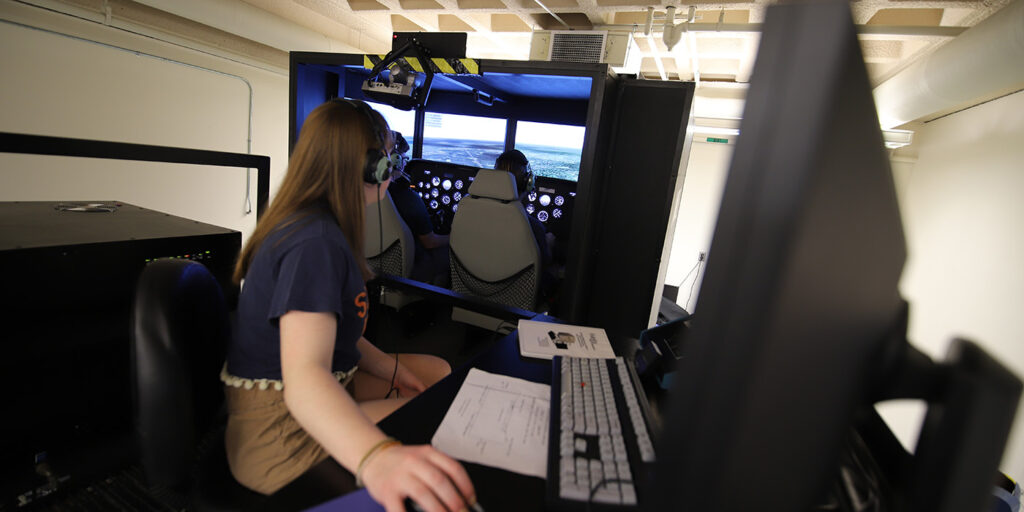
“How do we bring people from different majors together to create a collective community?” This question led the Syracuse chapter of the American Institute of Aeronautics and Astronautics (AIAA) to explore new ways to forge relationships with the broader campus community. As the student organization welcomes new E-board members, they seek to strengthen bonds within the group’s membership and create a welcoming environment for all to join.
“People in engineering typically meet other engineers – architects stay in Slocum Hall, engineers stay in Link Hall,” says vice president Theodore Todorov ’26. “We’re looking for ways to form new connections and bring people together.”
Founded in 1963, the AIAA aims to shape the future of aerospace through ingenuity and innovation while supporting aerospace professionals to succeed in their careers. The Syracuse University chapter of AIAA contributes to this mission by hosting review sessions. These sessions cover primary engineering and higher-level aerospace courses, and club members can request specific topics to study.
As a first-year student, Todorov loved being part of the club since he got to interact with other like-minded individuals. However, he noticed some aerospace engineering students he knew didn’t attend these meetings. Though the club was also open to non-engineering students, they also weren’t coming to meetings. When appointed as the club’s vice president, Todorov started thinking about ways to encourage more aerospace engineering and non-engineering students to join the club.
“We wanted to branch out more,” he says. “We thought ‘How can we change that? How can we make our club more social?’”
Breaking away from their usual meeting agenda, the club hosted an ice cream social to allow students to connect and relax. To their surprise, several students showed up, eager to mingle and fill their stomachs. This positive response prompted the e-Board to continue hosting more social events that allowed students to have fun.
After the successful ice cream social, the AIAA has decided to host bigger social events in the future. They plan to organize the STEM Olympics, which will involve a campus-wide scavenger hunt. The scavenger hunt would feature clues related to different programs such as biology, chemistry, and engineering. This event will also have prizes, and yard games and will take place before midterms so that students can unwind before their exams.
“The idea is when people go to make their teams, they would select people from other majors or programs to have a better chance at solving clues,” says Todorov. “This is one of the best ways we can have students from different majors meet.”
Todorov has been playing a leading role in organizing this event, in addition to assisting with review sessions and other duties related to the vice-president position. The e-Board has much more planned and is eagerly looking forward to students seeing what’s in store. They envision a bright future for the Syracuse chapter of the AIAA, not only as support for the future of aerospace engineering but also as a social club where people can connect.
“I saw potential for the club when I joined my freshman year and I believed AIAA could be so much more,” Todorov says. “We want to make a big impact and are excited to see where it will go next.”
Looking to join or partner with AIAA? Click here to get connected!
Reach out to aiaa@syr.edu or tdtodoro@syr.edu for more information about AIAA review sessions and events
Electrical Engineering and Computer Science Professor Younes Radi Appointed as Senior Member and Associate Editor of IEEE
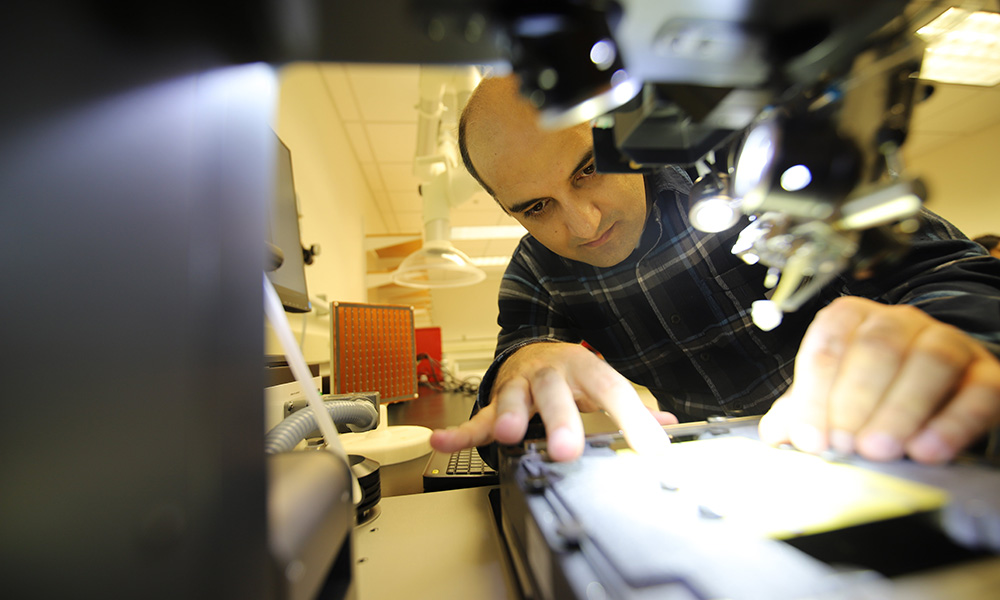
Younes Radi, assistant professor in electrical engineering and computer science, has been recognized as a Senior Member of the Institute of Electrical and Electronics Engineers (IEEE) for his contributions to research in applied electromagnetics and microwave engineering. He has also been chosen as an Associate Editor for the IEEE Transactions on Antennas and Propagation.
The IEEE is a global organization devoted to advancing technology for humanity’s benefit. Senior Membership is awarded to members who have made a significant impact within their fields. Only 10% of the IEEE’s more than 400,000 members hold this grade, which requires extensive experience, professional maturity, and documented achievements of significance.
Radi’s research focuses on the physics of fields and waves, with emphasis on tailoring electromagnetic wave-matter interaction. He has made significant scientific contributions on a broad range of topics in theoretical and applied electromagnetics, optics, and photonics, including artificial electronic and photonic materials, RF/microwave circuits, antennas, and propagation. His papers have been published in several high-impact journals including Nature Physics, Nature Communications, National Science Foundation, and IEEE family journals.
In addition to his Senior Membership and becoming an Associate Editor at IEEE Transactions on Antennas and Propagation, Radi has also been chosen by the University as one of the two faculty to compete in the 2024 Moore Inventor Fellows Program. These recent achievements reflect Radi’s focused efforts to re-establish Syracuse University as a renowned center of electromagnetics and microwave engineering research.
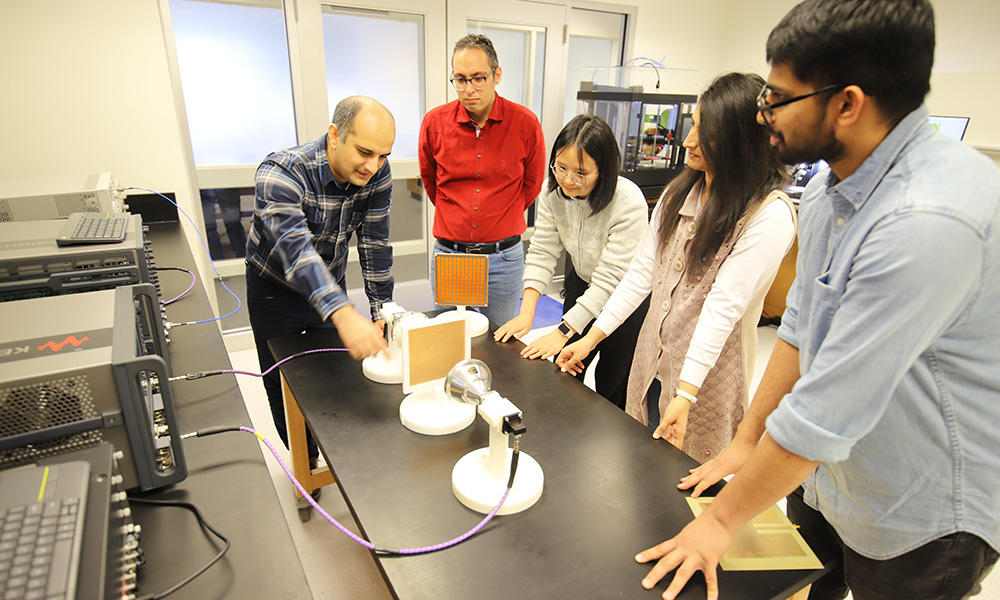
“Syracuse University has a rich history in applied electromagnetics and microwave engineering and was one of the leading universities in the world in this field,” says Radi. “I’ve been to many places in Europe and the US and have never seen a city like Syracuse where you can find so many high-end companies in applied electromagnetics and microwave engineering. This creates a great platform to bridge the research in my team with the local industry.
“I am extremely grateful to the department, college, and also the office of VPR for their amazing support in establishing a state-of-the-art RF and mm-Wave laboratory, which we have named ‘RadLab.’ This facility will pave the way for new collaborations with local industry and position Syracuse as a highly active hub for advanced research in applied electromagnetics and microwave engineering.”
Biomedical and Chemical Engineering Professor Mary Beth Monroe Receives Young Investigator Award from the Society for Biomaterials
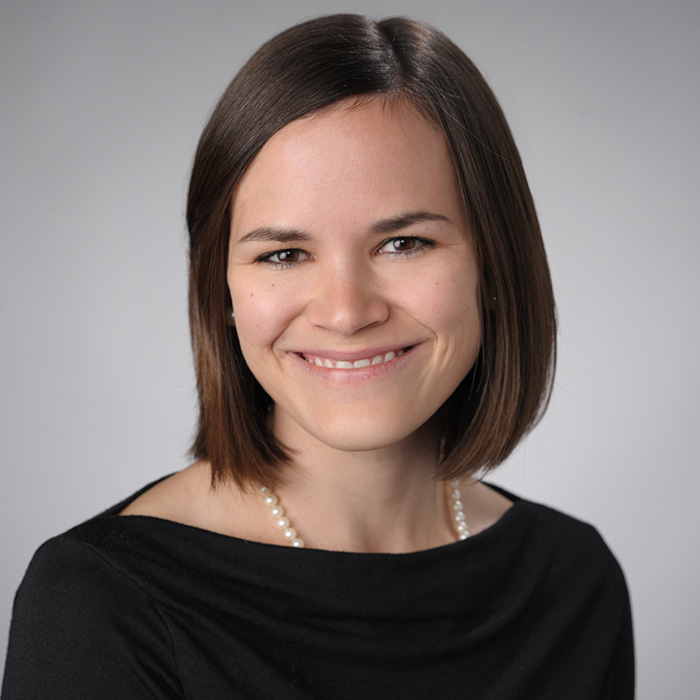
Assistant professor in biomedical and chemical engineering Mary Beth Monroe has received the Young Investigator Award from the Society For Biomaterials. This award recognizes an individual who has demonstrated outstanding achievements in biomaterials research.
The Society For Biomaterials is a group of multidisciplinary professionals from various fields including academia, healthcare, government, and business. They aim to advance biomaterial science and education to improve professional standards for human health while promoting excellence in biomaterial science, engineering, and technology.
Monroe’s research is focused on engineering new biomaterials to address clinical needs in wound healing. Seeking to make significant strides in polymer chemistry to facilitate safer, more efficient medical devices, her biomaterials lab conducts basic and applied research to produce and analyze polymeric biomaterials that enhance healing outcomes.
“Dr. Monroe is off to a fantastic start as a junior faculty member, and she brings tremendous creativity, energy, and enthusiasm to her research lab, teaching, mentorship activities, and service efforts. We expect her to continue to lead in these areas and to excel as a biomaterials scholar as she inspires those around her to lead as well,” says the SFB BioInterfaces Special Interest Group Awards Committee, Ashley Brown, Benjamin Keselowsky, and Christopher Siedlecki.
“I have been engaged with SFB since my first semester of graduate school,” says Monroe. “It is a huge honor to be recognized by this scientific society that has had such a huge impact on my career by providing me with mentors, collaborators, and an outlet for scientific inquiry over the past 10+ years.”
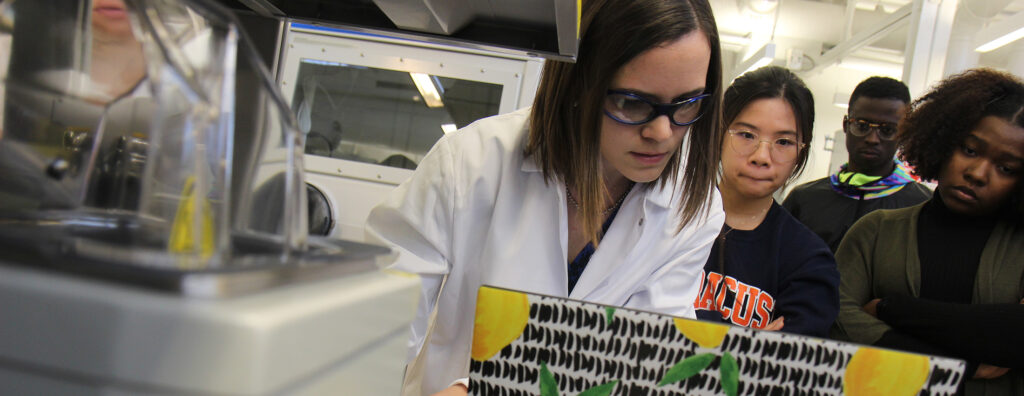
New-Fashioned Sustainability

Fast fashion may seem affordable, but its true cost goes beyond the price tags on clothing. The industry’s unsustainable, unethical practices have negatively impacted the environment and its current lack of government regulations has allowed these practices to run rampant around the globe. Despite the dominance of cheap, quick clothing production among modern retailers, Syracuse University biomedical engineering alumna Alexis Peña ’16, and her colleague, Lauren Blake, are determined to revolutionize the textile industry with their start-up, Good Fibes.
“Since summer 2022, Lauren and I have embarked on understanding the fashion industry ecosystem to provide innovative solutions for the current challenges,” says Peña. “At Good Fibes, we’re developing methods for biomanufacturing natural textile fibers using biological building blocks. Our mission is to enable a circular textile economy through material innovation.”
The biotech startup aims to produce lab-grown fibers through cellular agriculture and use engineered molecules to create renewable, biodegradable, and non-toxic fibers. They hope this will offer alternatives to synthetic fibers such as polyester, which currently make up over 50% of clothing material. Synthetic fibers can also take hundreds of years to degrade and shed microplastics and chemical pollutants into the environment.
Though fibers like cotton, silk, or wool are natural fibers, their production processes don’t align with sustainability goals or meet the industry’s needs. Cotton processing demands extensive amounts of water and silk production requires a considerable amount of energy. Wool products may also contain harsh chemicals and dyes that make them less biodegradable.
Natural materials can also be unpredictable in supply due to weather, humidity, animal diet, or plant soil, which can cause variations in harvest seasons and batch-to-batch quality. Additionally, the industry faces challenges related to performance criteria and variability in quality, which ultimately leads to a reliance on synthetic fibers.
Good Fibes’ bioengineered fibers solve these issues by providing environmentally conscious production and better-quality materials compared to current synthetic textiles.
“The lack of reliable alternatives to synthetic fibers is a major pain point in the textile industry. Our bioengineered fibers not only provide an alternative to petroleum-based fibers but also address limitations of cotton, silk, and wool by having year-round production and tunable properties such as elasticity, tensile strength, and dye affinity” says Peña.
Peña and Blake recently completed their Ph. Ds in May 2023 at Johns Hopkins University. The co-founders also taught a course called “Future Fashion Innovation” to material scientists and engineering undergraduates at Hopkins during intersession and adapted the course into a webinar for Johns Hopkins School of Medicine alumni during Earth Week in 2023.

Additionally, Good Fibes has been selected as a participant in a lab-embedded entrepreneurship program (LEEP), Chain Reaction Innovations (CRI) program at Argonne National Laboratory. The CRI program is designed to support entrepreneurs and their innovative research with a focus on clean energy.
“Fashion should allow people to feel good about their clothing but also feel good about what happens to their clothing after they wear it,” says Peña. “We believe this can truly innovate the textile industry and bring a much-needed change to fashion’s monolithic infrastructure.”
Jae Oh and Michelle Blum Named as Associate Deans for the College of Engineering and Computer Science
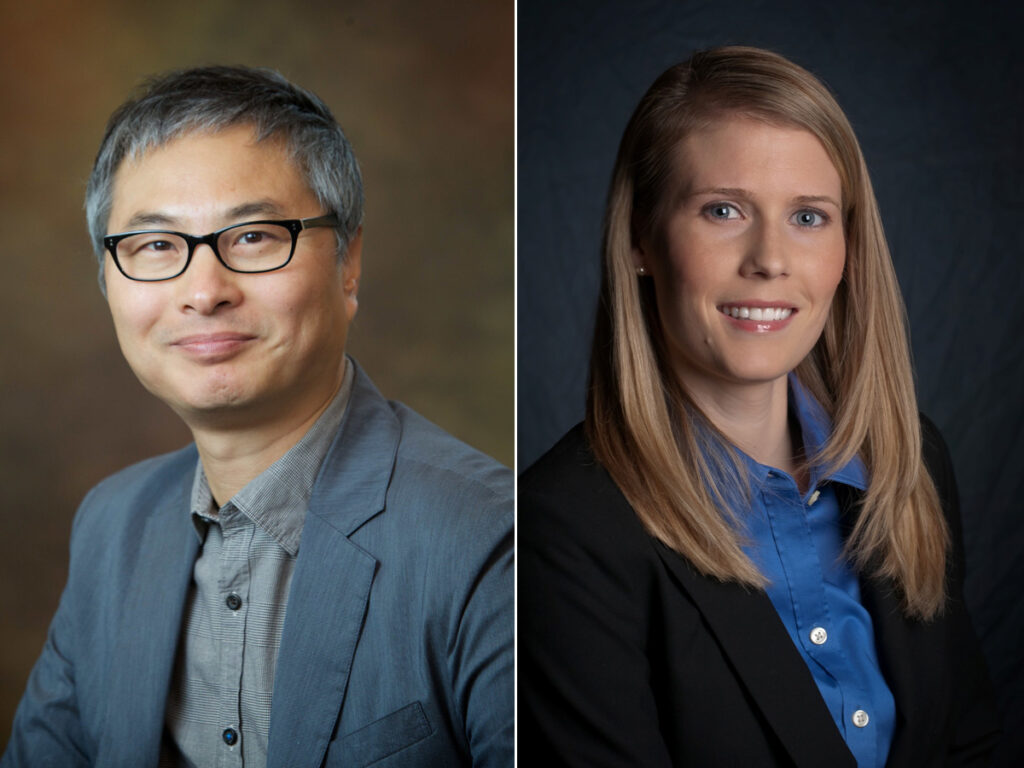
The College of Engineering and Computer Science (ECS) has named Jae C. Oh as Senior Associate Dean for Faculty Affairs and Academic Initiatives and Michelle Blum as Associate Dean for Student Affairs.
Oh is the David G. Edelstein Professor for Broadening Participation in the Department of Electrical Engineering and Computer Science (EECS) and served as the Chair of EECS for the last six years. He’s also been recognized with the Distinguished Scholar Award from the International Society of Applied Intelligence. He’s dedicated his efforts toward helping organize ECS resources to achieve the goals that pertain to diversity, equity, inclusion, and accessibility, and seeks to broaden participation throughout the College, especially in the Ph.D. program.
“I feel deeply honored to serve the faculty, staff, and students at ECS in my new role. I want to thank all the EECS faculty and staff for their support during my six-year tenure as the EECS Chair. I am grateful to have the same supportive ECS community in my new role, which will require me to work closely with Dean Smith and the entire faculty and staff of ECS,” says Oh.
Blum serves as an associate teaching professor in the Department of Mechanical and Aerospace Engineering and has been a leader of ECS through her service as Undergraduate Program Director for Mechanical Engineering, and Dean’s Faculty Fellow for Assessment. She recently won the 2023 ASEE St. Lawrence Section Outstanding Teaching Award and works to help transform the educational and student support mission of the college. Supporting career initiatives and success programs, she seeks to find innovative ways to continue optimizing the student experience at ECS.
“As I step into the role of Associate Dean for Student Affairs in ECS, I am dedicated to being a service leader. I will make it my priority to foster a positive and inclusive college culture and ensure that all students have access to the resources they need to succeed,” says Blum.
Nature-Inspired Research
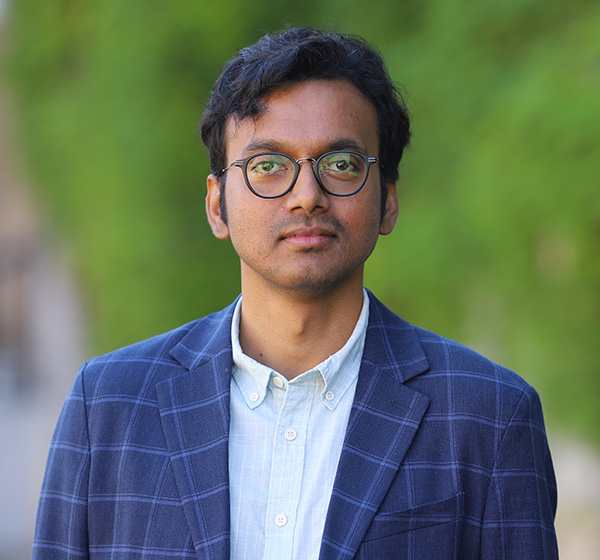
Apple snails are one of the most invasive species on our planet. Consuming several plants that provide food and habitats for various wildlife, and disrupting entire ecosystems, these snails have earned a permanent ban from the United States, only allowed in the country for research. Along with the damage they leave in their slow path of destruction, these shelled creatures also possess an ability that’s unique to their species.
By wiggling its flexible foot underwater, an apple snail can create a flow that brings floating food particles to itself, a process biologists refer to as “pedal foot collection.” Fascinated by the snail’s unique ability, this would inspire the latest research of a mechanical and aerospace engineering professor, Anupam Pandey, whose findings were published in the high-impact science journal Nature Communications.
“One of my research interests is understanding how soft, highly deformable, solid materials interact with adjacent liquid flow,” Pandey says. “Organisms that live underwater exploit this interaction for locomotion and feeding. Apple snails have evolved to leverage their proximity to the water-air interface to transport or pump liquids.”
To understand the process behind pedal foot collection, Pandey designed a robot the size of a centimeter that oscillates rhythmically and mimicked the apple snail’s motion. He then placed the robot underwater in a tank and sprinkled Styrofoam particles on the surface to see if it could collect it, discovering that the robot functioned similarly to a pump.
“We found that our bio-inspired robot was able to drag particles from distances that are five times its size. But more interestingly, we found an optimal speed at which pumping maximizes,” explains Pandey. “This optimal speed seemed to depend on robot geometry as well as the properties of the liquid it’s submerged in. Combining experiments and modeling, we predicted the optimal conditions under which the robot pumps the most liquid.”
In addition to understanding the role speed and liquid play in how the robot collects small objects and pumps liquid, Pandey also tracked the pattern of Styrofoam particle movement through long exposure photography, which he color-coded to make it easier to see how the particles moved.
While the small, oscillating robots have the potential for numerous applications, one notable benefit is as a collection device. Pandey believes that they could help address issues involving the collection of microplastics in oceans, which tend to remain at the water’s surface due to their small size.
Most plastic collection devices create strong disturbances at the water surface and cause microparticles to mix in the water. These microplastics travel to other water bodies, causing more plastic pollution which harms plants and animals and inevitably ends up in our food chain. However, devices like the undulating robot operate near the water’s surface with minimal interference and could potentially provide a solution to this problem.
“What’s great about this research is how interdisciplinary it is. Biologists may be interested in this, and it has several potential applications in engineering liquid flows at small scales, sensing and actuation of floating objects or even microplastics in water bodies,” Pandey says. “It will not only advance understanding of liquid transport near surfaces but lay the groundwork for future research as well.”

National Society of Black Engineers at Syracuse University: Building a Better Future
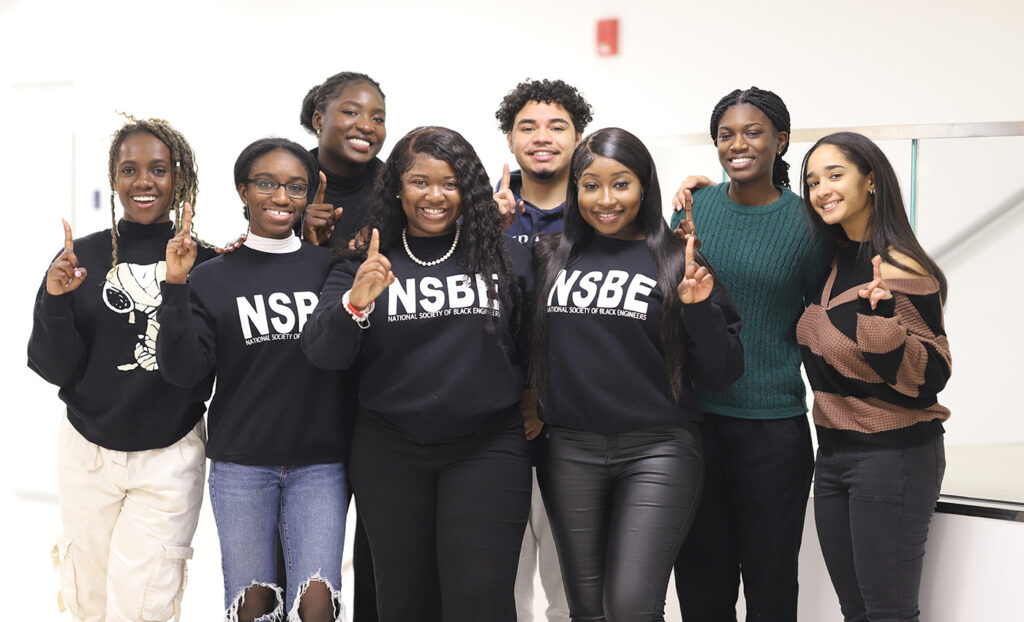
Under the leadership of Brianna Gillfillian ‘24, the National Society of Black Engineers (NSBE) at Syracuse University has experienced a resurgence. By organizing interactive events to bolster participation, NSBE has rebuilt a community of aspiring engineers post-pandemic. It may come as a surprise that Gillfillian never planned on becoming president. However, when she saw the leadership struggle to keep the organization together, she knew she had to do something.
“I saw ways we could impact numbers and participation,” Gilfillian says. “I wanted to be a part of the change that brought NSBE back to where they were before the pandemic. I thought I might as well give it a shot.”
Founded in 1974 at Purdue University, NSBE is an organization dedicated to developing culturally responsible Black engineers who excel academically and positively impact the community. The organization is open to all students and welcomes both engineering and non-engineering students. “Historically, the club was used to provide a space for Black engineers, who take up less than 4% of the industry,” Gillfillian says. “NSBE has been on a mission to increase the percentage of Black engineers over time.”
As Gillfillian attended meetings during her freshman year, she felt a sense of belonging to the club. It provided a safe space where older engineering students supported and mentored her, guiding her on her engineering journey. She would eventually serve as the membership and mentorship chair in her sophomore year, and in her junior year, she became the president of the club, a position she still holds to this day. With a hardworking e-board, Gilfillian wanted to restore the University’s NSBE chapter back to its former glory.
The pandemic impacted the club as they suffered from low participation, and Gillfillian knew the organization had to take action fast. She and the e-board organized interactive events such as NSBE Junior, a high school student outreach program aimed at inspiring young engineers to pursue STEM. NSBE Junior also provided volunteer opportunities for Syracuse students by allowing them to work with high schoolers, making it great for members passionate about teaching and working with the local youth.
“NSBE also has weekly study sessions called ‘I-Study.’ It’s basically tutoring with club members where students can ask us for help in academic areas they may struggle in,” Gillfillian says. “We also have a mentorship program that pairs younger students with older students so they can have a point of contact as they navigate the college.”
One of their biggest events, and also Gillfillian’s favorite, is the Black Excellence Gala, an event that commemorates student leaders and academic excellence. For the gala, they collaborate with the Black Honor Society and present awards to recognize the efforts of individuals within the student body. Students apply, get interviewed and the NSBE executive board votes on which student receives an award.
“To spice things up, we also have a People’s Choice Award where people are allowed to nominate Black-owned businesses, Black organizations and Black letter Greek organizations for different awards to acknowledge businesses or organizations doing well outside of academia,” Gillfillian says.
The student organization also participates in NSBE’s national and regional conferences, as well as AfroTech, the largest Black tech conference that attracts over 20,000 Black tech innovators for career and networking opportunities. However, a certain level of commitment to NSBE is required to attend these conferences. This is one way the leadership ensures that people who attend these conferences are genuinely involved with the group.
“Every single student who had the opportunity to attend AfroTech’s conference last year was able to secure both full-time jobs and summer internships,” Gillfillian says. “It’s great for students to advance their careers and grow professionally.”
Gillfillian is a highly involved college community member, holding four positions within student organizations and 10 leadership roles that are University-wide. Despite the busy schedule that comes with being a student organization president and a member of groups like the Kappa Lambda Chapter of Delta Sigma Theta Sorority Inc., she manages to balance her various roles and wouldn’t trade her role for anything else. Additionally, she greatly values the sense of community that the student organization provides. “I love the family-like structure. We’re a very tight-knit group and everyone is chill and close. We call ourselves NSBabes – it’s always a good time.”
With NSBE Junior, the Black Excellence Gala, and AfroTech, among other events, the organization is thriving more than ever. Even as Gillfillian graduates from the University next year, she believes the club will continue to be a safe space that motivates future innovators.
“NSBE is the best club to be. It’s great for ambitious young Black engineers and creates a lot of opportunities. People have gotten jobs, internships, made friends, developed their professional skills, and had a lot of fun while doing it.”
Looking to join or partner with NSBE? Click here to get connected!
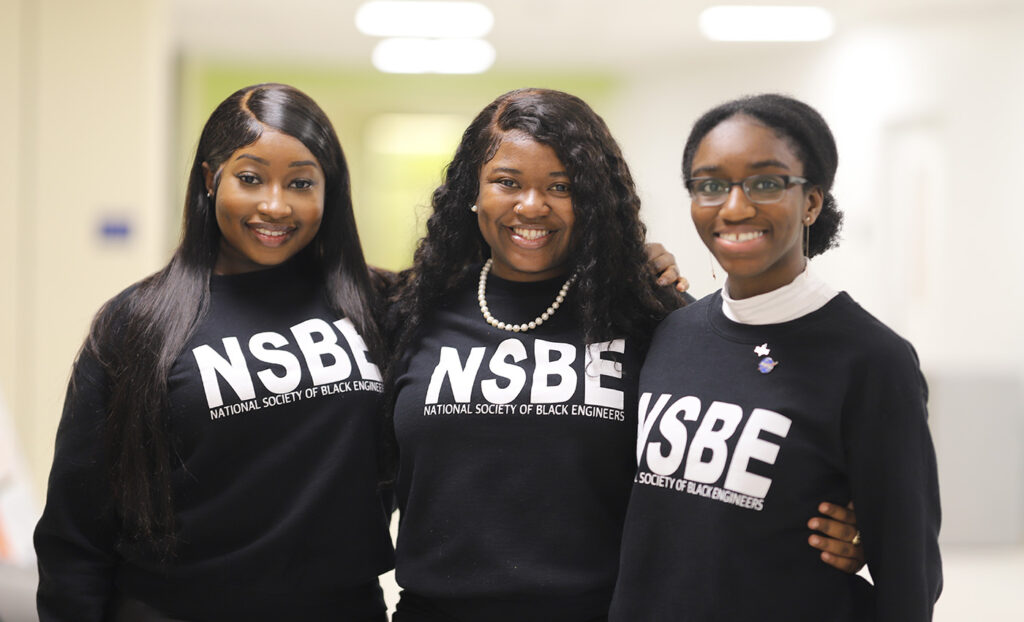
Electrical Engineering and Computer Science Professor Qinru Qiu Recognized as IEEE Fellow

Electrical engineering and computer science professor, Qinru Qiu, has been recognized as a Fellow of the Institute of Electrical and Electronics Engineers (IEEE) for her impactful contributions to the modeling and optimization of energy-efficient computing systems.
IEEE is a global organization that is committed to advancing technology for the betterment of humanity. With over 409,000 members in more than 160 countries, less than 0.1% of voting members are chosen for elevation to this member grade each year.
Qiu’s research interest focuses on improving the energy efficiency of computing, from runtime power and thermal management of computer systems, and energy harvesting real-time embedded systems, to her recent works in brain-inspired hardware and software for neuromorphic computing. The goal of her research is to provide machine intelligence to today’s computing platforms to achieve autonomous resource management with energy and thermal awareness and explore emerging computing paradigms.
“Professor Qiu has been leading the research community to seek solutions for highly energy-efficient machine intelligence through adopting biologically inspired models and processing mechanisms,” says nominator Diana Marculescu. “Her ground-breaking research has enabled a completely new computing paradigm, which leverages the unique property of different types of spike coding to replace the numerical calculation with simple logic operations, resulting in significant energy reduction.”
“I am excited and thankful for the recognition and truly grateful for all the support that I have received,” says Qiu. “I look forward to continuing my work in developing and promoting techniques to improve the energy efficiency of emerging computing systems.”
Celebrating Karen Davis’s Impact and Legacy

Karen Davis’s ’83, G’90 desire to create a welcoming environment for all has permeated every corner of the College of Engineering and Computer Science (ECS). Building the college’s career services from the ground up and becoming the Assistant Dean of Inclusive Excellence, her impact has been cemented into the college’s foundation. As she prepares to step down from her role, she leaves a lasting legacy that champions inclusion, community, and empowerment, inspiring hundreds of students to dream big and pursue their goals.
“People ask me, ‘What do you do?’” Davis says. “I tell them ‘Break barriers and build bridges.’”
Born and raised in the Bronx, New York, Davis loved the close, tight-knit community her neighborhood fostered, but wanted to see what was beyond her home borough. Her parents were rooted in their jobs and had no intentions of moving from the Bronx. “You did what you did, and you stayed where you were. That’s what my parents did. But I wanted to see what else was out there.”
This desire to see the world led her to attend Syracuse University during her undergraduate years. While she attended the University, she also worked full-time to support herself. Davis later realized that this experience was how she would connect with other students with similar backgrounds in her future role.
“There are students who come from where I come from. They are the first and only members of their family to pursue higher education. My experience allowed me to understand their mentality and when you get a sense of connection, these students can trust you.”
When Davis completed her undergraduate degree and MBA at Syracuse University, she received a job at UTC Carrier Corporation. With a background in computer science and programming languages, she would start in IT but eventually transition into HR where she oversaw diversity, equity, inclusion, and recruiting. This paved the way for her future career at Syracuse University.
After working at UTC for 15 years, Davis accepted the position of Director of Career Services at Syracuse and utilized her expertise from her previous work experience to build the program. She introduced the VMock resume platform to the University, expanded the career team by recruiting new staff, organized the first ECS career fair, and leveraged her network to provide students with job opportunities at companies like General Electric.
“When I was in career services, I used to call myself a matchmaker,” Davis says. “I would find the talent and the opportunity to make a match.”
Davis also assisted Senior Talent Acquisition Manager, Sharon Cole, on the CNY Works Program which aimed to provide inner-city youth with development skills to build future careers. During the summer, they had about 90 teens working in offices across campus, and they continued to lead this program for about 10 years.
“I wanted them to gain real experience and skills which could lead to new opportunities,” Davis says. “That’s what being involved with the community is. We are an extension of the community.”
Serving as Director of Career Services for 14 years, Davis would eventually become the Assistant Dean of Inclusive Excellence, where she also made a significant impact. Infusing diversity, equity, and inclusion into every aspect of the college, including education, research, and staffing, the Office of Inclusive Excellence also led student retention programs as well as training and education for faculty, staff and students. Davis also encouraged others to recognize that promoting inclusion is everyone’s responsibility.
“It’s our collective responsibility to foster an inclusive culture. From admissions to marketing, we must ensure it’s everyone’s mission to consider the needs of all students.”
One of Davis’s favorite aspects of her job has been the students, as she has been able to inspire and empower them to make a difference in their own lives and communities.
“Karen played an instrumental role during my development at SU,” says Asia Terry ‘12. “She encouraged me to step forward, to come out of my comfort zone, and to reach higher than I thought I could. I’m so grateful to have met Karen and for her presence in my formative years.”
“Karen was an important figure in my DEI journey since I was a freshman at Syracuse University,” says Shazif Shaikh ‘19. “She’s synonymous with warmth, compassion, kindness, and supportive in my world. She cares about the well-being and success of the people around her with actions taken to uplift them. I have been uplifted by Karen and have sought to do for others what she has done for me.”
As Davis makes her exit from the University, she believes Career Services and the Office of Inclusive Excellence will continue what she started and foster an environment where students, faculty and staff feel welcome and heard.
“It’s always been about impact. Students are the reason we’re here,” she says. “If you get the right message and it reaches the right people, it will grow. When you see it grow, that’s how you know that you’ve had a deep impact.”
Electrical Engineering and Computer Science Professor Yuzhe Tang Receives Grant to Protect Ethereum Security

Yuzhe Tang, associate professor of electrical engineering and computer science in the College of Engineering and Computer Science, and his research team have been awarded a grant by the Ethereum Foundation for research to advance the Ethereum blockchain ecosystem. This grant will support Tang and his Ph.D. students in designing, developing, and evaluating the security hardening code to protect the Ethereum network stack.
Ethereum is a network made up of several communities and toolsets that allow users to communicate or make transactions with digital money. Since the network is decentralized, users are in complete control of their data and what’s being shared, so they don’t need to give up any personal information – all users need to access Ethereum is an internet connection.
Denial of service security is critically important to the Ethereum blockchain ecosystem, and the research will explore ways to protect the Ethereum network from cyberattacks, involving systematic vulnerability discovery using applied formal methods. As cyber criminals attack networks like Ethereum and security concerns grow, Tang believes this research could have a lasting impact on the current landscape of cybersecurity and blockchain platforms.
“With this grant, we can help solve some of the most critical problems in the real world. We expect to continue developing code merged into Ethereum codebase,” Tang says. “I am most excited about making real-world impacts out of the research works from my group.”
Career Focused: Engineering and Computer Science Class of 2022 Reporting High Placement Rate
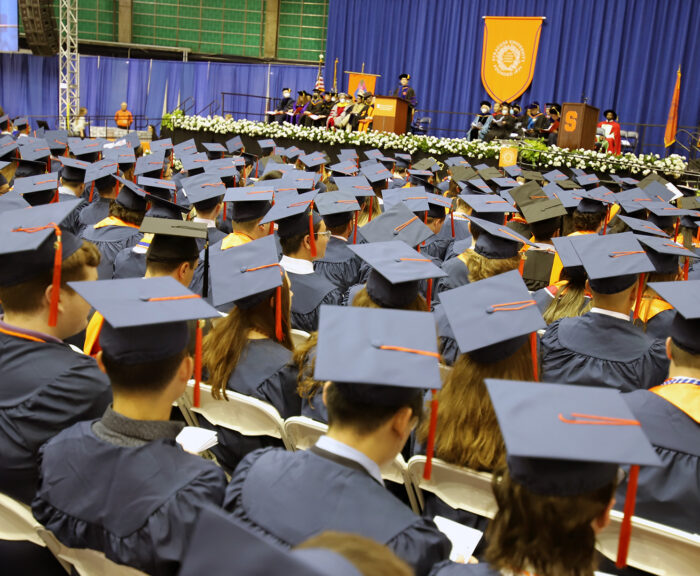
The starting salaries for graduates receiving a Bachelor of Science degree from the College of Engineering and Computer Science (ECS) has grown steadily for the last six years.
The average starting salary for the class of 2022 was $76,679. A total increase of $17,000 since 2016.
The placement rate for the class of 2022 was 93%. More than half of all graduates have started their careers and 33% are pursuing an advanced degree.
The ECS Career Services team provides students with support to reach their professional goals. They help students build their network with connections to industry leaders and alumni through information sessions, company tabling, career fairs, on-campus interviewing and more. Additional support through workshops, seminars, and drop-in advising ensures students have access to development opportunities that give them an edge in today’s job market.
Class of 2022 Top 25 Employers
- Applied Materials
- Boston Scientific
- Brainlab
- Bristol Myers Squibb
- Burns & McDonnell
- Carrier
- Deloitte
- General Dynamics, Electric Boat
- IBM
- Kimley-Horn
- L3Harris Technologies
- Lockheed Martin
- Meta
- Morningstar, Inc.
- National Grid Pfizer, Inc.
- Pratt & Whitney, a Raytheon Technologies Company (RTX)
- Qualcomm
- SRC, Inc
- The Boeing Company
- The Walt Disney Company
- Turner Construction Company
- Weston & Sampson
- Whiting-Turner Contracting Company
- WSP
Class of 2022 Graduate Schools
- Boston University
- Brown University
- Clarkson University
- Columbia University
- Cornell University
- Duke University
- Georgia Institute of Technology
- Icahn School of Medicine at Mount Sinai
- Northwestern University
- Princeton University
- SUNY Binghamton
- SUNY Stony Brook
- Syracuse University
- University North Carolina, Wilmington
- University of Maryland, College Park
- University of Michigan
- University of Minnesota
- University of Southern California
Data reflects information on 281 of 312 undergraduate degree recipients in 2022, representing a 90% knowledge rate.
Biomedical and Chemical Engineering Department Chair Julie Hasenwinkel Awarded Meredith Professorship
Biomedical and Chemical Engineering Department Chair Julie Hasenwinkel Awarded Meredith Professorship
Electrical Engineering and Computer Science Professor Kevin Du Receives “Test of Time” Award from the Computer Security Applications Conference
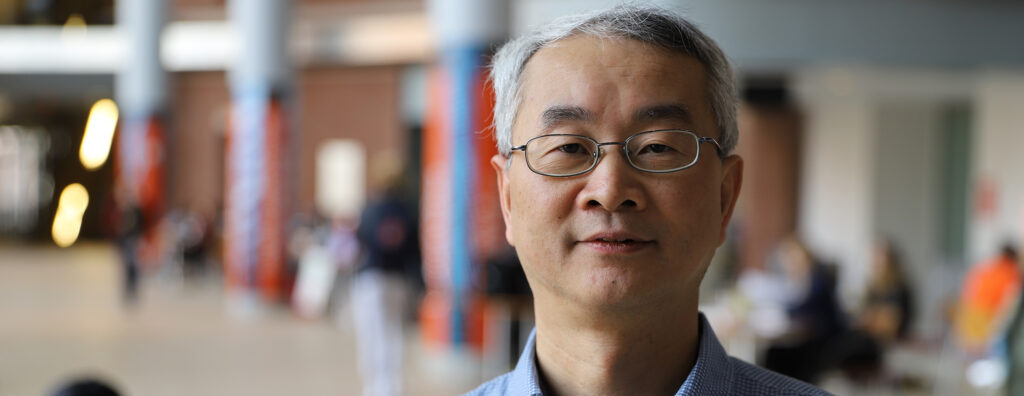
Electrical engineering and computer science Professor Kevin Du was awarded the Test of Time award at the 2021 Annual Computer Security Applications Conference (ACSAC) for his paper “Privacy-Preserving Cooperative Statistical Analysis” that was originally published in 2001.
“This paper provided a new way to conduct joint computation while protecting data privacy. There were a lot of follow-ups on this approach,” said Du. “Many young researchers told me that they ‘grew up’ reading my papers in this field.”
This is the second time Du has won a Test of Time award. He previously won one in 2013 at the ACM Conference on Computer and Communications Security for a paper titled “A Pairwise Pre-Distribution Scheme for Wireless Sensor Networks” he published with Professor Jing Deng, Professor Yunghsiang S. Han and Distinguished Professor Pramod Varshney in 2003.
